Teaching Reflections: Year 1 (2012-2013)
This blog post contains Amazon affiliate links. As an Amazon Associate, I earn a small commission from qualifying purchases.
Want to check out my favorite Amazon items for the classroom? Check out my Amazon favorites page!
In 2020, I transferred my blog from Blogger to a Self-Hosted WordPress site. I set out to clean up my over 1200 posts to create a more user-friendly and easily navigable site. I am slowly creating separate pages for each of the foldables and interactive notebook pages I have shared over the years. I also ran across many reflection-type posts I wrote during my first year of teaching. I have deleted the individual posts and compiled them here as a sort of series of snapshots of my journey as a brand-new high school math teacher.
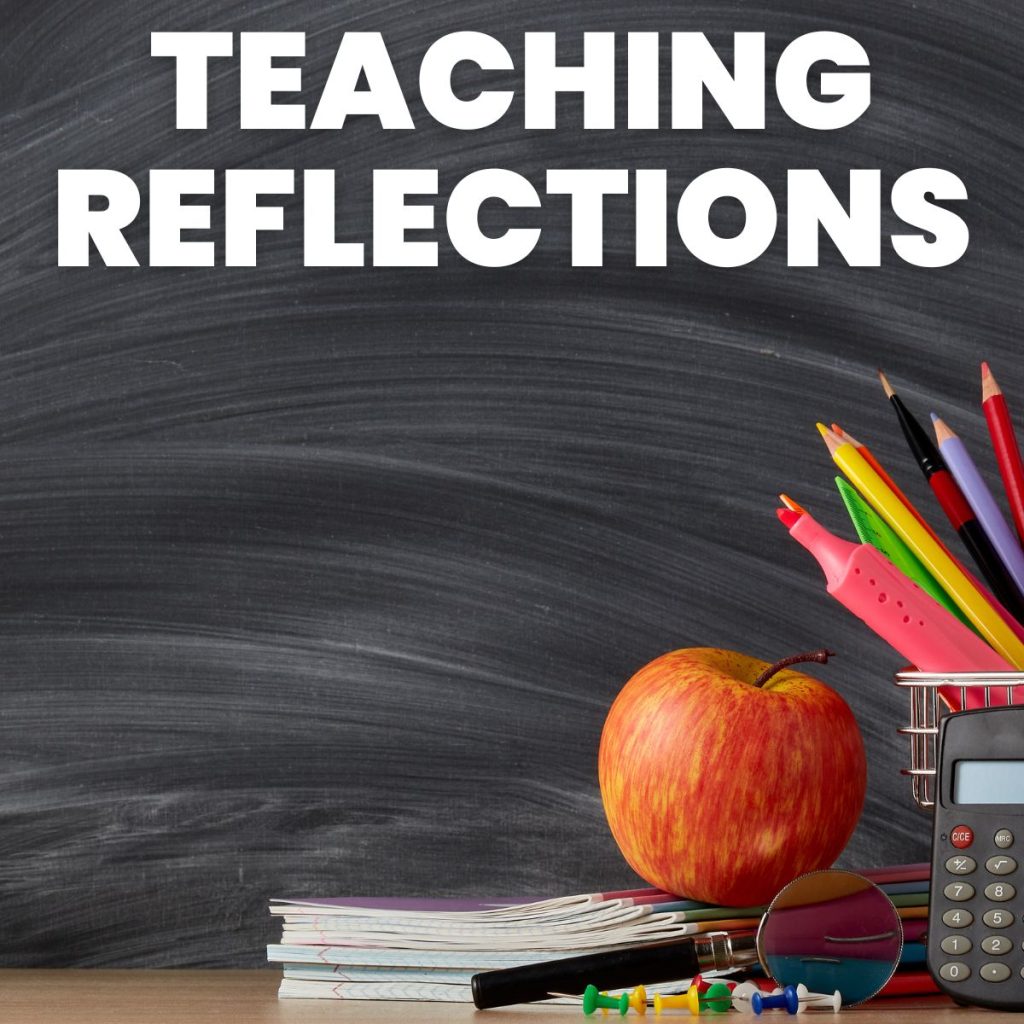
Aug 22, 2012 – Goals for the 2012-2013 School Year
Well, we’re four days into the school year now, and I’m still alive. I feel like I’m treading water. I’m trying my hardest not to drown. This is one of the hardest things I’ve ever done. It’s also one of the most rewarding things I’ve ever done.
A lot of the stress and craziness that has come with the start of school is just a result of my perfectionism and high standards for myself. I don’t want to teach the way I was taught. I know what I want my classroom to be like, and while it’s doable, it’s also time-consuming. I’ve been getting to school at 7 and not leaving until after 5. Then, I go home and do more school work. I’m pretty sure that the hours I’ve been keeping would qualify me as a workaholic.
Honestly, the first few days of school have been great. I have a great group of students. Problems with schedules have made these first few days a little more stressful than I would have liked, but the problems are being solved. I’ve gone from teaching 3 Algebra 2 classes and 2 Algebra 1 classes to teaching 1 Algebra 2 class and 4 Algebra 1 classes. I’m also teaching a College Algebra course, but that hasn’t changed any.
I’m really starting to wonder how all you amazing math teacher bloggers manage to find time to blog and tweet and teach and have a life. Since school has started, I’ve written half a blog post, not counting this one. Honestly, I would have put off writing this post a few more days if I hadn’t gotten the e-mail with the second week of prompts for the new blogger initiative.
So, this week, I want to write about two goals I have for this school year.
1. Implement Interactive Notebooks (INBs) in my Algebra 1 and Algebra 2 classes. From starting to work with these with my students, I can tell you they are a lot of work. I’ve spent hours creating pages, foldables, graphic organizers, and other exciting things. I think I use the paper chopper more than the rest of the teachers in the school combined. I never realized that gluing and taping and coloring and cutting could be so time-consuming, but, I’m already seeing the benefits. My students are more engaged. When they have created the foldable or filled in the graphic organizer, they are more apt to look back to it for help than if I had simply referenced the table or chart in the textbook. So far, my students love them.
2. Build relationships with my students. I teach in a small school. We have 150-160 students in 9-12. Everybody knows everybody. Except me. I’m not from this town. I’ve lived here a little less than a month. I know that a lot of my success as a teacher will depend on the relationships I develop with my students. They need to know that I am trustworthy. They need to know that I care.
I’ve been trying my hardest to learn all of my students’ names. Students are aware if their teachers know their names or not. I practice each morning as students enter my classroom. I try to greet each one by name. When I collect exit tickets at the door, I thank each one by name. When I walk around the room and check for understanding, I call each person by name.
I used Dan Meyer’s Who I Am sheet on the 2nd day of school, and the results I got from it were pretty amazing. As I learn more names and put names to faces, I want to keep reading back over these papers so I can have an idea of each students’ background. I also had each student write 3 goals for this school year and 3 goals for the future on the back of their Who I Am sheet. Some of their goals made me smile. Others made me want to cry.
Another thing I did to try to build a relationship with my students is to ask them to help me learn more about the town. I did this as an exit ticket on the 3rd day, and I asked each student to write down 3 suggestions of things I should do/visit/see/experience to truly get to know the town. I learned more about the town. Several students invited me to sporting events. Some great conversations were sparked.
I’m so thankful for my student teaching experience, but teaching in my own classroom is entirely different. Or, at least I am approaching it differently. During my student teaching, I made an effort to learn my students’ names. Some shared with me about their interests and activities. But, they were never really my students. I knew I would only be there for 8 weeks. They knew I would only be there for 8 weeks.
But, with my own classroom, it’s different. These are my students. I find myself so much more motivated to help ensure the success of each and every one of my students. I take notes about things I have found out about my students. I’m going to implement a seating chart in my 2nd period tomorrow. I’m doing it because my students need one in order to have an environment conducive to learning.
The decision making I found so hard to do during student teaching has become second nature. My days are filled with one decision after another. From hour to hour, I make decision to tweak things. I take out an introduction. I add an extra explanation. I learn from what has worked and what hasn’t worked. Every day is a learning process. With each lesson I teach, I learn how my students need information presented to them. Instead of focusing on what I should have done better, I focus on how to make my future lessons better and more effective. I learn from my mistakes. I am a teacher.
August 23, 2012 – Six Most Important Things
Six Most Important Things is a free daily to-do list printable that forces you to limit yourself to those tasks which will make the largest impact on your daily productivity.

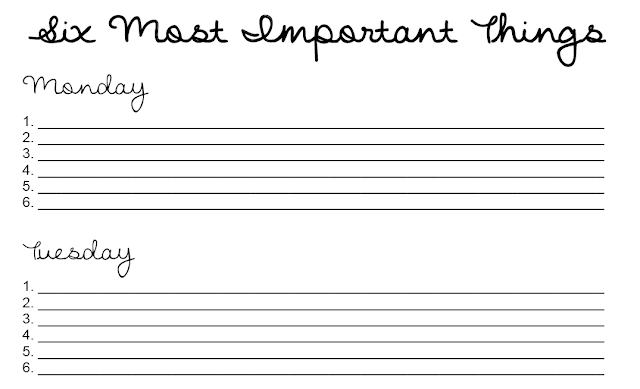
Free Download of Six Most Important Things Daily To Do List Printable
Six Most Important Things (PDF) (464 downloads )
August 24, 2012 – A Good and Frustrating Day
Well, today has had some really high moments and some really low moments. Before I head off to bed, I want to take a moment to reflect on today. I’ve been terrible at blogging since school started. I think it’s my perfectionism. I have an idea of what I want my blog posts to be like. Creative. Full of pictures. Reflective.
And, honestly, I don’t have time for all those things right now. I’m trying to figure out how to manage my first year of teaching and 3 preps. Plus, I’m the Student Council Sponsor, National Honor Society Sponsor, and Freshman Class Sponsor. I don’t really know what I’m doing. I’m just making it up as I go and hoping that I don’t drown.
So, I’m just going to record this in all its imperfection.
Highlights of Day 6
– They installed my new projector today after school. So, tomorrow, I can use my Smart Board and document camera! This is going to make the process of showing students where I want things glued in their INBs so much easier!
– The superintendent stopped by my classroom today. He knocked on the door and asked me to step out in the hall for a moment while I was teaching class. One of my 8th graders had been telling him how much he and the other students loved the new math teacher on the way back from the football scrimmage. So, he just wanted to tell me that and let me know that I was doing a great job.
Frustrations of Day 6
– The schedule and my class rosters are still changing. I was originally teaching 3 classes of Algebra 2. However, I had one class with one student and one class with two students. So, they combined my three Algebra 2 classes into 1 class and added two new Algebra 1 classes.
But, then one of my Algebra 1 classes only had 3 students in it. So, they cancelled my Algebra 1 class and moved those students into the Algebra 1 class across the hall. But, today, they decided to take the class across the hall and split it. So, I will teach half the students, and the other teacher will teach the other half.
So, tomorrow, I will meet 9 new students. (I’ll actually have 10 students in my class, but one student was previously in my class of 3.) I don’t know how to get these students caught up with the INB because the other teacher is not using INBs. They won’t have composition notebooks. And, I don’t really have time to wait for them to come up with a composition notebook. I need to keep moving ahead in order to keep all 4 of my Algebra 1 classes at the same point.
– I need to figure out a different way to approach my College Algebra / Math Analysis class. I came in assuming that this was going to be an advanced math class. These students have already taken Algebra 2. So, this class is an elective for them. However, from teaching them this week, I’ve discovered that topics I assumed would be a review are topics I need to teach in depth.
These students are struggling with adding fractions, graphing inequalities, and exponent rules. Tomorrow, half of this class (There are only 7 students) will be gone for softball. So, I need to come up with a plan this weekend for how I want to approach this class from this point forward.
August 25, 2012 – A Very Good Day
Well, after Thursday’s post about the good and not so good, I knew I had to post an update about how Friday went. Let’s just say it was marvelous. I’m still overwhelmed by student council responsibilities, but I will start dealing with those on Monday. I need to get my lesson plans and everything else ready for next week before I start stressing over student council. My students need to come first.
So, Friday was an amazing day. I left school feeling energized and excited to plan next week’s lessons. What made it so great? My students. I had at least three different students tell me yesterday how much they were enjoying my math class.
In my 3rd hour Algebra 1 class, I had a student raise his hand during the middle of the lesson. I assumed he had a question. No. He just wanted to say “You make math fun.”
In my 6th hour Algebra 1 class, I had one student just start telling everyone how much she loved this class and that she was learning so much more than last year. This led to another student informing me that this was his favorite class.
I don’t think my students realized just how much I needed to hear those comments. I didn’t ask for compliments or feedback. They just felt compelled to give them. My students are loving the INBs. Sure, some of them make remarks about how all the coloring, gluing, and cutting is like kindergarten, but I think they all secretly enjoy it. And, I’ve noticed that when students create the table/foldable/graphic organizer in their interactive notebooks, they are so much more likely to refer back to it than if I had just referenced it in the textbook.
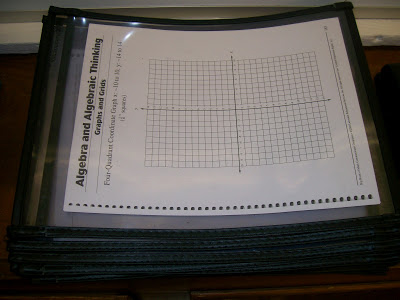
I’ve been using the individual dry erase pockets, and I think they have made a major difference in my students’ attitudes about math. Maybe I shouldn’t admit this, but I’m not a fan of math homework. I attended a high school where very few students did their own math homework. A few students would do theirs and then answers would be copied from student to student. No learning was occurring. Only copying. Then, I student taught at a school where students didn’t do their homework. The school allowed students to turn in late work at any time without a penalty. So, the students were typically 3-4 weeks behind in doing their homework, if they did it at all.
Instead of assigning homework problems, I’ve been giving my students the problems that would normally have been homework to do on their dry erase pockets. I read a question or put it up on the Smart Board. Each student works the problem and holds up their solution. I say yes or no. If they got it wrong, they look back over their work. The students that got it right start helping those others setting at their table.
I love having my desks arranged like this! It’s perfect for encouraging students to communicate and discuss the problems we are working on.

My students love it. They actually look forward to working the practice problems. That sounds crazy, right? Students looking forward to doing math problems. But, it’s entirely true. And, I think I’ve figured out why. Most of my students have traditionally struggled with math. They haven’t been successful before. Math leaves them feeling frustrated. When I give my students 10-15 practice problems, what I’m actually giving them is 10-15 chances to leave class today feeling like a success. To the students that understand the lesson from the beginning, they leave my class feeling like a math super star. To the students that don’t understand at first but start to get it through lots of practice and help from their classmates, they leave my class each day feeling like they’ve got this.
Every student is engaged. Every student works every problem. We work problems until the bell rings. I try to ensure that no time is wasted at the end of class. My students don’t have homework. I don’t have piles of homework papers to grade. And, there’s just something about that dry erase marker that makes my students more apt to try a problem that they aren’t entirely sure how to solve.
Teaching with interactive notebooks and dry erase pockets makes me love my job. I’m moving through the sections a tad slower than the other math teacher, but I think it’s worth it. I’m building a strong foundation for my students that will pay off for the rest of their mathematical careers.
I’m able to give my students instantaneous feedback. They don’t solve 20 homework problems and wait a day or two to figure out if they really understood how to solve those types of problems. By then, they don’t really care. Each time my students finish a problem, they want to know immediately if they got it right or not. If not, they are anxious to find their mistake. They want to hear that “yes.” I’d originally planned to give my students a few problems at the end of each period as an exit ticket. But, I’ve discovered that with doing all the problems on whiteboards, that’s not necessary. I know which students have it or don’t. So, I’m trying to find a better way to do exit tickets. I still love the concept. I just want to find a way to get more meaningful feedback.
I also had a really interesting/strange thing happen on Friday. In the middle of my math analysis class, there was a knock on my door. I answered it to find the secretary and one of my neighbors, a retired man that lives two doors down from me. So, I open the door, and the secretary goes “This is your neighbor.” So, I’m like “Hi.” My mind is racing, trying to figure out why my neighbor would have come and visited me at school. I’ve only met him once before when I was moving in at the beginning of July. I’m thinking that my house must have burned down or something.
No. He just wanted to let me know that he wanted to give me a couch that he had. It was a beautiful couch, and he had heard that I was needing some furniture. I actually have a very nice, matching living room set and a house full of furniture. So, I had to turn down his offer of a couch.
So, I guess this is what it’s like to live in a small town. I’m just trying to imagine what the conversation was like in the office before they brought my neighbor down to my classroom. My neighbor doesn’t know my name. What do you say? “My neighbor is your math teacher, and I need to talk to her about a couch?”
August 26, 2012 – I’m a Teacher
So, this post has been setting in my drafts for over a week now. This is old news now, but I still wanted to post it.
Well, the first two days of school are over. So, this means that I am officially a teacher! The first two days went really well. I love my job. I love my school. And, I love my colleagues.
My classroom is perfectly situated. On one side of my classroom is the bathroom. On the other side is the teacher’s lounge which has my mailbox and the copy machine. Then, right across the hall is the other math teacher.
Day 1 went pretty much as I had planned. I explained the concept of bellwork to my students. I don’t think any of them have ever had a class before where they were expected to begin working on something before the bell rang. Even though I had the instructions on the white board, many of the students still needed my prompting to get started.
When I put up my first problem of the year, the students were not too thrilled about it. Several asked me why we had to do this since it was the first day of school. I love this problem. It’s a definite keeper. It’s the type of problem that students will take one look at deem impossible. The excitement on their faces when they finally find the solution is so worth it!
I did have the students compose their #MathIs tweets as an exit ticket. They really enjoyed the activity, and it was such a great window into how these students view math. So many of them wrote of their attitude towards math. Some were honest and told of their dislike for math but also acknowledged its usefulness.
My goal for Day 2 was to practice student names, find out more about my students, tell them about my goals for the year, have my students set goals of their own, and review the syllabus.
So many of my students were unfamiliar with the word “syllabus.” Throughout middle school, high school, and college, I was always presented with a syllabus at the beginning of the year. Some were more detailed than others, but it was expected that we would go over the syllabus sometime during the first week of school.
Thanks to some twitter inspiration, I formatted my syllabus as a brochure. I mainly did this so that students would be able to glue their syllabus into their interactive notebooks. For the front of the brochure, I modified Dan Meyer’s syllabus template.
For the first day, I also stole Dan Meyer’s Who I Am sheet. I had my students complete this as bellwork. Then, each student told me and the class their name and chose one fact off the sheet to share with the class. It was an eye-opening experience. My students’ favorite tv shows. I’ve never heard of them in my life. Awkward. Ridiculousness. Call of the Wild Man. They were pretty appalled that I’d never heard of any of those shows.
I told them that I honestly didn’t even own a television right now. I keep planning on buying one, but then I start reading reviews, discover that there is no perfect television, and I end up buying nothing.
On the back of their Who I Am sheet, I had each student write 3 goals for this school year and 3 goals for the future. I’m so glad I did this. As I’m getting to know my students better, I can keep referring back to these sheets.
One of the last things I did on Day 2 was try this mathematical magic trick out with my students. You should honestly try this out because it’s pretty cool. I did it at home, and it worked. I thought it would spark a good conversation with my students.
August 31, 2012 – Ups and Downs
Well, I’m definitely experiencing the ups and downs of the life of a first-year teacher.
Ups
My students love interactive notebooks. My students love solving problems on the dry erase pockets. For the most part, my students love coming to math class. It’s a beautiful thing. They feel compelled to tell me things like “This class makes my day” or “This is my favorite class.”
I have several Algebra 1 classes of students who have previously struggled in math. When these students first came in my classroom, they let me know instantly that they did not want to be there. Math was not something that they wanted to be a part of their lives. I’ve been going extremely slowly in my Algebra 1 class, and light bulbs are coming on. With lots and lots of practice, my students are finally getting math. They look forward to our practice problems because they are a chance to be successful.
Downs
One of my students dropped out of school. The fact that I only have 69 students means that I am able to get to know each one of my students so much better than, for example, when I saw 143 students a day during my student teaching at the middle school level. I know that his dropping out has nothing to do with me, but I still feel partially responsible. The last day that he was at school, I sent him to the principal’s office. He wouldn’t stop talking while I was trying to give instructions. After asking him 3 times to talk, I decided to fix the problem by moving him to a different table. Upon asking him to move, he replied, “That ain’t gonna happen.” I’d been working so hard to win over the trust of that class period. I knew I couldn’t let him run the class. I had to show that I was in charge. So, I informed him that he would either move to the other table or go to the office. At this suggestion, he gladly decided to go to the office. I never saw him again.
I gave my first quizzes this week. My Algebra 2 students are terribly behind. They are struggling with very basic Algebra 1 concepts such as combining like terms, integer operations, and evaluating expressions. After pleading for help on twitter, a tweep suggested that I start doing Algebra 1 review as bellwork so I could move on with the curriculum and start to cover some actual Algebra 2 concepts. In Oklahoma, students are required to take an End-of-Instruction exam in May.
I tried this, and it really worked. My students had been complaining that we were doing 6th grade math and not Algebra 2. I would love to jump straight into Algebra 2, but my students couldn’t successfully complete the review sections of Chapter 1. I think the problem is that, though they are behind in math, they do not realize that they are behind in math. I have students telling me that x plus x is x squared. And a negative times a negative is a negative.
I took a chance and skipped the last few sections of Chapter 1 (solving equations and solving inequalities.) And, I jumped straight into graphing on the day after the quiz. Though this is still review, this is something my students deem to be hard. I’ve heard “I don’t like graphing” several times this week. The students are being challenged, we’re moving closer to being able to start actual Algebra 2 curriculum, and the students are still reviewing Algebra 1 as bellwork. This system is working. 🙂
I can’t change the fact that the students at my school are anywhere from 1-3 years behind in math. But, I can decide how I will respond to this fact and use it to guide my teaching. I hope to stay in this town and at this school and help build up our math program.
My college algebra class is not at all what I thought it would be.
I MUST find an organization system that works for me. By the end of the day, my desk is covered with papers. So many papers everywhere…
September 6, 2012 – First Test of the Year
Well, It’s almost 6:30 am, and I should be getting ready to head out the door. School starts at 8 and I try to be there by at least 7. But, I knew that I need to document what happened yesterday. I have such a tendency to focus on what isn’t going quite so well with my teaching. But, yesterday was a good day.
My Algebra 1 students took their first test. Chapter 1. I tested them over evaluating expressions, order of operations, distributive property, integer operations, and translating expressions. 20 questions. Multiple choice.
As students walked in the classroom, I asked them if they were excited for a test today. I got a lot of “No” or “I’m going to fail.” The day before, I had given them a quiz with the same type of questions as the test. I did this intentionally. Many of my students were still struggling with integer operations. I wanted them to be able to see how well they had mastered integer operations before we got to the test.
We took the quiz. 10 questions over adding/subtracting/multiplying/dividing negative and positive numbers. 6 other questions. The scores were not pretty. And, I had let them use their interactive notebook on the quiz. I was not happy with the scores. They were not happy with the scores.
However, when I started going over the quiz and extra review questions, they were much more engaged. They knew this was material that they needed to learn and hadn’t mastered yet. Students were asking questions of other students. Hard work and learning were taking place. Misconceptions had been cleared up.
At the end of the class period, I gave them a 5 question quiz. Almost all my students made a 5/5. That was the score I put in the computer
So, the next day was test day. As bellwork, I put up 5 more review problems. I handed out the tests. I chose to let my students use their interactive notebooks on the test as well. I’d originally thought that I would never allow the INB on tests since they won’t be able to use it on the state test in May. But, my students’ integer operations were still shaky. And, it’s truly a beautiful sight to sit and watch students look at questions on the test and know exactly where to turn in their notebook for help. We made a foldable that I found online the other day that I had originally written off as a flop. It was cool looking. But, none of my students were using it.
Well, after that quiz, students all of a sudden figured out that the foldable had ALL the rules. They could just turn it to the right operation, and it would tell them what to do. They started using it to help them, and scores started rising. Part of me says that the foldable is a crutch. But, another part of me knows that my students will soon internalize these rules and eventually won’t need the foldable. Until then, it will be able to help them.
Many of my Algebra 1 students are students who failed the 8th grade state math test. I chose to teach them intentionally. I didn’t exactly know what I was getting into, but I love these students. They are such a joy to teach. These are students used to failing math. And, they got their test scores back. Almost all A’s and B’s.
I had students ask me if they failed. Those were the students who made 95%. These students aren’t used to succeeding. I’m going to change that. And, I really hope I’m still at this school two years from now when these Algebra 1 students are taking Algebra 2.
The average grade on the first test was an A. An A. My students left class feeling like a success because they are. They are overcoming their fear of math. They are overcoming years of teaching that was ineffective for them as learners. I can’t wait to see where this group of students will go.
Today, we start solving equations. My principal will be in the classroom to observe me for the first time. We have a new, way more involved evaluation system here in Oklahoma. Each semester, I will have 2 observations, 2 conferences, 1 evaluation, and 1 evaluation conference. On top of that, there are only like 20 different realms of things I need to be doing in each and every lesson.
I feel like I should be incredibly nervous. But, I know I’m an effective teacher for these students. I know that I am doing my best. I know that the way I’m teaching with interactive notebooks and manipulatives, and lots and lots of practice on the whiteboards works for these students. The principal isn’t there to find fault with my teaching. He’s there to help me become a better, more effective teacher. This is my first year. I will always have room for improvement no matter how many years I teach.
September 7, 2012 – Class Averages
I’ve added a new addition to my classroom: Class Averages.
I am always looking for additional ways to motivate my students. A teacher at the high school where I student taught regularly posted the average grade for each of his class periods. In addition, he would post the percent gained or lost from the previous week. I added this second column after updating the averages.
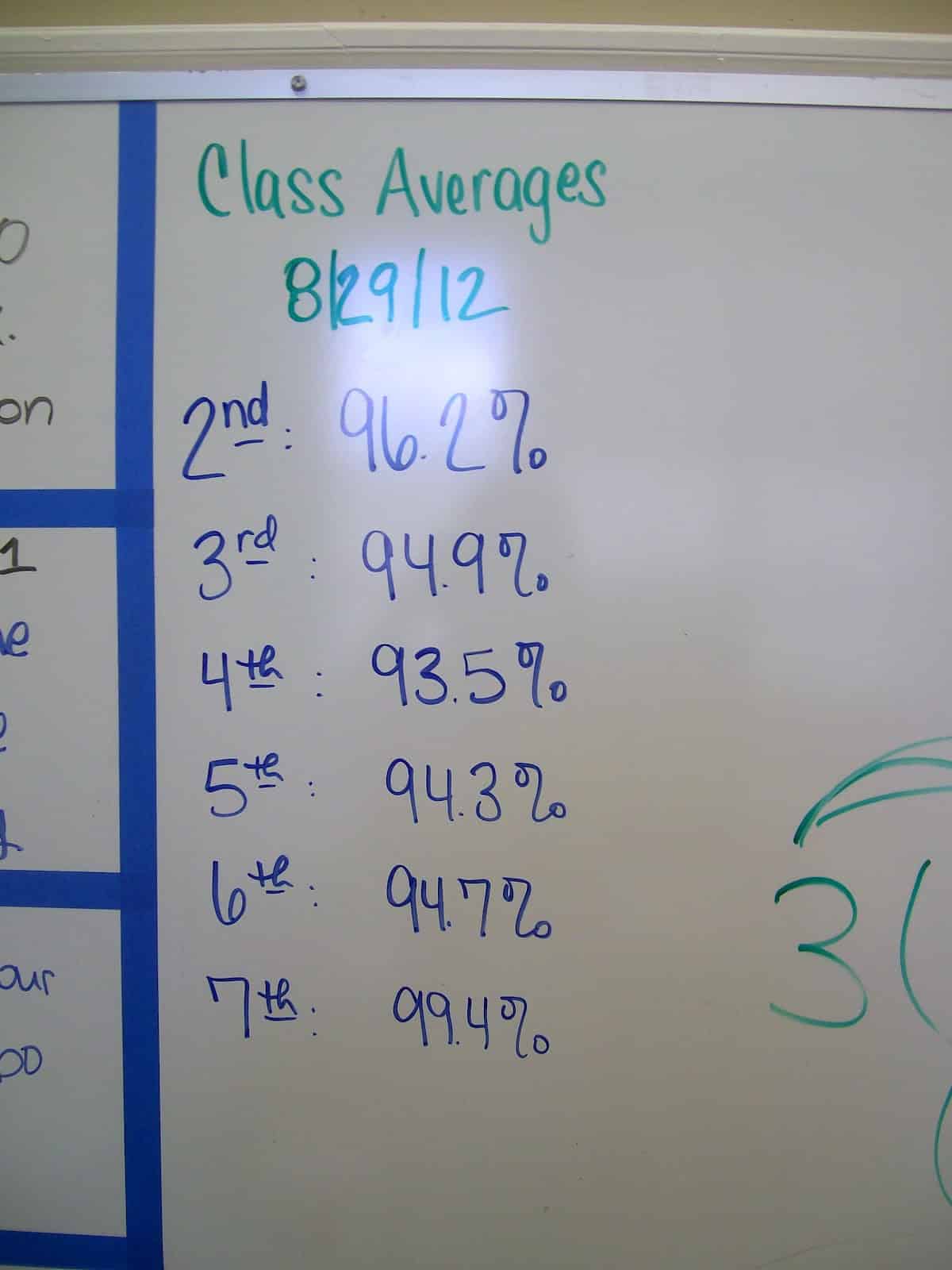
Please realize that these were the averages for my classes before our first test and before our first notebook check. The grades have dropped some since then. It took a couple of days for most of my students to notice this.
But, the question on everyone’s mind after they saw this was “what class do you have 7th period?” The answer: 8th Grade Algebra 1. Let’s just say high school students do not like being beat by 8th graders.
September 11, 2012 – Interactive Notebooks
Doing interactive notebooks with my students has taught me the importance of planning out every aspect of my lesson ahead of time. I’ve learned that winging it with interactive notebooks can lead to some not so pretty results. My Algebra 2 students currently have a blank left hand side in their notebook from the day we practiced combining like terms. My perfectionism hates this, but it’s reality. Some of my Algebra 1 classes take longer to complete things in class. This means that their interactive notebooks don’t exactly match my the notebooks of my other classes. They have blank pages where activities we didn’t have time for should have gone. But, there’s nothing I can do to change that.
I’ll be honest. Some days I get incredibly frustrated with the amount of time it takes for my students to glue in our foldables. I don’t even make them cut. I do all the cutting because they cannot follow cutting instructions. I think I could glue in fifteen foldables in the time it takes some of my students to glue in one. I keep hoping that we will get faster as the year progresses. We’ll see…
Then, there are the days that I see the benefits of our interactive notebooks. And, all that time spent cutting and gluing and folding and coloring are worth it. My students actually use their interactive notebooks. If they have created a foldable, they know it is in their notebooks. They know exactly where that resource is. And, this means that they actually use it. It is such a beautiful thing to look out at my students and see them using their interactive notebook without being told to. Weeks later, they are still referring to our rules for integer operations. I love that these notebooks are empowering my students to help themselves.
I absolutely love interactive notebooks, and my students do too.
September 20, 2012 – Busy Cubed
Well, I’m busy, busy, busy.
I did take time to do some baking today after I got home from school, though. Fresh apple pie straight out of the oven cannot be beat. It was a ton of work to peel all the apples. But, I did finally get to use my Pampered Chef apple corer that I’ve owned for over two years now. I love that thing! It’s absolutely amazing.
In actual math related news, my Algebra 1 students LOVE inequalities. We’ve been graphing and solving inequalities in one variable for the past two days. They seriously think it is the easiest thing ever. I’m also figuring exactly what was causing some of my students to solve so many of the equations incorrectly on our test. One student asked today if I could make this next test worth 300 or 500 points. I love seeing their enthusiasm over basic math concepts.
When I teach at a pace that is appropriate for the level of my students and in a way that helps all my students understand how to solve the problem, learning becomes fun for them. My students don’t need me to create games for them to have fun in math class. No, I just need to do all that I can to set them up for success. For many of my students, this just means breaking every problem down into steps and being there to help. I hear so many students tell me of experiences with previous teachers where they didn’t get help from their teachers. My students don’t want me to give them the answer. They want me to provide them with just enough feedback to get on the right track so they can solve the problem on their own.
Homecoming is this Friday. Normally, that wouldn’t really impact me. However, this year I am the student council sponsor. One of our main fundraisers for the year is selling the Homecoming t-shirts. I’ve been stressing over these t-shirts since the end of August. After multiple, multiple phone calls and e-mails, I was finally able to pick them up this afternoon. Tomorrow I will distribute them, and I’ll finally be able to mark this off of my to do list. Students have been asking me for days when they will be able to get their shirt.
I seriously have a new respect for any teacher who also is in charge of an organization. I never realized, as a student, just how much work went into running a student organization. I’m trying to make arrangements for us to attend our District Meeting in October and State Convention in November. It feels like I’m not making any progress. I know that when we are actually experiencing these events, all the hard work will be worth it. But, right now, it’s just overwhelming. So much of my planning period isn’t spent planning for my classes. It’s spent making phone calls and asking questions about how to do Student Council stuff. The last time I was in student council, I was in the fourth grade. I guess next year, I’ll be a pro…
A student called me “Mom” today for the first time. I knew that happened with elementary students all the time. But, I wasn’t expecting it from a high school student.
Then, I had a student ask me “Ms. H, were you ever a principal before this?” No. “Well, you look very principal-like.” This is my first year of teaching. I’m in my early twenties. Honestly, most people think that I look 16. (At my first football game, the person taking the money for the tickets thought I was buying a student ticket instead of an adult ticket.) I have the hardest time convincing people on the phone that I am a teacher. They always assume that I am a student calling them. But, this student thinks I could have been a principal… I think this thought was partially based on the fact that I have a really fancy name plaque on my desk that was a gift from my cooperating teacher.
I handed out printouts of grades today. It’s amazing how when you hand out a grade sheet and mark all the missing assignments that students all of a sudden start turning in those assignments.
My eighth graders were devastated today. Why? We didn’t cut or glue a single thing for our interactive notebook today. Instead, I just had them take a few notes, and we jumped into solving practice problems. Some of my older students, however, groan every time I ask them to take out their notebooks.
September 26, 2012 – Things Teenagers Say Volume 0
Before I ever started writing my Things Teenagers Say posts, I still blogged about the occasional memorable thing my students would say. I’ve decided to compile them here and call this Volume 0.
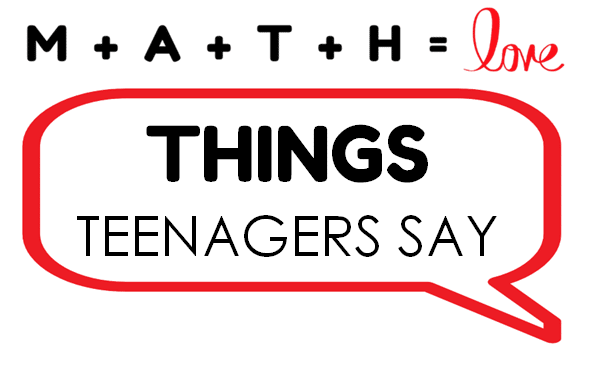
Student: “Somebody keeps texting me.”
Me: “Don’t they know you’re at school?”
Student: (sheepishly) “I text at school.”
Me: (appalled look)
Several other students: “Don’t worry. We don’t text in your class.”
Student: “I’m too unbored to text in your class.”
—
Student: “Ms. H, are you married?”
Me: “No.”
Another Student: “Does she look like she would be married?”
At this point in the conversation, I’m trying to figure out if I should be offended or what… After a few comments from other students that it wasn’t a very nice comment, the student clarifies: “Well, she isn’t wearing a ring or anything, so she doesn’t look like she would be married.” Was that what they really meant? I’ll probably never know…
—
One of my students walks by me in the hall wearing pajama pants and a sort-of hat made out of a tube of black fleece fabric with pink pigs. The other math teacher and I exchange a look of disbelief. Next, the librarian comes down and tells us that we will need to send the student to the office when he comes back by us for his dress code violation.
Since he is actually in my next period, I assure her that I will send him to the office. Well, he comes to the door, and I inform him that he will have to go to the office. Why? Well, you’re not allowed to wear pajamas at school. You’ll need to go to the office.
Instead of complying with my request, he says, “That’s okay, I’ll just take them off.” He then proceeds to pull down his pajama pants in the hall. The other math teacher and I are shocked. I mean, students don’t usually just start taking off their clothes in the hallway. Now, I’m going to have a bigger issue to deal with than a dress code violation. This is definitely not something they teach you how to deal with in your typical teacher education program. Luckily, he was wearing normal, dress code appropriate shorts under the pajama pants. I just didn’t know that at the time when he announced that he would just take off his pants.
—
Student: “Ms H, did you go to college?”
Me: “Yes.”
Student: “What college did you go to?”
Me: “The University of Tulsa. Why?”
Student: “Well, you have nice handwriting. And, I heard that people who went to college tend to have nice handwriting.”
—
Me: “Did someone take my scissors? I can’t find them.” (A student had recently came to my desk and borrowed something. I thought it might have been my scissors when I couldn’t find them…)
Students: “No.”
(A few minutes later, I found them under my interactive notebook and next to the document camera…)
Me: “I found them.”
Student: “So we didn’t take them.”
Me: “No, you didn’t. I apologize for blaming you.”
Student: “Really?”
Me: “Yes, I apologize. I shouldn’t have assumed that one of you had taken them when I couldn’t find them.”
Student: “You’re the only teacher I have ever heard apologize to their class.”
Me: “Really?”
Other Student: “Yes, teachers never apologize when they blame students for something they didn’t do.”
The rest of the class agrees with this statement and adds supporting details.
Another Student: “Thank you for apologizing.”
Another Student: “Yes, thank you for apologizing. I appreciate it.”
—
Students are working 2 bellwork problems on factoring. I am typing up the next 5 review problems to project on the Smart Board.
Student: “We need help.”
Me: “Okay. Let me finish typing this problem, and then I would love to help you.”
Student: “Really?”
Me: “Yes, I would love to help you. Let me just finish typing this, and I will be right there.”
Student: “That’s the first time I’ve ever heard a teacher say that they would love to help us.”
Other Student: “Yeah. Most teachers don’t like helping students. They don’t like it when we ask questions. No teacher has ever told us they would love to help us.”
These students then proceed to tell me about teachers ignoring them when they raise their hands.
—
Student: “Can I go to talk to the principal?”
Me: “No.”
Student: “Why not?”
Me: “He’s not here today.”
Student: “Why? Where’s he at?”
Me: “He’s at a workshop.”
Another student: “Is he at Santa’s workshop?”
—
“How can vegetarians eat sandwiches?”
—
Student: “Do you want to look at this?” (This student has just handed me a blue folder that is completely full of his math assignments from last year.)
Me: “Sure.”
Student: “So, what do you think? Can I get some extra points for it?”
Me: “What?”
Student: “I was hoping that you would give me thirty extra points for it.”
Me: “This is from last year. It’s not for this class. I’m sorry, but I can’t give you any extra credit for having last year’s assignments.”
Student: “I was hoping that if I kept it that I would get some extra points for it. That’s okay. I’ll take it to [the other math teacher.] He’ll give me some extra points for it.”
Me: “But, he’s not your teacher. How will he give you extra points?”
Student: “That doesn’t matter. He can still give me extra points.”
—
“Guys, it’s three days until Hanukkah. I know this because I asked for a dreidl for Christmas.”
—
Student: “Why did you write ‘crosses x-axis’ when you said ‘crosses the x-axis?”’
Me: “We don’t always write out article adjectives when taking notes.”
Student: “What’s an article adjective?”
—
Student: “Are we your favorite class?”
Me: “I plead the fifth.”
Student: “So, fifth hour is your favorite class?”
October 3, 2012 – Hopes, Dreams, and Random Thoughts
I cannot believe that it is already October. This school year is really flying by, and I’m afraid it will be Christmas before we know it. While I am excited for Christmas carols and hot chocolate and twinkly lights and chocolate candy galore, I want this semester to be as long as possible. I know as soon as we return from Christmas break that the time I have left to get my students ready for their end of instruction exams will quickly dwindle.
I just started Chapter 4 with my Algebra 1 students today. We’re studying ratios and proportions. In the next chapter, we will start graphing! I am so excited to teach my Algebra 1 students how to graph. My Algebra 2 students came to me with the attitude of hating graphing. I want to change this for my students. Graphing should not be something to dread.
I had students today that literally groaned when I mentioned that we would be starting ratios and proportions. They told me that this was what had made Algebra hard for them in the past. Last year, they didn’t get ratios and proportions. Then, after teaching the lesson, they were in disbelief. This is all there is to solving a proportion? This is easy.
I teach students who are years behind in mathematics. They are not used to excelling in mathematics. On the end of year tests, students can score one of four levels: unsatisfactory, limited knowledge, satisfactory, or advanced. My goal is that each and every one of my students will score either satisfactory or advanced. Is this goal unrealistic? Maybe so. But, I have worked so hard this year and my students have worked incredibly hard. I want them to finish Algebra feeling confident. I want them to see that all their hard work has paid off.
Tomorrow, I will leave my students in the hands of a substitute for the first time. I am taking my student council students to our District Meeting. I’m excited to take these students to hear a speaker and interact with other local students. But, at the same time, I hate leaving my classes. I’m leaving them a worksheet to do, but it’s just not the same as my being there. My students already miss so much school due to school activities. I need to make every day count.
I’ve been working crazy long hours trying to get ready for this trip as well as our 3-day trip next month. This morning I got to school at 6:10 a.m., and I didn’t leave until 7:30 p.m.. I did do about 1.5 hours of tutoring during that time which accounts for part of my crazy day. I’m at a stage in my life where I can get by with working these crazy hours. Hopefully, I will soon get faster at doing stuff for my non-classroom responsibilities. I am Student Council Sponsor, National Honor Society Sponsor, Freshman Class Sponsor, and a Sponsor for our soon-to-be created Math & Science Club. I do the after school tutoring for math at the high school. These definitely keep me busy.
I sat in on my first special education meeting today. I loved getting the opportunity to watch our special ed teacher in action. She is amazing. It was also great to interact with the student and her mother since we hadn’t met before. I learned some things that I can put to use in the classroom to provide a better learning environment for this student.
With every success from my Algebra 1 classes, I feel like I keep hitting roadblock after roadblock with my Algebra 2 and College Algebra classes. I’m working on factoring in Algebra 2. My College Algebra students are working on finishing up the review chapter in our textbooks. That’s right, we’re over 6 weeks into the school year, and we still haven’t made it to Chapter 1. However, my students have learned so much. I’m trying a new technique with them tomorrow. I wrote out a 16 page handwritten study guide to leave for them with the substitute. I want to teach my students to be more self-motivated. I want them to be motivated by the process instead of the right answer.
October 9, 2012
I’m not having the best of days. I seem to have had quite a few of these of late. Don’t get me wrong. I still absolutely love the teaching part of my job. It’s the other aspects of my job that have me frustrated. There is so much drama that comes with working in a public school. I try to keep up with everything that’s going on, but it just ends up making me mad.
On top of the school drama, one student both entered and left my room today in tears. Another student has decided to refuse all of my offers to help. She wants me to let her fail. I can’t let myself do that, but at the same time I don’t know how to help someone who won’t let me help them. And, I’m pretty sure that I teach at a school with an absence epidemic. These students miss school for EVERYTHING under the sun.
On a happy note: In the past week, I have had students ask me if we could do certain activities again because they enjoyed them so much the first time.
October 9, 2012 – Basketball Game for Solving Two Step Equations
When teaching my Algebra 1 students to solve two step equations, I used a basketball game that I found online to motivate my students to do some extra practice. These were the same types of problems that I could have written on the Smart Board, but because they were in a game, my students did a lot less complaining.
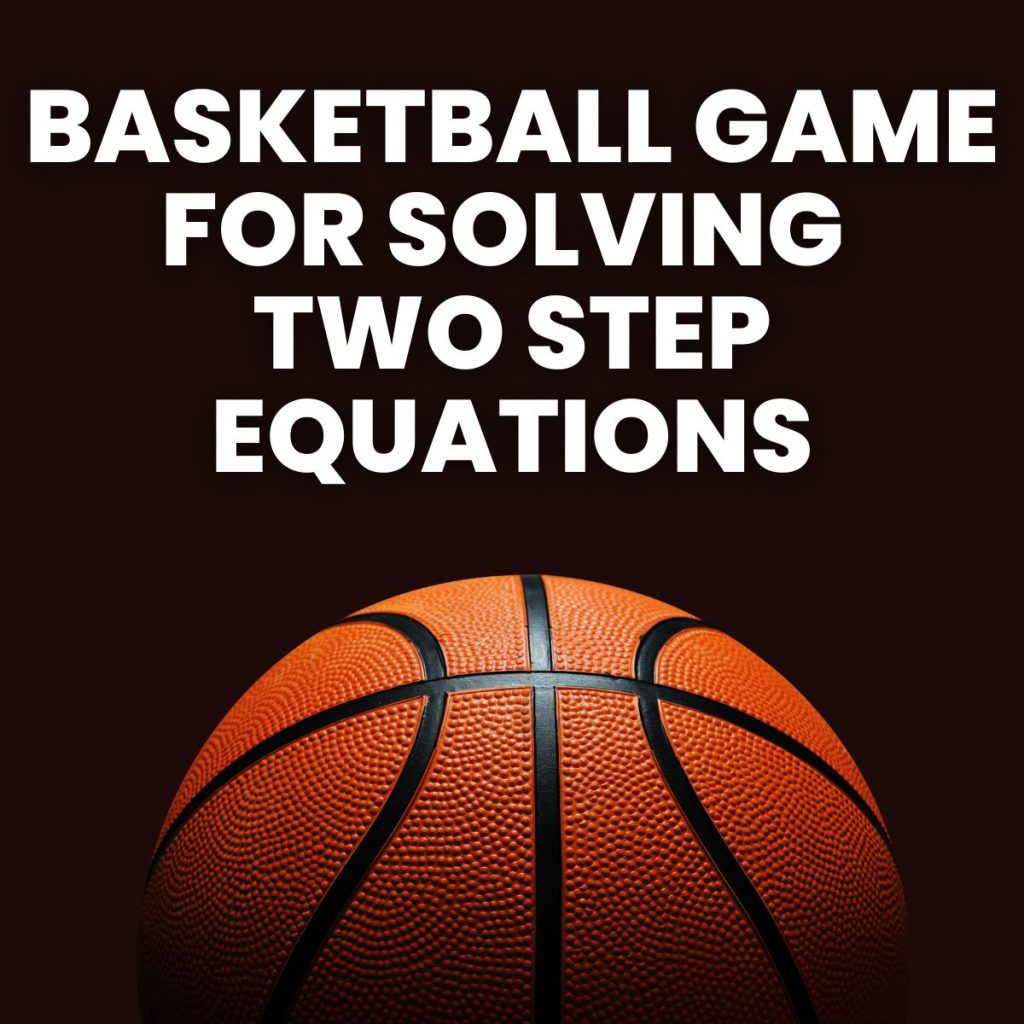
The idea of the game is simple. You get the question right, you get to try to make a basket. To shoot the basket, you click the mouse twice. I’m sure there is some advanced strategy to making the virtual basket, but I could never figure it out. I watched five different classes play this game over the course of a day, and I still couldn’t figure out why some shots went in and others didn’t.
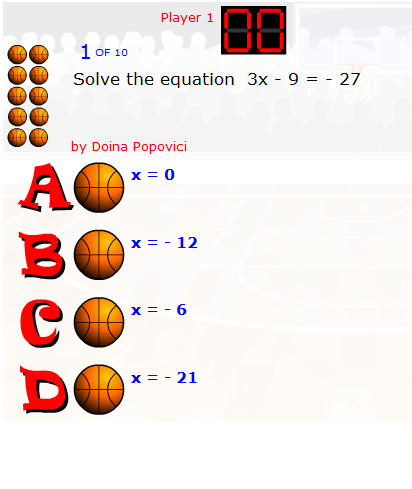
I let the students take turns coming up and shooting the baskets. It served as a small break between solving equations. The students really got into trying to make as many baskets as possible. It was fun to watch. The bell would ring and the students would want to hurry and solve one more equation so they could attempt just one more basket.
Now, if we ever have a few minutes left at the end of class, students will occasionally ask if we can play the basketball game again.
October 10, 2012 – What I Can’t Wait For
It’s after 11 p.m., and I should be sound asleep. Instead, I’m writing this blog post about what I’m excited for in the near future.
So, here is the inaugural edition of “What I Can’t Wait For…”
- I can’t wait to try out Boss/Secretary with my Algebra 1 students tomorrow. I tried it today for the first time with my Algebra 2 students, and I am in love. It provided the structure for the most amazing factoring practice I have had with these students. They loved it. I loved it. And, every time they got a question right, they would have to declare that they got it right “like a boss.”
- I can’t wait to teach scatter plots and types of correlation in Algebra 1. During my student teaching, I taught this with M&M’s. My school just adopted a no food in the classroom policy, though. So, I picked up some colored neon dot stickers at Big Lots this weekend. I am going to let the students use the stickers to create scatter plots with each type of correlation. I think the tactile nature of placing the stickers in their interactive notebooks will help solidify my students’ understanding.
- I can’t wait to teach my students how to play coordinate grid battleship. I actually taught my 8th grade Algebra 1 students how to play the other day. They were a day ahead of my other classes, and I wanted to do something fun but educational for Friday. They had a blast, but I had a really tough time explaining the rules. Only two of my students had ever played actual battleship. So, the majority of my students had no concept whatsoever of the game. However, after they got into it, they were hooked. They have even asked to play it again.
- I also can’t wait to do the coordinate grid pictures with Algebra 1. My Algebra 1 teacher taught us how to do these, and I want to continue the tradition. I’ve seen so many cool designs on pinterest. Now, I just have to decide which ones to print off for my students.
- I can’t wait to try to play coordinate grid hangman in Algebra 1. I’ve never played this before, but it sounds like a ton of fun.
- I can’t wait to move onto Chapter 1 with my College Algebra students. We have been on the review chapter for ages and ages. I’m having to reteach almost every single concept that should have been taught in Algebra 1 or Algebra 2. I love graphing, and that’s chapter one!
- I can’t wait until my garage door is fixed. I’ve lived in this house since July, and I would like to actually be able to park in the garage at some point in the near future. Someone was supposed to come look at it this afternoon, but they never showed…
- I can’t wait for Fall Break. 5 days in a row without school. Of course, I will most likely find myself doing a ton of school work during this break… I also need to do fun things like get a hair cut and update my driver’s license. Plus, the fact that this will be my first fall break in over four years makes it even more exciting. I loved my college, but they didn’t believe in having a fall break. They did give us the entire week off at Thanksgiving to make up for it, but it was always so frustrating to log onto facebook and see all my friends talking about fall break…
- I can’t wait for Student Council State Convention. It’s in the beginning of November. I’m excited to go and try to learn more about what student council is all about. But, I’m also excited to mark it off my to do list. This has been a major undertaking to prepare for. It’s going to be six kids plus me and another teacher for three entire days.
- I can’t wait for Christmas. There are just so many things to love about Christmas. Christmas carols. Hot chocolate. Christmas Ornaments. Watching the kids at my church act out the Christmas story. Christmas movies. Christmas novels. Maybe I’ll even convince my sister to play the Christmas light game with me for old times’ sake.
October 12, 2012 – The Intersection of my Grand Plans and Reality
Honestly, my first year of teaching is going pretty well. Throughout my education program in college, I didn’t really feel like it was preparing me all that much for life as a teacher. We read about classroom situations and discussed how we would handle them. We practiced writing tests for imaginary classes and imaginary students. We wrote 6-10 page lesson plans for lessons we never intended to teach. We observed teachers in their classrooms and wrote about what we saw. I excelled at these things, but at the same time I knew that these would not necessarily correlate to success in my own classroom.
Student teaching was the best thing that could have ever happened to me. At my first placement, I didn’t learn a lot about teaching, but I did learn a ton about working with at-risk students. I saw first-hand what happens when the pace of teaching and the method of teaching doesn’t match what the students need. These students were years behind in math. Some didn’t even speak English. One student I worked with had never learned what “divide” meant. Working a few examples on the Smart Board and giving the students their homework assignment wasn’t working. By the time I got there in January, these students were even more behind. On top of that, they were frustrated. They believed that they couldn’t be successful in math. The homework completion rate was extremely low. And, test scores matched that.
At my second placement, I still didn’t learn a lot about teaching. All of the 8th grade math topics had already been covered. Instead, it was my job to prepare the students for the 8th grade state math test. There, I learned about decision making in the classroom. I learned about classroom management. I learned the importance of reflecting on my lessons and revising them. I found out that it was okay to scrap something that isn’t working even if I spent hours on it. For weeks, I prepared those students for a test that would greatly determine their future.
Since getting this job in April, I’ve been planning. What will my classroom look like? What will I teach? How will I teach it? And, thanks to my many blogging friends, I began making grand plans. I bookmarked their ideas. I scoured pinterest for hours. I read 4 different books on the best way to teach. Each book contradicted the other books. I had all these ideas floating around in my head, but I didn’t know which ones were the right ones.
This summer, I started actually using twitter. It’s been life-changing to say the least. I can’t imagine life now without my twitter friends. Being one of only two math teachers at the high school can be lonely. The other math teacher is right across the hall from me, so we compare notes about our Algebra 1 classes during the passing periods. We talk about what worked and what didn’t. He listens to me vent, and for that I’m most thankful. But, on twitter, I have access to so many experts. They’ve been teaching for years, and they know how to teach math. Ideas I would never dream of coming up with on my own are shared. They’ve helped me transform so many of my lessons. I always leave twitter feeling inspired.
So, what actually goes on in my classroom? Some days I feel like such a fraud because I have posted all these things on my blog that I planned to use or do and they just don’t happen.
Bellwork. Originally, I was going to do an ACT practice question each day. Then, I changed my mind to doing Stella Stunners. I did these brain teaser type puzzles for two weeks. I wanted to develop my students’ problem solving strategies. That failed. A few students would try. The others would declare it was too hard and wait for me to give them the answer. I still do bellwork. But, I’ve started doing review problems from the previous lesson or reviewing a prerequisite concept for the current day’s lesson. Amazingly, my students come in my classroom and start on their bellwork without being asked. (Well, most of them do. I have a few who still need to be reminded.) They can’t wait for me to check their answers. It’s a beautiful thing. I’m the only teacher in my school who uses bellwork, and I can’t imagine my classroom without it. The first few minutes of class are not wasted. In fact, I am often ready to start teaching before the bell even rings.
Exit Tickets. Yes, I said I was going to do an exit ticket every day. The teaching books told me I needed to. I write them in my lesson plans. But, I may only actually do one every two weeks. I like to use them when introducing a new concept for the first time. I’ve found, though, that I really don’t need them. I teach really small classes. I only have 7-17 students in each of my classes. We use our dry erase boards to solve problems every day. The students solve the problem and hold it up for me to check. I don’t need the exit ticket to tell me who has it and who doesn’t. I already know.
I am a work in progress. I work to become a better teacher every single day. Some days are more successful than others. It’s hard. There are so many variables in my students’ lives and my school that I can’t control. But, I’m learning, with the help of my amazing twitter and blog friends, to do my best at what I can control.
October 18, 2012 – Parent Teacher Conferences
Well, I survived my first round of parent teacher conferences as a teacher. Reaching this milestone means that I am officially 25% done with my first year of teaching.
I sat in on one evening of conferences during my student teaching. Basically, I just shook hands with the parents and sat there quietly while my cooperating teacher did all of the talking.
Now that I am the teacher, it was up to me to do the talking and the listening. I only had 8 parents show up for conferences. I teach approximately 68 students. Of course, as a math teacher, I had to do the math and figure out what percentage of parents showed up. Approximately 12 percent. (I do have to add, though, that 3 of the parents who did show up are currently employed by the school district.)
Maybe I should give this problem to my Algebra 1 students as bell work on our first day back from Fall Break. If Ms. H has 68 students and 8 of their parents showed up for conferences, what percentage of parents showed up for parent teacher conferences? We’ve just finished our chapter over ratios and proportions. Even though we’re starting to graph now, I need to keep reviewing these previous concepts as much as possible.
The conferences were pretty laid back. The students who are really struggling in my classes are the ones whose parents did not attend conferences. I guess this means I will need to make some phone calls…
October 20, 2012 – More Things I Can’t Wait For
I can’t wait for the next chapter in Algebra 1. I know, I know. I just started a new chapter in Algebra 1. We’re getting ready to learn how to graph functions. But, what I’m really excited about is teaching my students how to calculate slope and use the slope and y-intercept to graph functions.
- I’m excited to have my students create mountain slope pictures. My cooperating teacher at the middle school level had his 8th graders do this before I got there. So, I only saw the end results. But, I loved them so much that I knew I had to file away the idea for the future. Give each student a sheet of graph paper. Instruct them to draw a mountain range. Students must then calculate the slope of each side of each mountain in the range. After calculating and labeling all the slopes, the students name their mountain range and color it.
- I’m debating whether to teach my Algebra 1 students about the Slope Tree or Mr. Slope Guy.
- But, I’m definitely using this Alphabet Slope Activity to get in lots of practice.
- And, I’ve heard good things about the Slope Dude video on twitter.
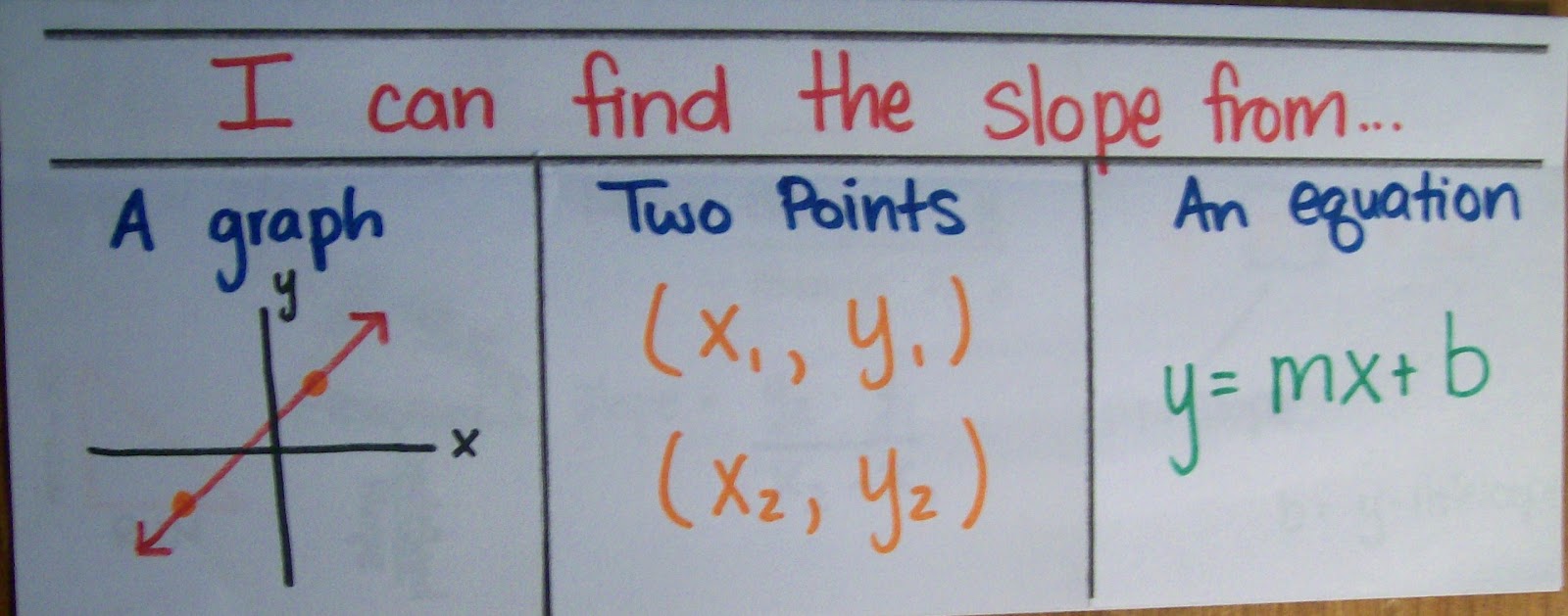
- I want to modify my Slope Foldable to include a section on how to calculate slope from a table.
I also can’t wait to get over this cold. How am I spending Fall Break? Sick and in bed. This is the first Fall Break I’ve had since high school, and I haven’t even been able to enjoy it. However, I guess I should be thankful that I’m getting this cold over with while I don’t have to teach. I learned during my student teaching that trying to teach with a cold is miserable.
I can’t wait to start graphing in College Algebra. We’ve spent the first nine weeks of school going over the review chapter in our textbook. Needless to say, this material was not review for these students. I had to teach almost every concept as if they had never seen it.
I can’t wait for my Algebra 2 students to realize what an amazing resource our graphing calculators are. I taught my students how to find the zeroes of a function using the graphing calculator, and some of the students hated it. One student pleaded to be able to solve the quadratics by hand. I explained that we needed to learn how to solve them using the calculator since the end of year test will have higher order polynomials that we will not know how to solve by hand. I think one of the biggest problems my students are having is with the left bound / right bound prompts. They don’t know the difference between left and right. I learned this by working with my Algebra 1 students. When we were solving equations and inequalities, I would often ask them what was left on the left side. Almost always, they would tell me what was left on the right side. They’ve gotten a lot better at it. I guess I’ve drilled left and right into their brains enough by now. My older students still need some left / right lessons, though.
I can’t wait until I can find some time to delve into the book I recently ordered. It’s called Inspiring Active Learning: A Complete Handbook for Today’s Teachers. I came across this book while researching the boss / secretary concept. I have used it as well as the muddy to clear strategy. Both worked really well with my students, and I am excited to learn more strategies that I can put to use in my classes.
October 23, 2012 – Meet Stan
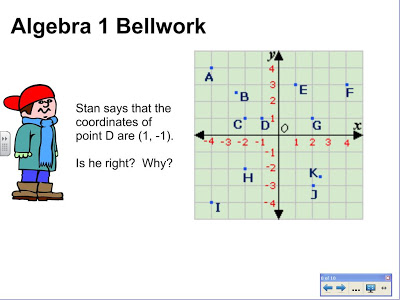
The Backstory
Meet Stan. Stan’s the sort of guy you end up with when you decide to change your bellwork five minutes before class starts. In a rush, you search google images for the perfect picture of a coordinate plane. You find one that even has points already marked by letters.
You want to start involving the class in some error analysis. So, you have a fictional character wrongly identify one of the points. Oh, this fictional character needs a name. Does the name really matter? No, not as long as you pick a name that doesn’t belong to one of your students. Stan will work.
Now, you have Stan misidentifying a point on the coordinate plane. You give your students this information and ask them if Stan is correct. Most importantly, you ask students to justify their answer. Why is Stan correct? Or, why is Stan incorrect?
Something is still missing though. What does Stan look like? Since the bell is about to ring and students are going to be streaming in your class, eager to do the bellwork, any minute now, you decide to enter “boy” into the search box inside the Smart Board Gallery. Stan is who you end up with. Sure, he’s a little weird looking, but the students won’t notice…
Lessons Learned
- Students will notice that Stan is a little weird looking.
- Students will want to draw a mustache on Stan to make him a little less weird looking.
- Students won’t always answer the “Why?” question in the way you expect them to.
My Favorite Answer
To illustrate the last lesson learned, I present to you my favorite answer of the day to the “Why?” question:
Me: Is Stan correct?
Student: No. He’s wrong.
Me: Why?
Student: His math teacher isn’t as smart as my math teacher.
October 25, 2012 – I love bellwork
I love bellwork. My Algebra 1 students love bellwork, too. It’s a great way to refresh their memory of the previous day’s topic. If a student was gone, they will often ask their tablemates for help during the bellwork time. Plus, it’s a chance to have a little fun.
Since talking to some of the other teachers at my school about bellwork, some have started implementing it in their own classrooms! I would love to see it become a school-wide expectation in my district.
I already introduced you to Stan. This is an example of using bellwork to practice error analysis
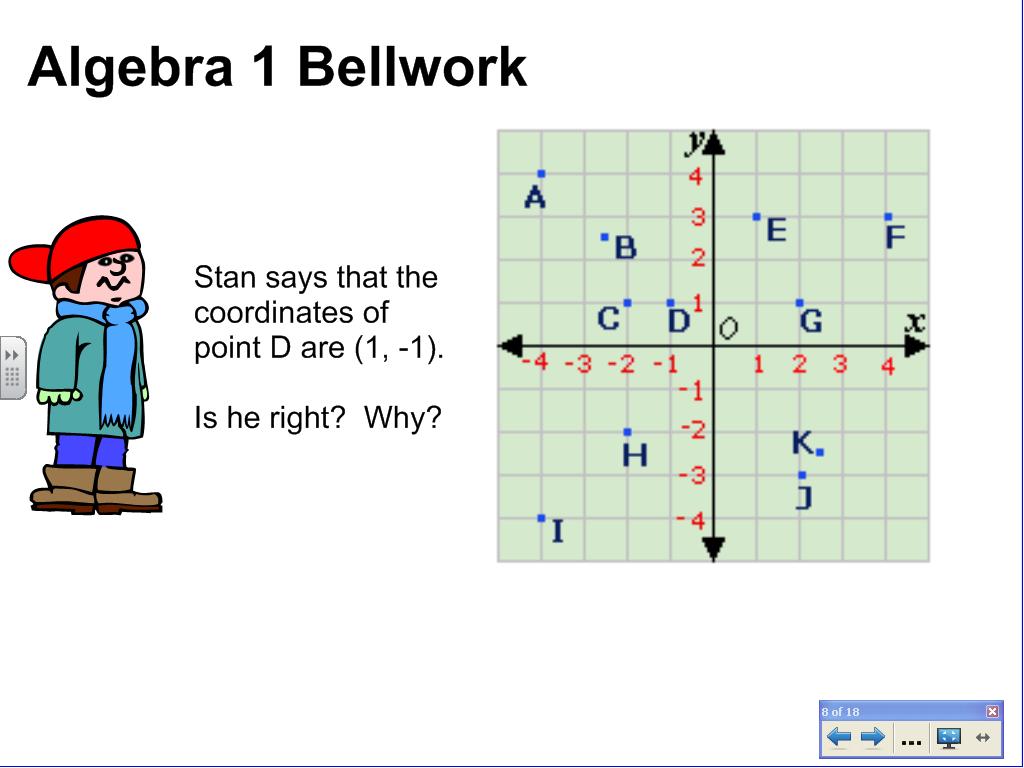
I gave my Algebra 1 students a real-life proportion to solve. This is an example of using bellwork to review a previous topic using a real-life example
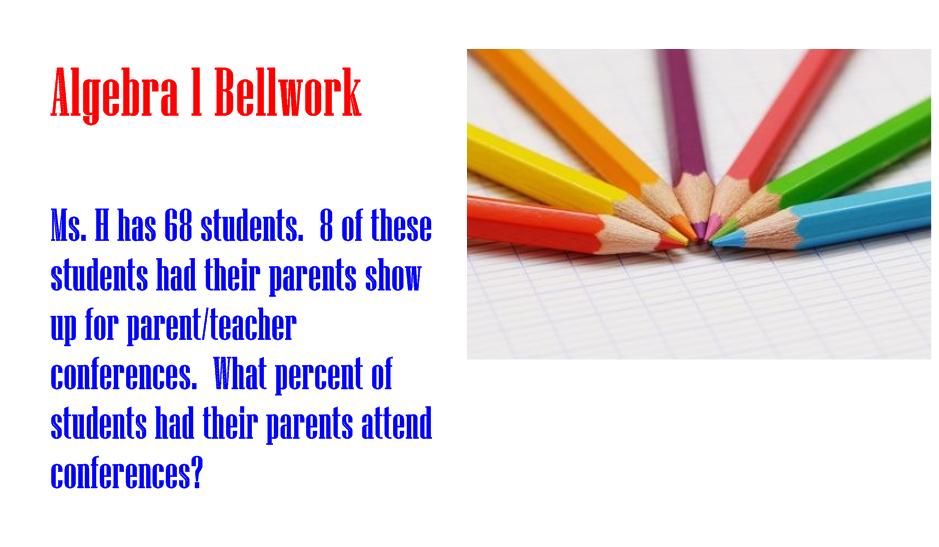
I used my students’ birthdays in Algebra 2 to determine their bellwork assignment. Interestingly, one of my students couldn’t figure out which task she was supposed to do because she was born on the 4th of July… I thought my instructions were pretty clear…
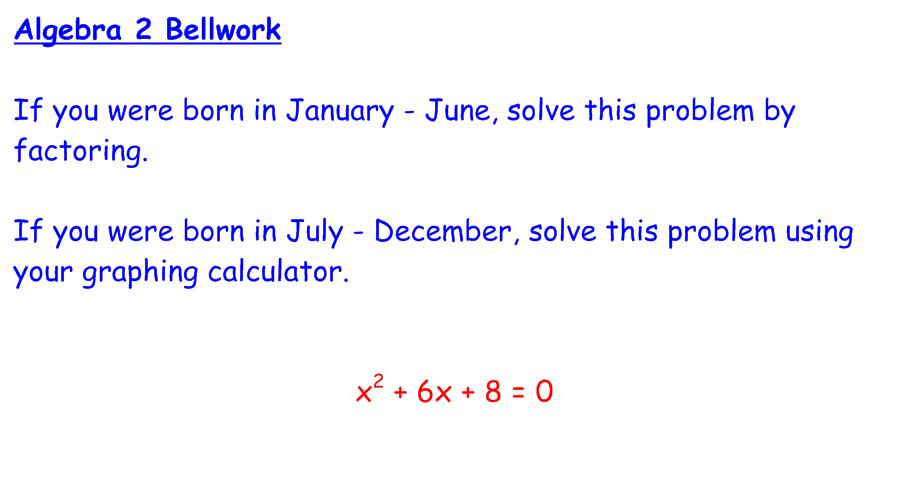
I liked this set-up better than giving students the option of which method to use. I wanted to show students that we would get the same answer either way.
November 16, 2012 – What’s the Likelihood?
Two days ago, I finally made time in my crazy schedule for a much needed haircut. I hadn’t had a haircut since this summer. I don’t think I knew going into teaching how difficult it would be to find a balance between my work life and my personal life. When you get to school before seven and often don’t leave until six or seven, how are you supposed to fit haircuts and doctor appointments and grocery shopping into your life? It’s even harder now that I am teaching Saturday School on Saturday mornings…
Finally, I decided I would just leave work one day at a decent hour (which for me is 5pm) and go and just get it done. As I was telling the hairstylist what I wanted, we started chatting about life. I told her that I was a high school math teacher. And, I was most surprised when she said that math was her favorite subject in high school. I’m so used to hearing people tell me stories about how math was their worst subject or they never understood it. I also often hear stories about the one teacher who ruined math for them. I’m pretty sure people regularly question my sanity for choosing to teach math. Anyway, she told me that she had taken Algebra 1, Geometry, Algebra 2, Math Analysis, and Pre-Calculus in high school. And, if she had had more time, she would have loved to take even higher math classes.
So, while we are discussing math, the other hairstylist walks by and overhears part of our conversation. Upon hearing the word math, she starts telling us both that she loves math and that it was her favorite subject in school. What is the likelihood that I would pick the hair salon where all the math-lovers work?
The whole experience just makes me wonder – what would my job be like if more people loved math? What would it be like if more parents loved math? What would it be like if more teachers loved math? Actually, it wouldn’t even have to be “love.” I could definitely settle for a greater “respect” of mathematics.
November 20, 2012 – More than Just a Math Teacher
I went to college to learn how to teach math. However, as my first semester of teaching starts to draw to a close, I realize that I am more than just a math teacher. In the past few months, I have…
…had weekly and even daily conversations with my students about what it means to be a vegetarian. My students are still amazed by the fact that I don’t eat meat. We discuss the differences between vegetarianism and veganism. Our conversations often go like this: “Ms. H, you’re a vegetarian, right?” Yes. “So, does that mean you can’t eat potato chips?” I can eat potato chips. Why would you think that? “Well, I thought they might add something to them.”
…taught a student how to make flashcards to study for their history test. I forget that study skills are something that must be taught.
…given spelling lessons. “Ms. H, are you sure you spelled algebra right on the board?” Yes.
…showed one of my students how to count change so he could determine if he had enough money to purchase something from the vending machine.
…taught two students how to tell time from an analog clock during Saturday School. The short hand points to the hour. Whichever number the short hand has most recently passed is the current hour. The long hand points to the minutes. Take the numbers around the outside of the clock and multiply them by five to find the minutes they represent.
…broadened my students’ vocabulary. Today, we learned what the word “impede” means. Last week, it was “hodgepodge.”
…encouraged my students to take the ACT. I encourage my seniors to start applying to colleges. I didn’t realize that this would be so hard. I can encourage them, but I can’t force them to actually take the next step.
…discussed with my students the fact that the three dots preceding this phrase form an ellipsis. This led to further discussion on what the three dots actually mean.
I love teaching high school. And, I love teaching math. I remember debating what age group to teach when I was in high school. Then, I was afraid that I would get tired of teaching the same math lesson over and over. Let me tell you, I may think that I will be teaching the same math lesson four times each day, but each and every lesson turns out differently. What one class grasps right away requires extra explanation in the next. Jokes are made. Life is discussed. Math problems are solved.
I don’t think I could ever get bored with this job. Daily, it is a new adventure.
December 1, 2012 – Randomness
1. I am so thankful for having had Thanksgiving Break. I really needed the time to step away from school for a few days and recharge my batteries. (And, I just realized that I still know the Spanish term for “recharge my batteries.” Is that weird? I haven’t had a Spanish class since Fall of 2009.) But, I was really bothered by how much my students seemed to have forgotten over Thanksgiving Break. Before Thanksgiving Break, we had spent about a week on graphing lines in slope intercept form as well as horizontal and vertical lines. However, after Thanksgiving Break, it was like my students had forgot to do things as simple as graph a point on the coordinate plane. They were inventing all of these new and creative (and incorrect!) ways to graph points. I’m worried, now, though, about how much information they will have retained when they come back from Christmas Break which is much longer.
2. Dan Meyer knows that I exist.
3. When other teachers start questioning you about your relationship status, it is not a good sign. I can’t believe what rumors students feel the need to start. I guess there is nothing more exciting to talk about in this small town…
4. “You’re not my favorite teacher, but you are my best teacher.” And, I’m totally okay with not winning the first title. My students know by now that I don’t believe in free days. We don’t watch movies. We do math daily–even if it’s only a two day week due to Thanksgiving!
December 3, 2012 – A Realization
As a first year teacher, it is easy for me to feel overwhelmed. I look at my students, and I see how much of an education they have been cheated out of without their even realizing it. I see the extra obstacles that will lie in their paths toward success if I can’t help each and every one of them pass their EOI test in April. I hear their heartbreaking stories from other teachers. There are days that I feel like I am not making a difference.
The EOI test is in April. For most of these students, graduation is a few years off. But, these students are in my classroom TODAY. I need to learn to focus on them and what the current day holds. Lately, I’ve been focusing more on the things I can’t control than the ones I can. Then, I allow my frustration change my attitude and my outlook.
I hadn’t really been aware of this shift in my thinking and my focus until last week when a student told me something I will remember for a long while. Every day, this student puts his bag in my room before lunch since he has my class after lunch. And, every day I tell him hi and/or ask how he is.
Last week, I don’t remember if I actually said “Hi” or not. But, he told me that I looked sad. When I questioned him about it, he told me this: “You used to always look so happy when I came in the room, but lately you look like you hate your life.”
I don’t hate my life. And, I certainly don’t hate my job. I love that I get to spend my days teaching my students about math and life. But, I hate that I can’t change how my students choose to view themselves. I hate that I can’t change my students’ past experiences with math or school in general. I hate that I don’t know how to bring about change in this school. And, I hate that the process of change is such a slow one.
I know exactly where my frustration lies, but my students don’t. I need to focus on doing my job to the best of my ability and hope that others choose to follow me.
I e-mailed my the middle school teacher that I student taught with last week, and he wrote me back some words of wisdom. They resonated with me so much that I made them my desktop background.
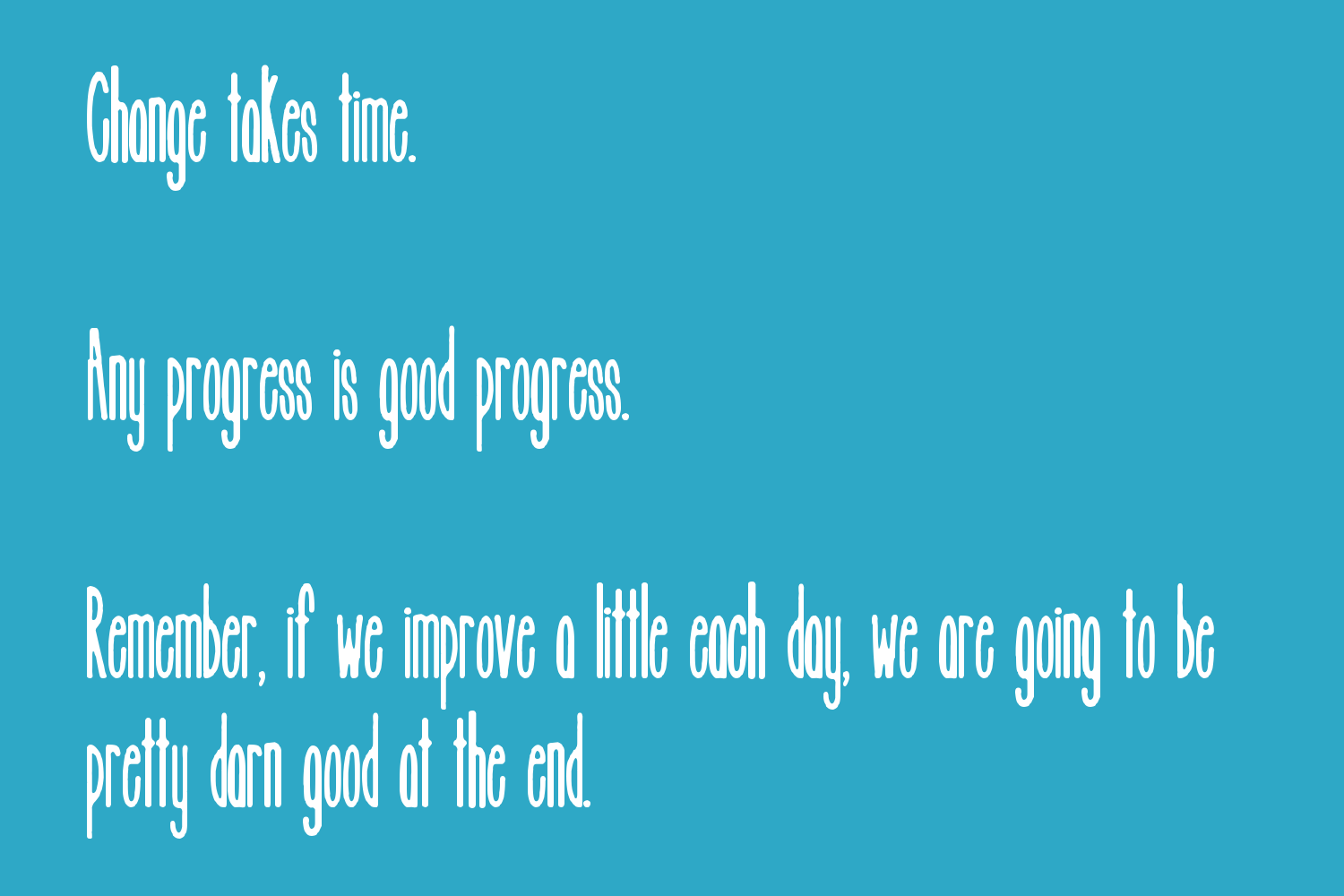
My goal for this next week (and the rest of my career) is to focus on my students. There will always be things I cannot control. I must try to bring about the change I believe in, but I cannot allow my success or lack thereof in that arena to define my attitude.
December 5, 2012 – The Little Things
Well, the student from the other day who told me that I looked like I hated my life commented again on my appearance today. When I greeted him before lunch today, he noted that I was actually smiling today. During my interview for this job, the superintendent told me not to smile until Christmas. I’m glad I didn’t follow his advice because I truly believe that my students need to see me smile. My students need to see that I want to be doing this job, that I want to be where I am at the moment.
Today’s post is about some of the little things I’ve been doing help bring a smile back to my face.
As part of my birthday gift, my sister gave me a magnetic Christmas tree, complete with ornaments. I originally assumed that it was to hang on my refrigerator, but she suggested that I put it up in my classroom. Most students don’t even notice it. But, I love it. Of course, some students like to rearrange it and place the packages on top of the tree…
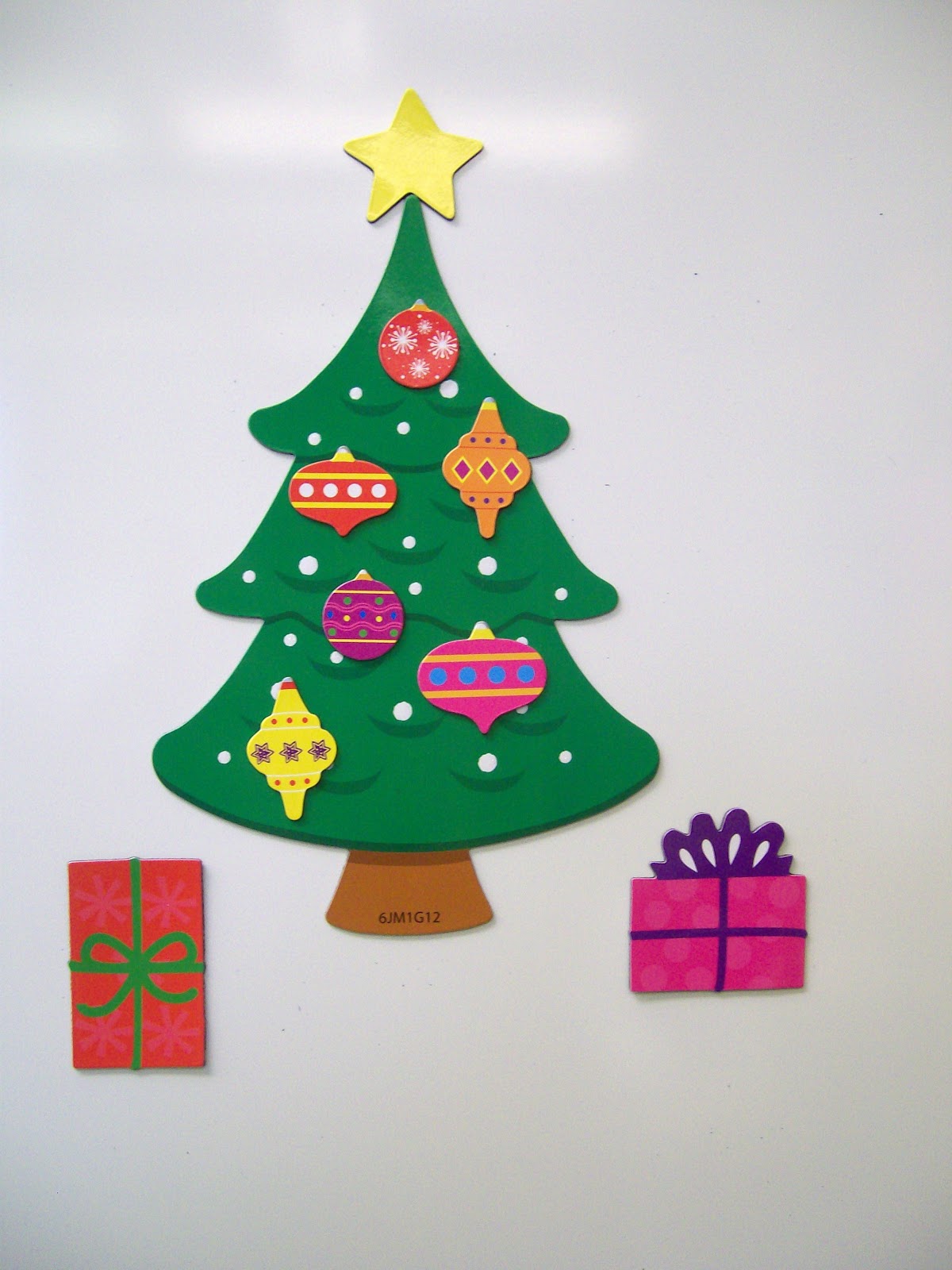
I’ve also been making a concerted effort to add memories to my memory jar. I ran across this idea on Pinterest this summer, and I decided I needed to make one for my own classroom. When I asked my mom for a jar that would work, she gave me a Mr. Peanut jar.
It sets by my desk, and whenever a students says something funny, profound, or somewhere in between, I write it down on a post-it note, fold it up, and put it in the jar. This jar is full of the things that make me love my job. But these are the exact same things that are often forgotten or overlooked when reflecting back on my day. My mind tends to focus its attention on that thing that didn’t go so well instead of the myriad of other daily events.
I think my plan is to read these at the end of my first year of teaching. I can’t wait to read back over all of these memories and relive my first year of teaching.
I used to journal a lot, but I just haven’t had the time of late. Basically, if it doesn’t get written here or jotted down on a post-it note and stuck in my jar, it doesn’t get written down.
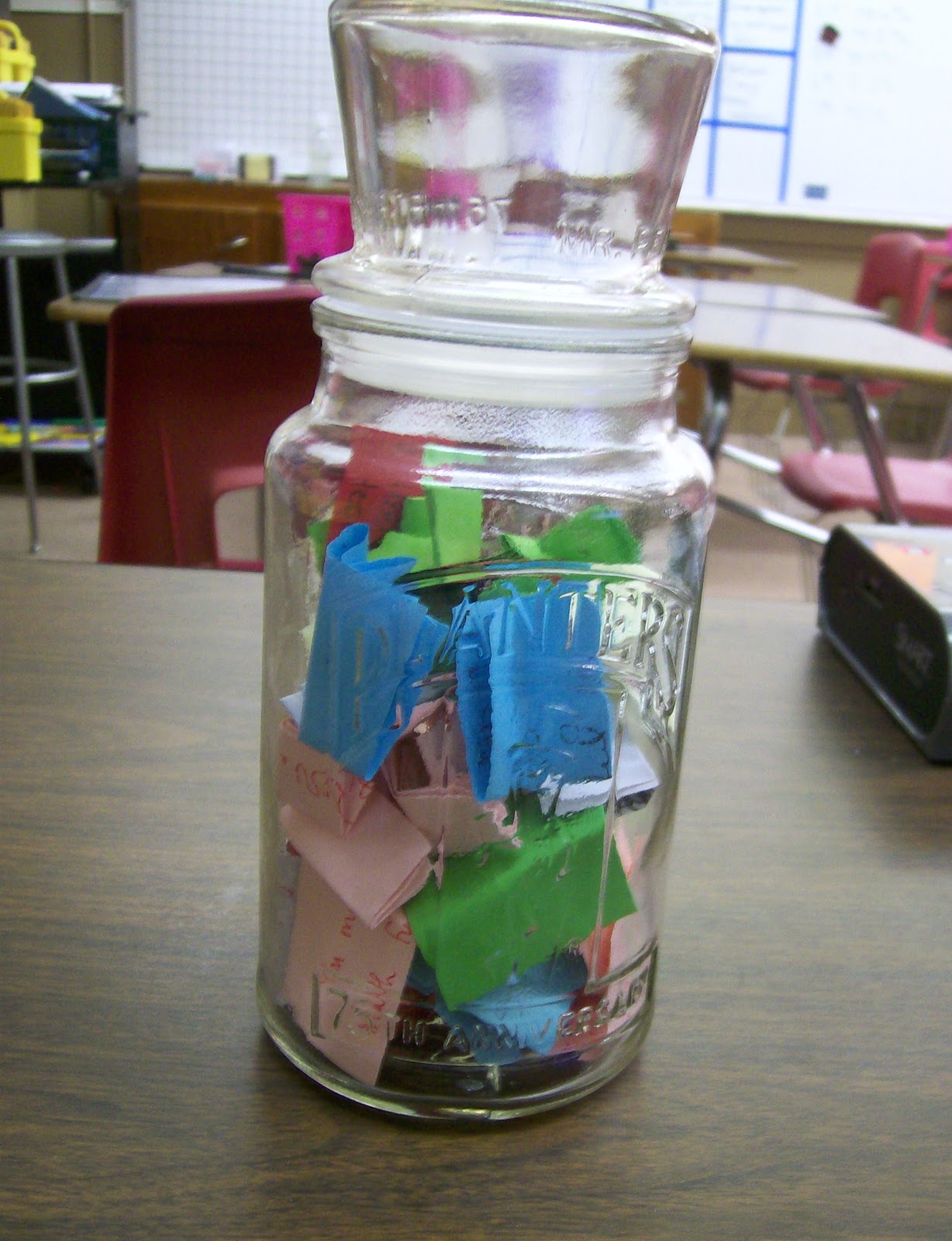
December 9, 2012 – Conviction on Caring
I care about my students. I care about how they do in my class. I care about how they are doing in other classes. I care about their futures.
A few months ago, I ordered a copy of Inspiring Active Learning by Merrill Harmin. It has become one of my most used resources for effective teaching strategies and inspiration. My copy of the book is slowly being filled with highlighting, underlining, and notes in the margins. This book has opened my eyes to how students perceive my actions. I wish this is what was taught in my teacher education program.
Convicting Quotes on Caring
High expectations are signs that you strongly care. When you give up on students or accept halfhearted work, you tell students that you do not care about their welfare all that much.
Merrill Harmin
Guilty. Last week, I covered parallel and perpendicular lines with my Algebra 1 students. We discussed what parallel and perpendicular lines looked like. We discovered the relationships between their slopes. We practiced identifying parallel and perpendicular lines by looking at their equations. We used the slope formula to find the slopes of various lines in order to determine if they were parallel, perpendicular, or neither.
Two of the last problems on the worksheet asked students to determine if a given pair of lines was parallel, perpendicular, or neither. However, they gave the students the lines in standard form instead of slope-intercept form. My students are really struggling with converting lines in standard form to slope-intercept form. I mean REALLY STRUGGLING. The majority of my students came to me with little to no background in integer operations or inverse operations.
I have tried to fill as many gaps as possible, but some of my students are still struggling. This makes rearranging equations frustrating for them and for me. As I helped some students work through these challenging problems, other students were listening. They weren’t listening for the solution process, but for the final answer. Oh, number 14 is parallel. I knew this was going on, and I did nothing to stop it.
When I graded those worksheets, I felt terrible. These students were getting a grade for work they didn’t do. I was rewarding them for cheating. High expectations were not present that day in my classroom… And, it’s this sort of thing that makes me want to adopt standards based grading in my classroom.
When we can radiate our best selves in the classroom each day, we naturally elicit the best response from students…This inspiring power is especially intertwined with our ability to be caring.
Merrill Harmin
After reading this passage, I wrote the following in the margin: “Convicted. No more bad days. Ever.” I am human. I have great days and not so great days. I am guilty of getting frustrated with one of my class periods and letting that frustration carry over into later class periods. This is not right. My students deserve me at my best each and every day. It shouldn’t matter how I feel, what day of the week it is, or how my 3rd hour acted.
I don’t have the answer for how to make this happen, but I’m taking the first step by reflecting on and making myself aware of the problem. After several conversations with one of my students, I have started forcing myself to smile some days when I don’t feel like it. And, you know what? Sometimes that simple act is all it takes to start changing my attitude and outlook on the rest of the day.
December 18, 2012 – Hey World!
Since my junior year of college, I have been blogging about teaching math. However, I’ve kept it a secret. Every once in a while, someone would tell me that I should start a blog. I would sort of smile and nod, knowing that I was already blogging about it. Over the past few weeks, I stepped out of my comfort zone and told two people about my blog. It was a big step for me.
Today, spurred on by Dan Meyer’s public service announcement, I am proudly writing my name on my blog. I am proud of what this blog has become. I love that it captures both the good and the frustrating since teaching truly is a mixture of both. I believe that my blog is a reflection of my dedication to my students, my school, and this profession. So, starting today, I am proudly proclaiming that these words belong to me.
So, without further ado:
Hey World!
My name is Sarah Hagan, and I am a first-year high school math teacher. I teach Algebra 1, Algebra 2, and College Algebra in a small, rural town in Oklahoma. Adjusting to life in a town without a single stop light or even a Wal-Mart has been an interesting experience.

I am a proud graduate of The University of Tulsa. There, I studied mathematics and secondary education. The tools I was equipped with to work with students in an urban environment translate almost perfectly to the students I now teach in a rural environment.
I work with some amazing students who teach me daily about what it truly means to persevere and overcome obstacles. They put up with my crazy review games, silly youtube videos, obsession with foldables, and love of math. (And, I don’t think they realize I know this, but I know for a fact that the activities they complain about in class are the same activities that they brag to their friends about.)
January 1, 2013 – 2012 Year in Review
2012 has been a most eventful year for me. I student taught. I job searched. I landed a job. I moved to a new town. And, I had more fun teaching than I knew was possible. Let’s take a look at my year in review.
January
In January, I started my student teaching at a urban high school in Tulsa, Oklahoma. Having been raised in a rural/suburban area, my first few days of student teaching left me in shock. The class sizes were large. I was appalled at the language used by the students. My eyes were opened to what poverty looks like.
I asked lots of questions. I stepped out of my comfort zone and taught algebra in Spanish. And, I made my first foldable. It was a life-changing experience.

February
In February, I experienced my first snow day as a teacher. I became incredibly attached to the students I was working with. I taught my students about scatter plots and correlation using M&M’s. I left my first student teaching experience without saying goodbye to my students. That is something I will probably always regret.

March
At the very end of February, I switched from an urban high school to an urban middle school. The differences between the two were astounding. During my second student teaching placement, I was given more freedom and responsibility than I could ever have imagined. I was TERRIFIED. I had 5 classes of 8th grade math students. The 8th grade math test was fast approaching, and how these students did on this math test would determine how they spent their next four years of high school.
After two weeks of observing, my cooperating teacher handed over the reins to me and took a seat in the back of the classroom. I’ll be honest. It was tough. When a lesson wasn’t going well, when the students wouldn’t quit talking, when there were ten extra minutes at the end of the class period, it was entirely up to me to figure out what to do. And, I didn’t always make the right decision. I almost always learned my lesson, though. Lessons learned by experience will stick with you way more than advice from your professor or a book on teaching.
I spent my Spring Break filling out job applications to almost every single school district within a one-hour radius.
April
In April, I had two job interviews. The first interview was for a middle school math position. My second job interview for a high school math position was a whirlwind of an experience that ended with me being offered a job on the spot. After thinking it over for a day, I accepted the position. I’m not quite sure I knew what I was getting myself into. From my interview experience and from looking at the school’s test scores, I felt like the school needed me. And, that was enough to make me leave behind everything familiar and move to a town where I didn’t know a single person, a town that I had never been to before the day of my job interview, a town without a stoplight.
I finished my student teaching at the middle school level. I’m not even sure if it is possible to convey all that I learned from my middle school student teaching experience. It was in that classroom that I started learning to put aside the educational theories I had been taught and focus on the students that I was standing in front of. The students became my focus. It didn’t matter how long I had worked on creating a worksheet. If that worksheet was doing a disservice to my students, I had to throw it out and create something new on the spot. It didn’t matter how much I disliked making decisions. My students needed structure. They needed a decision maker. They needed me to create a productive learning environment.
My 8th graders rocked their state math test. And, this time I said a proper goodbye to the students that I had, again, grown so attached to. My cooperating teacher had the students write me letters that I will always cherish.

May
In May, I donned my cap and gown and walked across the stage at graduation. I moved out of my on-campus apartment, and moved back in with my parents for the summer. I went to my first school board meeting where my hiring was officially approved. I worked in the office of my family’s business.
I also got to see my classroom for the first time. When the school counselor told me it needed a little TLC, she wasn’t joking.
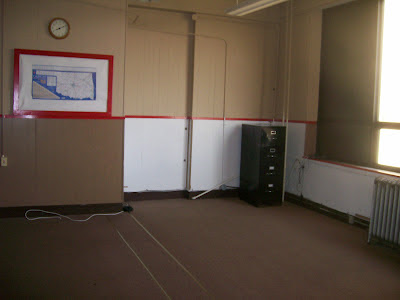
June
In June, I found me a house to rent in my new town. My mother, sister, and I started brainstorming ways to fix up my classroom. And, of course, I worked for my family’s business.
July
The majority of July was spent moving into the house I had rented, fixing up the house I had rented, and fixing up my classroom. My parents and sister were amazing. I definitely couldn’t have done it without them.
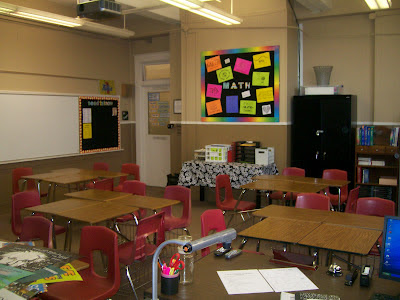
I sent out a tweet that would change my life. And, I ended up connecting with an amazing group of math teachers from across the United States and even the world.
Two days before the end of the month, I finally found out that I would be teaching Algebra 1, Algebra 2, and Math Analysis (or College Algebra.)
August
In August, I put the finishing touches on my classroom. I spent hours scouring twitter, google reader, the web, and pinterest for ideas for my interactive notebooks.
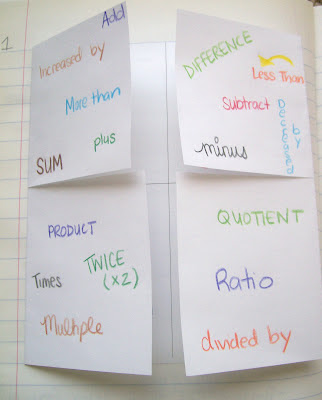
My entire town was evacuated due to wildfires. The fires came within three tenths of a mile of my house. It was definitely one of the scariest experiences of my life. Some of my students and coworkers lost everything they owned in the fires.
I lesson-planned like I never had before. I began my first year as a teacher. It definitely had its challenges, but I knew that this was the job I loved and was meant to do.
September
In September, I was asked to prepare a presentation for our next staff development session on hands-on teaching. I was honored, but shocked that they had chosen a first-year teacher to present to the entire high school faculty. Students had been talking about my teaching strategies, and the talk was good.
October
October brought with it my first experience with parent teacher conferences as a teacher. I experienced my first Fall Break in what seemed like forever. I truly loved my college experience, but I really missed having a few days off in October to rest, relax, and to get caught up on everything. (They did give us a full week off for Thanksgiving to compensate, but it just wasn’t the same.) Of course, I ended up catching a cold that spanned my entire Fall Break. My teacher self, though, would rather be sick on break than teach while I feel miserable.
November
In November, my students started working with slope and graphing linear equations. I’m pretty sure that this is my favorite unit to teach. Slope Dude was a bigger hit than I could have ever imagined. Seriously, if you teach slope and haven’t introduced your students to Slope Dude, you and your students are missing out. Mrs. H even stopped by my blog and left a comment about how Slope Dude got started. It will always be “Puff Puff Positive” to my students. Some of my students even took it on themselves to show the youtube video to some students who have the other Algebra 1 teacher.
I survived my first Student Council State Convention. It was definitely an experience! Having last been a part of student council in the fourth grade, I have a lot to learn.
December
My students, convinced that the science teacher and I should be dating, started writing us both fake love letters from the other. They were actually quite amusing, especially since everyone knew exactly who was
writing them.
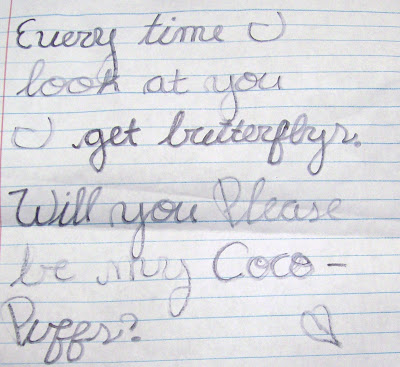
Several of my students retook their Algebra 1 EOI in December. In Oklahoma, students have to pass their Algebra 1 EOI or an equivalent test in order to graduate. These students have been taking both Algebra 1 and Geometry this year. I’m excited to report that all of my Algebra 1 students who retook the test passed! And, quite a few of them scored advanced! I’m so proud of them and all of the hard work they put in. It was a great experience as a teacher to see the light bulbs finally go off.
I gave my first semester tests. And, we spent the last few days of the semester making hexaflexagons.
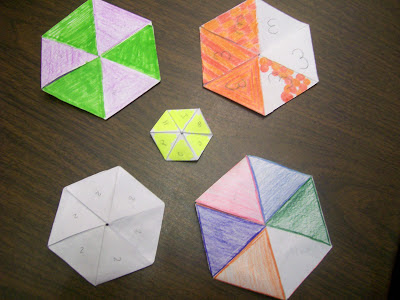
I’ve spent my Christmas Break with family. I helped complete inventory at my family’s business. I’ve been brainstorming lots of ideas for new foldables and activities for next semester. I’m reading Making Thinking Visible, and I’m trying to figure out how to take these ideas and strategies and put them into place in my own classroom. This book has shown me that I have been doing my students a disservice by not giving them opportunities to think. Thinking is something that only happens when planned for.
January 2, 2013 – Draw Me a Picture
If I taught my Algebra 1 students anything this semester, I taught them slope!
I had my students fill out an evaluation form before Christmas Break. On the back, I gave them a chance to just be creative. They could either write me a letter, draw me a picture, or write me a haiku. Surprisingly, haikus were a foreign concept to my students. I think I only had two students write me a haiku. I’m thinking that I’ll have my students write a haiku about one of our vocabulary words soon.
Anyway…most of my students chose to draw me a picture. They had the opportunity to draw whatever their hearts desired. I’m not sure what I was expecting, but I got a lot of pictures of Slope Dude’s journey and Mr. Slope Guy. I was really surprised by the students who chose to label the slopes of the lines in their pictures. I’m pretty sure this is not normal teenage behavior. But, I’m definitely not going to complain. 🙂
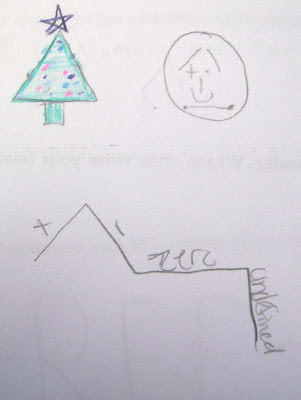
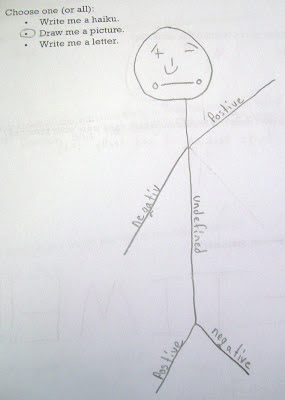
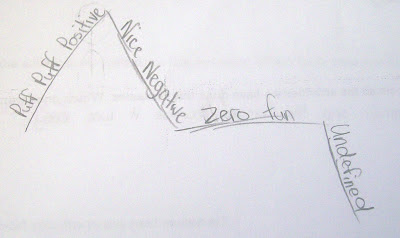
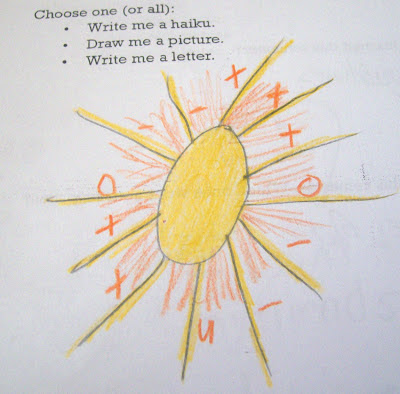
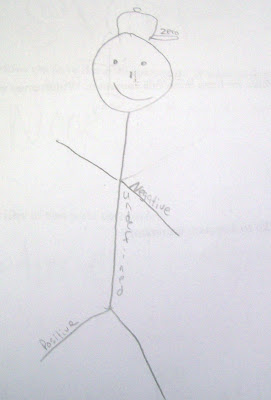
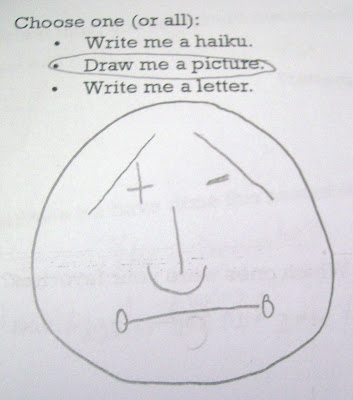

January 25, 2013 – Focus…
I don’t know why, but this whole blogging thing seems to be getting harder. I start posts, but I can’t seem to find the inspiration/motivation/time to finish them. Today, has been one of those days…
I’ve spent a lot of time recently on student council duties. But, I finally got the basketball homecoming t-shirts ordered today. I got a bullying assembly scheduled, and I found out that we will have the funds to bring Victims’ Impact Panel in to present to our students before prom.
We had our first student fight of the year today. I’m incredibly thankful it didn’t happen in my classroom. I’m also amazed it was this late in the school year! And, it was all the students wanted to talk about today…
Algebra 2 started polynomial long division today. I found it really helpful to have my students work through several regular long division problems, first. I was surprised when some of my students told me that they didn’t know what long division was. But, they seemed to all remember the process with a little review. At first, my students told me that polynomial long division was too confusing. I heard multiple students say that they would just always divide polynomials by factoring and cancelling. (Of course, these were the same students who told me that they hated factoring and couldn’t remember how to factor yesterday.) I tried convincing them that they wouldn’t always be able to factor and cancel, but I’m pretty sure my reminders fell on deaf ears. By the end of the class period, my students were actually starting to become comfortable with the process. Tomorrow, we’ll do a lot more practice and look at some word problems that can be solved by polynomial long division.
Something really cool happened, though, in my Math Analysis class that pretty much made my day. One of my Algebra 2 students is also in my Math Analysis class this semester. These students had also been struggling with remembering how to factor. So, today we worked through the Polynomial Puzzler problems from NCTM Illuminations. It changed things up a little bit, and it gave my students more practice before we continue our work with quadratics. My Algebra 2 student was having trouble figuring out how one of the quadratics factored, so she asked me if she could do the “division thing” from this morning. Incredibly surprised and delighted, I told her that she could use polynomial long division to find the missing factor. It was a proud teacher moment. Later, when she turned in her assignment, she told me that polynomial long division made solving the puzzles much easier.
I did have to confiscate something from one of my students this afternoon which was disappointing. Then, another student stole the confiscated item from my desk. I caught it, but I was even more unhappy. My students told me it was the first time that they had seen me mad. Apparently, I look evil when I get mad. Usually, I would focus on this one bad thing when reflecting on my day. But, today I’m choosing to focus on the good. Student Council is going well. And, whether it feels like it or not, I am making a difference with my Algebra 2 students.
February 10, 2013 – It’s been a while…
Well, despite all my efforts, my precautionary measures failed.

Teaching has definitely changed me. I’ve never thought so much about germs or the simple act of touching a door knob. I now understand why my high school chemistry teacher had a cup of pencils that she allowed students to use and a cup of pencils that were only for her use. I’m pretty sure that I’ve used more hand sanitizer in the past few weeks than the rest of my life combined.
Luckily, it’s just a head cold instead of one of the more serious things going around. Still, I’m tired of the sniffling and coughing and sneezing. I taught Thursday and Friday with a sore throat, and I could definitely tell I wasn’t at the top of my game as a result.
I had a surprise visitor in my classroom on Friday afternoon, though. A student from a local university was in the building to observe one of our science teachers. When the science teacher had to leave, the student was somehow directed to my classroom to observe. I was happy to have her, but I felt kinda unprepared. I didn’t feel great. My students were coming back after not doing so well on yesterday’s test. My desk was a disaster zone. It’s crazy to think that I was that college student a year ago. And, now, I have college students observing me.
I want to apologize for my absence in the math blogging/twitter world of late. The first year of teaching, as I’m finding out, can be rather overwhelming. School drama and responsibilities have left me exhausted. I’ve learned a lot from the experiences, though, and I hope to find the time to share what I have been learning with you all,
February 13, 2013 – Heart Smiles
Earlier this semester, I received a letter from a student that just made my heart smile. It was a result of the Origami Letter Project. I want to share this letter with you today. When I organized this project, I was not seeking out letters for myself. I was seeking out letters for others. My students have always been really candid with me. They tell me when they love my lessons. And, they tell me when they don’t. I value their feedback. Since I’m not in others’ classrooms, I don’t know if the students give them this feedback or not. I hoped that they did, but I wanted to make sure that our teachers, administration, and support staff felt valued.
Still, I’m thankful for those letters I received. Some of them surprised me since they are from those students who aren’t as vocal about their feelings and opinions. And, I’m glad I gave them a chance to make someone’s day in a way that was comfortable for them.
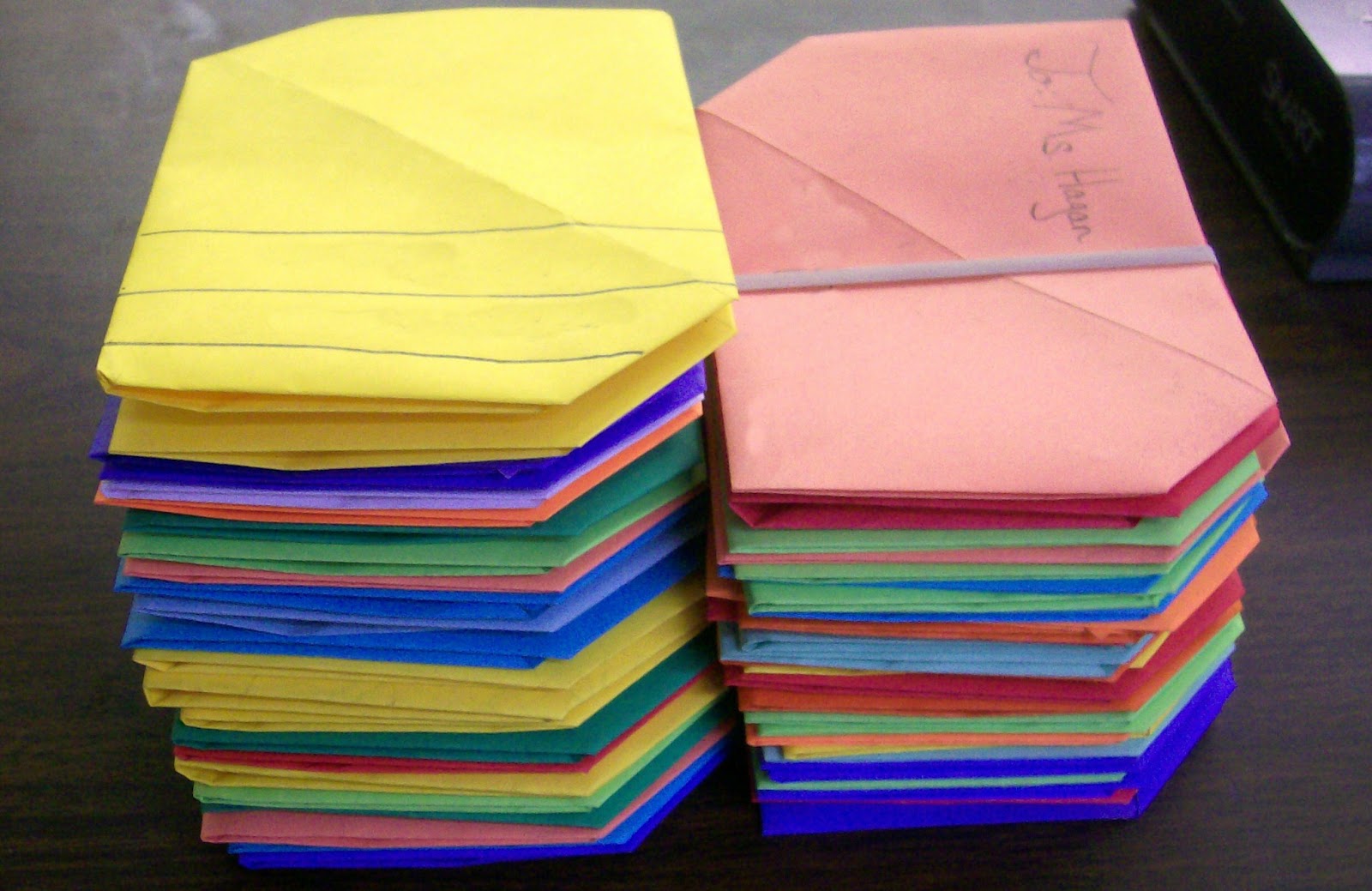
One of my students wrote me this letter.
Ms. Hagan
Thank you so much for teaching me math. You are the best math teacher ever. I never learned math as easy as you teach us. I have never had this good of a grade in math. I hope I have you ever year till I graduate. Thank you for everything.
This is why I teach. This is why I’m at school this week even though I don’t feel 100%. This is why I spend hours creating games and foldables and activities for my students. My students need me. I am making a difference in their lives. And, they are making a difference in my life.
February 14, 2013 – A 3 Hole Punch Story
My students definitely know how to make me smile! Life is definitely never dull around them.
To illustrate that last statement, I have a story to tell. One of my students borrowed my three-hole punch today. She was taking colored paper and using it to create dividers in her binder. Instead of returning it to my desk when the bell rang, she left it on her desk. The next hour, my 8th graders arrive and start working on their bellwork. After completing our “Beat the School” problem, I hear one of my students saying “What in the world is that?” When I look at him, he is frantically pointing at something in front of him. I’m imagining all kinds of terrible creepy, crawly, or yucky things that could be causing this response. No, he is pointing at the three-hole punch. He’s never seen one before in his life. I thought he was exaggerating. No, he was telling the truth. I tried my best to explain the foreign concept of a three-hole punch. Other students started confessing that they didn’t know what it did either. Finally, another student demonstrates the three-hole punch.
Instead of amazement, the questioning student responds with confusion. Why would you need something to punch three holes into your paper? Realizing that I can’t assume anything, I asked the class if anyone else knew what a three-hole punch was. 3 hands. Out of 9. Two-thirds of my class has never used a three-hole punch. Oh my goodness. I attempted another explanation. Do you know what a binder is? It has three metal rings. We use the three-hole punch to punch the holes in the paper so we can put it in the rings. To this, I was told that it was really unnecessary. Instead, my students thought that notebook paper was meant to go in the rings. That’s why notebook paper comes with the holes. Any paper that doesn’t come with the holes is meant to go in the pockets of the binder. Some days I wonder what this world is coming to…
April 1, 2013 – Alive
To all of you who have been wondering, I want to assure you that I am still alive. Seriously, though, the fact that some of you took the time to check up on me really meant a lot to me. If you’ve sent me an e-mail and I haven’t responded, sorry! I’m working on getting caught up, but it’s taking me longer than I expected.
I could blame my lack of blogging of late on a lot of different things. But, I think what it really boils down to is that the first year of teaching is overwhelming. I knew going in that this year was going to be crazy. I just didn’t know in what ways that craziness was going to present itself.
A lot of stuff has happened in my school district that I can’t and shouldn’t talk about on this public blog. And, that’s been hard on me. I want this blog to be a transparent and true reflection of what life in my classroom is like. Every school is different, and every teacher’s circumstances are different. Even though I already knew that, I have learned that this year from experience. My classroom is not perfect. My teaching is far from perfect. And, my school district is not perfect.
However, I shouldn’t let myself stop blogging because I can’t tell you the whole story. That would be unfair to both you and me. I learn a lot about myself from the act of blogging. There is something almost magical about putting one’s thoughts, feelings, and experiences into words. When I write about a lesson, I see it through a different lens. And, that helps me to learn from my successes and failures in order to become a better teacher. So, I promise. I’m going to keep blogging my lessons and reflections.
So, what have I been up to?
Algebra 1 has journeyed through linear inequalities, systems of equations, and part of a unit on simplifying radicals. Algebra 2 has focused on logarithms, sequences and series, and we’re preparing to start on conic sections tomorrow. And, my math analysis students have been working with one-to-one functions and logarithms. We test over logarithms tomorrow, but I’m not sure what the future holds for that group of students. The next chapter in our textbook is matrices. I’m thinking it may be fun to take a break and explore some discrete math, though.
Pi Day was a bit of a disappointment. Two days before Pi Day, I started feeling terrible. My stomach started hurting, and I only felt okay when I was asleep. I barely made it to school on Pi Day. Seriously, it felt like I was dying. Our amazing counselor came and checked on me half-way through the morning and suggested that I go home because I did not look well. I took her advice. I ended up spending five hours in urgent care. They finally ruled out appendicitis. But, they sent me to the emergency room when they could not provide me with a diagnosis. The er doctor told me I had a stomach bug, and I needed to just go home and rest. I’m not sure if that diagnosis was accurate or not. But, I do know that I spent almost all of Spring Break sleeping and resting.
We returned from Spring Break for a four-day week. Our emphasis has turned to EOI review. My students currently have only ten more school days until our state standardized testing takes place. I’ll be honest. I’m nervous. My test scores will tell a story. I’m just not sure what story they will be telling. For my Algebra 1 students, the stakes are high. If they don’t pass, they may not graduate. My students can’t afford that.
My students and I have worked extremely hard this school year. In both Algebra 1 and Algebra 2, I had to reteach a number of concepts that my students should have previously mastered. This means that we are not as far in the curriculum as I would have hoped to be. If you ask any of my students, they will tell you that we have not slacked off this school year. Oh, they wanted me to, but I have not given in. They know that Ms. Hagan does not believe in free days. And, Ms. Hagan does not believe in movies. (Of course, some students think that I literally
I worry, though, about my students who have missed so much school. I worry about my students who struggle with reading at an elementary school level. What will their test scores say? Will they fill like their hard work has paid off or will they feel like a failure? Will college be on their horizon? Or will they start to contemplate dropping out of high school?
Questions. Questions I may never know the answers to. But, I will not let that keep me from doing my job and changing lives.
April 3, 2013 – My New Classroom Pet
Throughout elementary school, I only had one experience with a class pet. The year was fifth grade, and our class had raised enough money to purchase a hamster. At least, I think it was a hamster. But, I guess it could have been a guinea pig. What I do remember, though, is that the animal had one of those wheels in his cage. And, he loved to run on his wheel. We also had one of those balls that allowed him to roll around our classroom. That was always fun, but I’m afraid that we might have spent more time watching where the hamster was going on those days then actually focusing on our work. I’m sure that the hamster had a name, but I can’t seem to remember it.
Anyway, back to the wheel. Our class hamster soon tired of just running on his wheel. So, he decided to learn a new trick. He would learn to balance on top of his wheel. Looking back, he was probably more interested in escaping than balancing… But, balancing on top of a circular wheel is harder than you would think. I guess I’ve never tried it myself, but it was really difficult for our hamster. Every day, the hamster would climb on top of the wheel and fall off. Climb on top of the wheel and fall off. Over and over and over.
Finally, one day our hamster stopped climbing on top of the wheel. We blamed his death on the fact that he had taken too many hits to the head from falling off of the wheel.
Why am I telling you this story? I’m not really sure. All I really wanted to do was tell you about a cool new gadget that I got for my classroom. But, then I had to think of a creative title. I started thinking about classroom pets, and here we are. Sorry for the tangent…
Without further ado, meet my Monkey Multiplier.
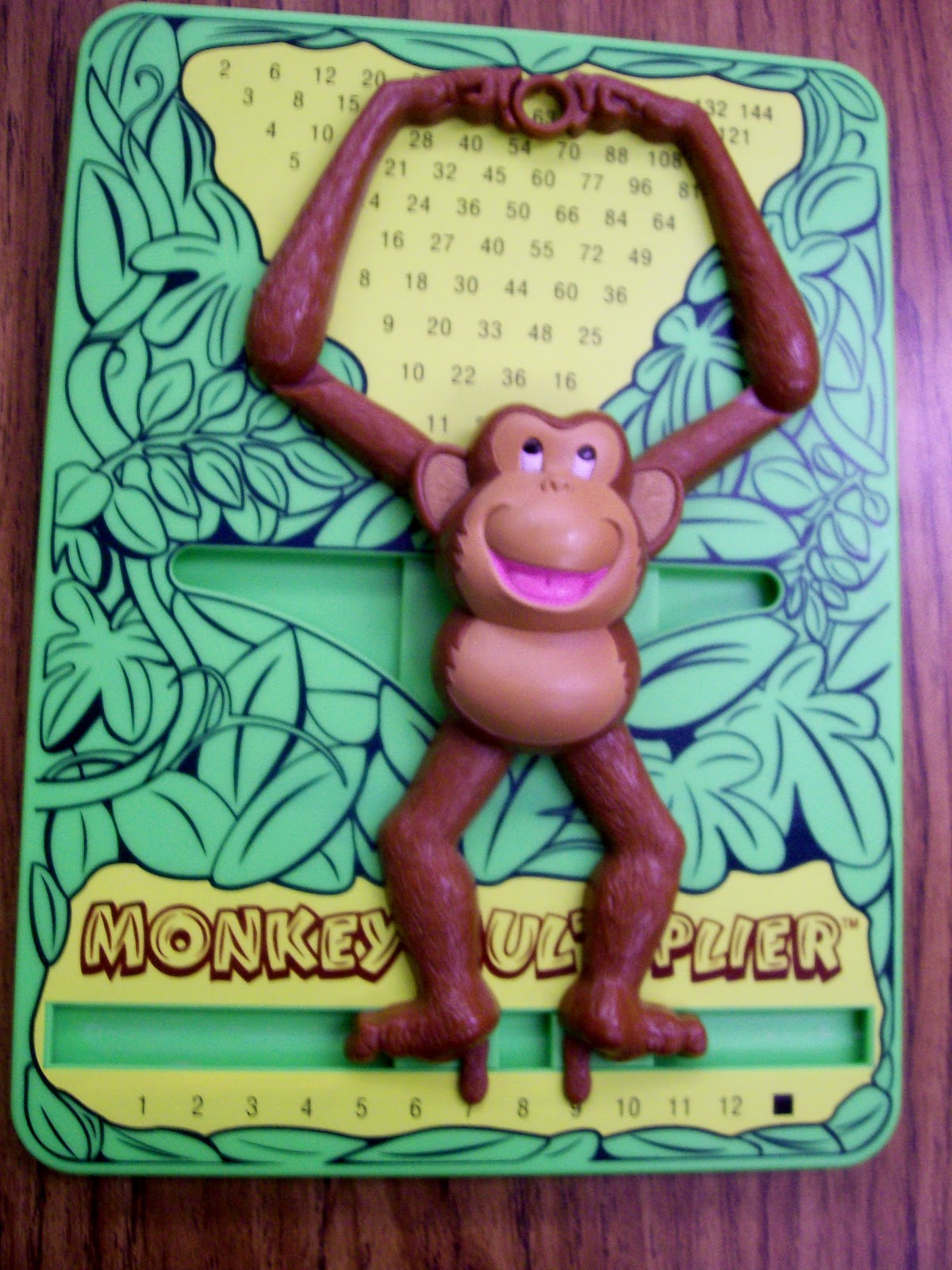
My parents picked up this nifty thing at a thrift store for $1.49. Here’s how he works. Move the monkey’s toes to rest on the two numbers you wish to multiply. If you want to square a number, place one toe on the number and one toe on the square on the far right.
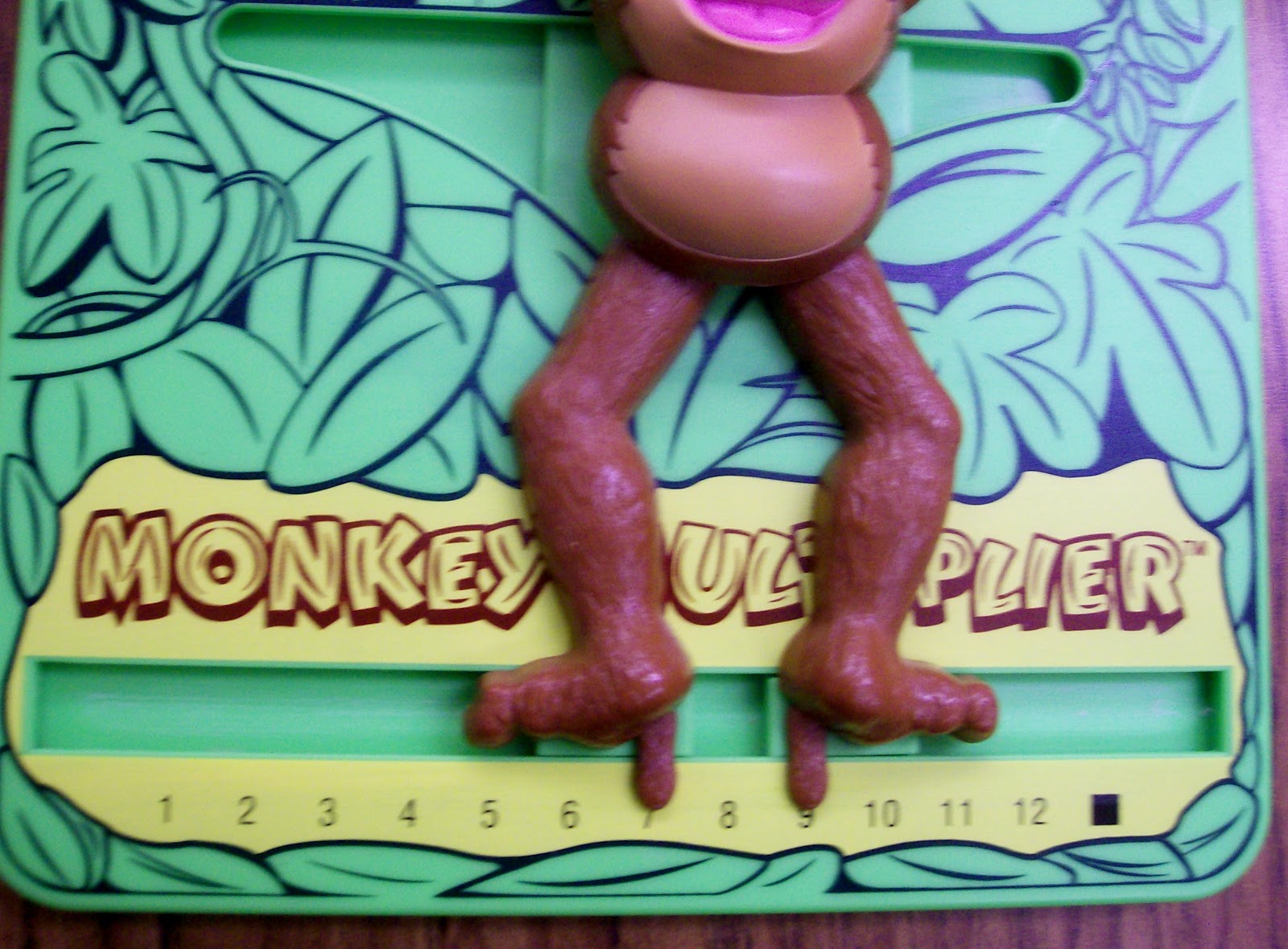
For this example, I want to multiply 7 times 9. To find my answer, I look at the hands of the monkey.
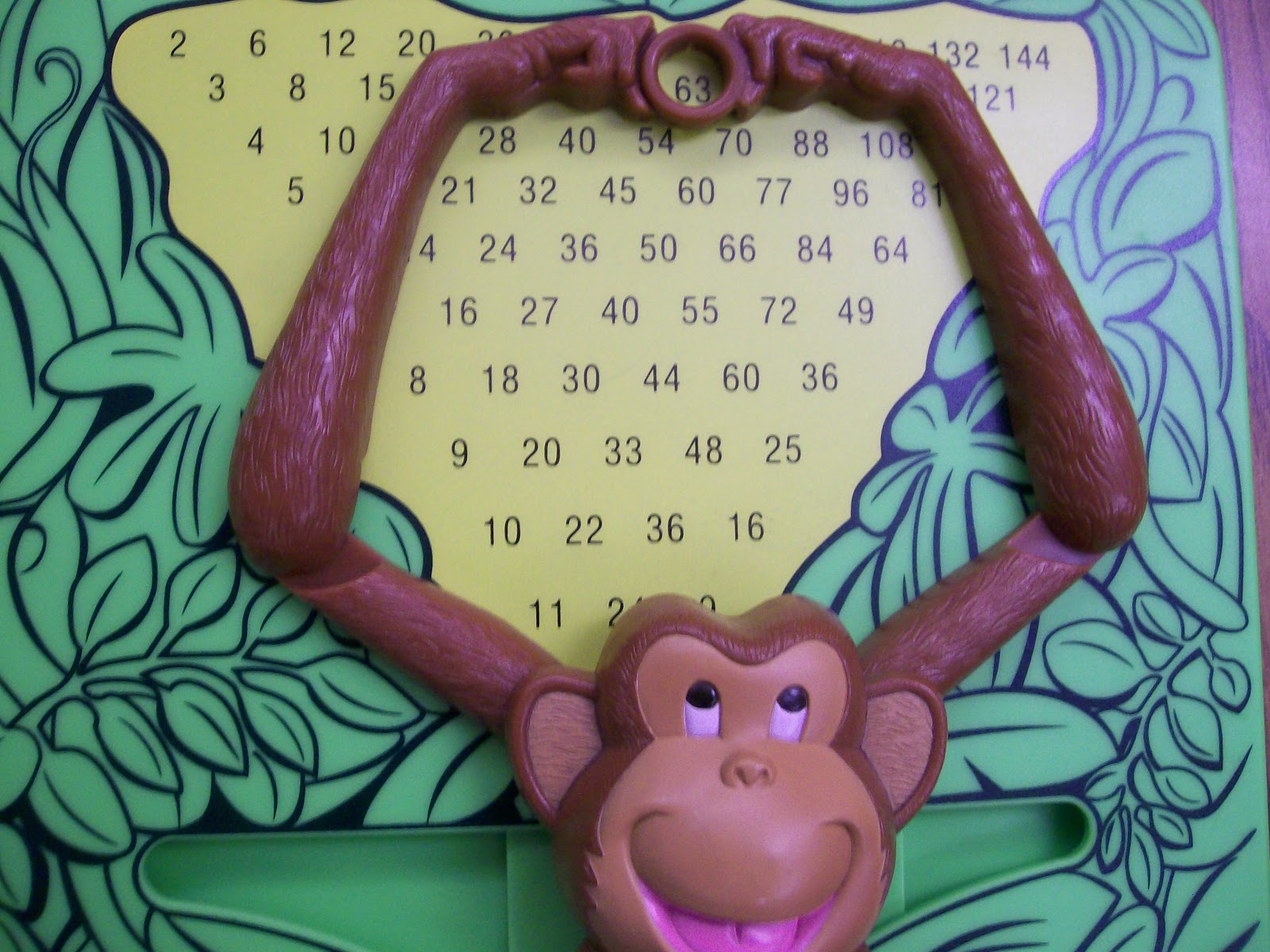
Mr. Monkey has correctly identified 63 as the correct answer. Even though I teach high school, my students are still mesmerized by this toy. I have even had students borrow it to help with an assignment instead of using a calculator. It’s also helped spark some great conversations about how it works. When my students leave my classroom, I hope they will agree that a) math is doable and b) math can be a lot of fun.
April 13, 2013 – Doubts
Lately, I’ve starting having doubts if I actually teach high school.
Evidence:
(These are all actual things I’ve found myself saying this week!)
1. “Please take the cardboard box off of your head.” As review for the EOI, my Algebra 1 students were playing Around the World. One of my class periods was really into the game. I had students yelling when they didn’t advance. After one student lost, I looked over to see him laying in the floor like he was about to have a temper tantrum. Later, I look back over, and he is sitting in the floor with a cardboard box on his head. And, this was no small cardboard box. It was probably 3 feet tall, 2 feet wide, and 1 foot deep. I had gotten some fundraiser material in it for student council. I still can’t figure out why in the world he would feel compelled to place it over his head…
2. “Please stop making pterodactyl noises.” Honestly, I don’t know if they were pterodactyl noises. But, my students said they were pterodactyl noises. And, they were extremely annoying and distracting. How do we even know what pterodactyls sounded like? I’m pretty sure they went extinct a long time before we had the means of recording sounds. And, of course, as soon as one student starting making pterodactyl noises, the other students sitting around him had to start making them, too. It’s really hard to keep a straight face while repeatedly asking students to stop making pterodactyl noises.
3. “Please don’t lick your desk.” One of my students thought it would be more fun to drink his Sprite by pouring small amounts from his bottle into the cap of his bottle and drinking it from there. Another student thought it would be funny to make his desk shift slightly at the exact moment he went to take his drink. The student’s capful of Sprite ended up spilling all over his desk. Not wanting it to go to waste, he decided he would lick it off his desk. At one point, I actually saw his mouth touch the desk. The other students were outraged, too. And, I think their comments may have been more powerful in stopping him than my plea. I would not eat anything that touched the top of one of my students’ desks. They might get cleaned every nine-to-twelve weeks. (Though, I do have one student who brought her own bottle of Clorox wipes to store in my classroom. And, she sanitizes her desk and her friends’ desks every day before class.)
April 15, 2013 – T Minus 10 Hours
T minus ten hours until state testing begins. My Algebra 1 and Algebra 2 students will all test Monday morning. This will be my first time to administer a standardized test. During my student teaching, I had the opportunity to proctor a standardized test. I’m just hoping that we won’t have any technology issues tomorrow…
I don’t know where this past year has gone. A year ago today, I was calling my superintendent to accept this job. A year ago yesterday, I had never set foot in this town that I now call home. I didn’t know where it was on a map or even know how to get here.
My emotions are all over the place right now. I’m scared. I’m excited. I’m terrified. I’m nervous. I’m unsure of exactly how I’m supposed to feel right now. My students and I have worked hard this school year. For my Algebra 1 students, the stakes are high. Students are required to pass the Algebra 1 EOI in order to graduate. My Algebra 2 students don’t have that pressure on them, but that scares me, too. Will they try their hardest if they know they don’t have to pass the test to graduate?
I teach a large number of students who have failed to pass their standardized tests in mathematics in the past. And, I want nothing more than to see them pass. I want them to see that hard work does pay off. I did some research this weekend, and I discovered that my school district regularly performs the worst or second-worst in mathematics in our entire county. I knew that our test scores were low when I took this job, but I didn’t realize that they were that low. My mentors continually remind me that progress is slow. Any progress is good progress. But, my perfectionistic self has a hard time accepting that. I want instant change.
Sadly, some of my students have chosen not to put in ample work to master the concepts of the course. And, I believe that will also be reflected in their test scores. A small number of students chose to not complete our review assignments. I’ve reminded them constantly that the need to try their hardest. If the students don’t pass, they will take Algebra 1 again next year. I’ve tried my hardest to prevent this, but I think I have some students who need that in order to be successful in the long run.
I’ve been told by some that my test scores directly reflect my effectiveness as a teacher. Others have cautioned me to not read too much into my test scores because they reflect the education my students have received over the course of their school careers. So, I don’t really know what to think.
But, I have a feeling I will shed some tears tomorrow, though. Tears of joy and tears of sadness.
May 1, 2013 – Addicted
The end of the school year is CRAZY. And, it’s definitely reflected in my blogging or lack thereof. During my student teaching experiences, I never really got to experience the last few weeks of school. Our finals were always over long before the local middle schools and high schools released for summer. We have seven days left of school and one professional development day left before summer. I’m having a really hard time comprehending the fact that I am almost finished with my first year of teaching. Where in the world has this year gone???
EOI tests are over. And, I’m incredibly thankful for that fact! My Algebra 1 and Algebra 2 students did extremely well. I am incredibly proud of them and what they have accomplished this school year. I have a reflective blog post in the works on this topic.
I’m pretty sure that if I sat down and wrote 49 more blog posts this evening, I *might* feel caught up on this blog. There are so many lessons and funny quotes and experiences that I want to share with everybody. I just need more time. Hopefully, I will be able to carve out the time for that this summer. But, it looks like my summer is already filling up with workshops and trainings and church activities.
My students and I are becoming addicted to origami. We’ve went through almost 500 pieces of origami paper in the last two weeks. During EOI testing, our schedules were crazy. I would see some class periods and not others. And, even if I saw a class period, there were always a few students who were absent or testing. I decided that I would use this time to introduce my students to origami. One or two of my classes experimented with making cubes from sonobe units earlier this year. But, this was the first time for many of my students to complete an origami project. (I guess we did make origami envelopes earlier this year, though.)
I did have a few students who figured out that origami wasn’t their thing. So, I gave students the option between creating an origami model or completing 8 KenKen puzzles. I did have some students opt to complete the KenKen puzzles. Some students even did both.
Even though most of my students have been taking their origami projects home with them, I have still managed to collect this many origami projects on my desk. I think they’re multiplying!
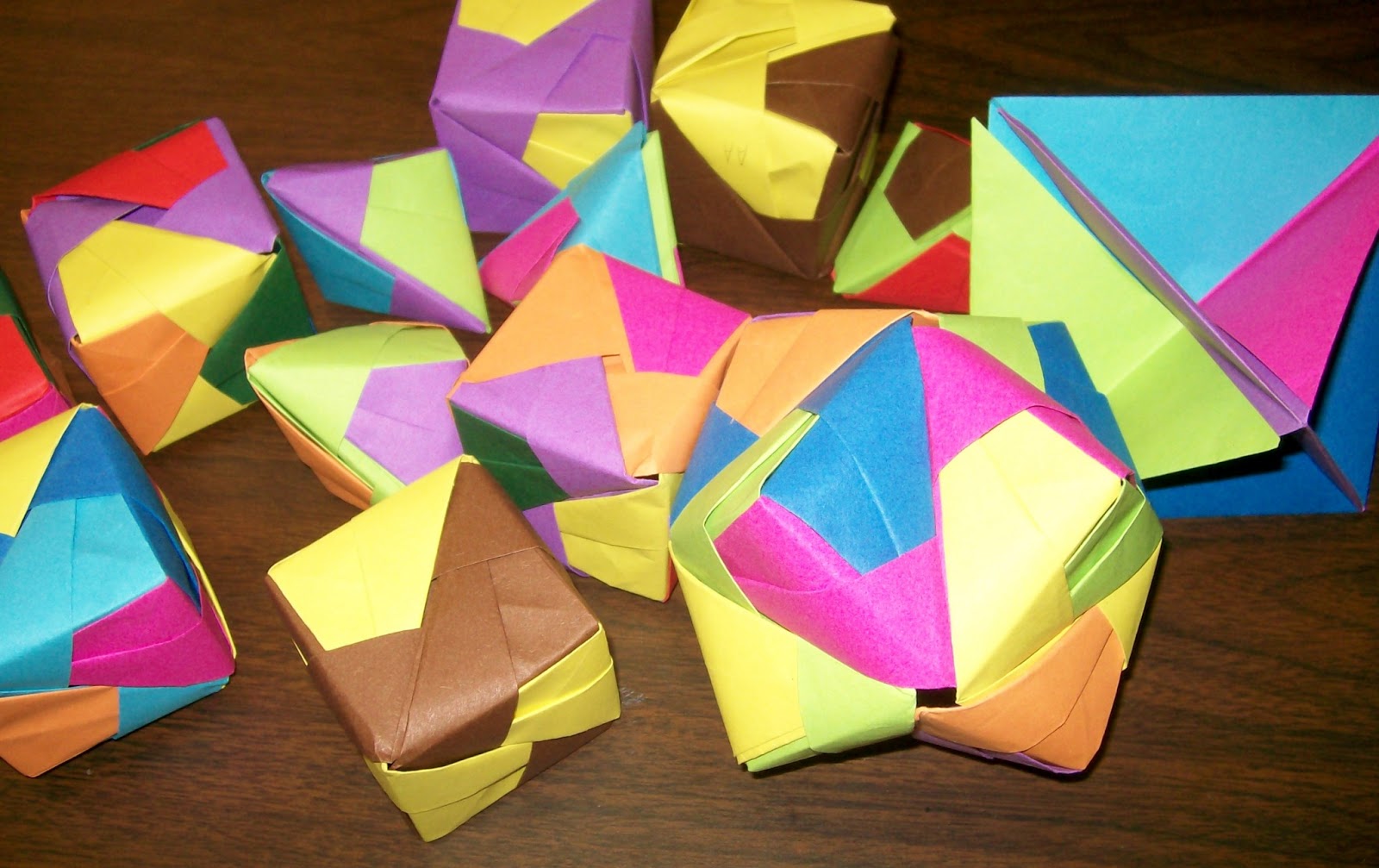
I’ve started an origami section in my personal library. My students love to look through these to find potential projects. I love looking through them, too.
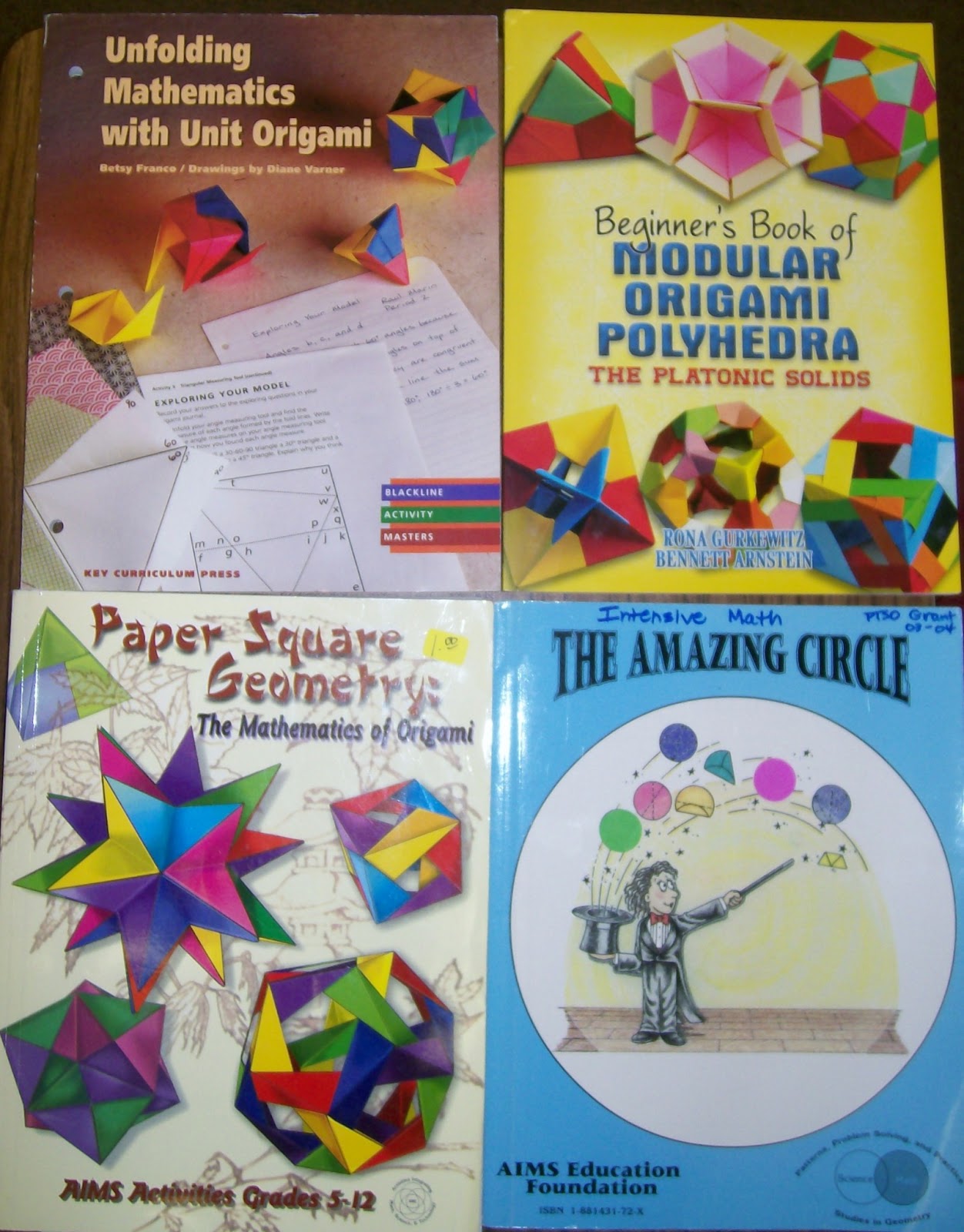
May 11, 2013 – Year One Finished
I’m officially done with my first year of teaching! It feels so weird to write those words. I’m no longer a first-year teacher. Well, I guess I’m not really a second-year teacher yet. I feel like I’m in that awkward in-between stage… This year went by way faster than I imagined possible. It seems like I was just learning my students’ names a few weeks ago.
I’ve been slowly taking everything down off of my classroom walls and bulletin boards this week. Of course, this started rumors that I was leaving and not coming back. I had to reassure them that I was planning on coming back. It felt good knowing that I would be missed if I left. Though, I am disappointing druinok by not applying for a job at her school…
I’m excited to create new bulletin board designs and posters for my classroom this summer. I spend a lot of time in my classroom, and I want to enjoy my scenery. At the beginning of this school year, walking into my room would bring a smile to my face. Over the course of the year, that newness wore off. So, I’m hoping to regain some of that magic by changing things up. I will definitely reuse a lot of the posters. But, I hope to add lots of new stuff, too. I want my new group of students to feel like they are coming into a classroom that has been prepared just for them. And, I want my old group of students to stop by to say hi and see what’s the same and what’s different.
It was really funny to see my students reactions when they walked into my de-decorated classroom. Without all of the bright colors and posters, it’s just kinda bland. Students would walk in and exclaim that something was wrong. One girl told me that my room looked naked without anything on the walls. They would repeatedly say, “I don’t like this.”
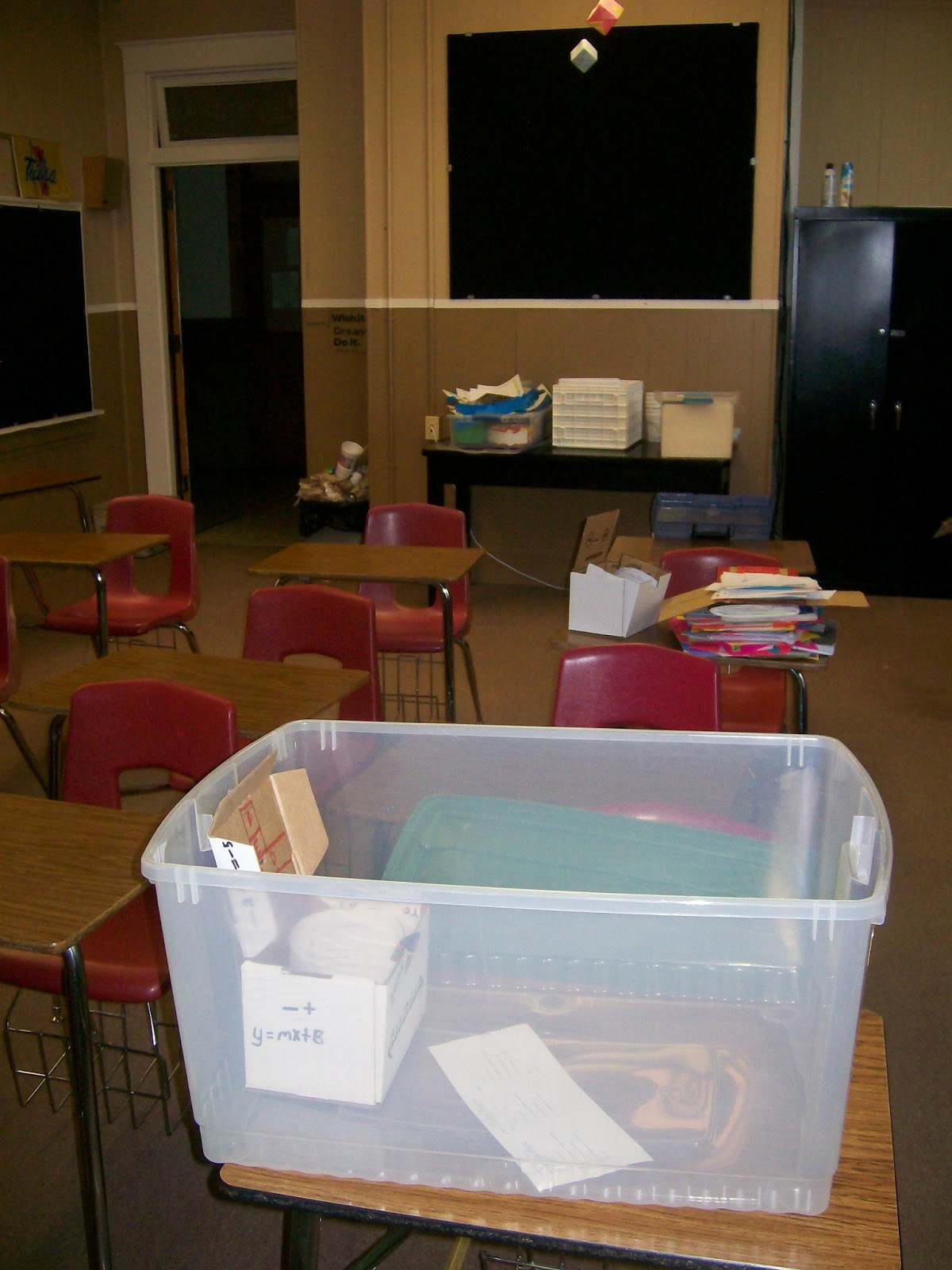
Students notice these things. I am one of only two math teachers at my high school. The other math teacher and I have completely opposite opinions about what our classrooms should look like. I have lots of brightly colored bulletin boards, posters, and student artwork covering my walls. I even have origami hanging from my ceiling. The other teacher has clean, empty walls. I can see benefits to both, but I don’t think I could ever give up my festive decorations.
I shouldn’t have to spend near as much time getting my room ready this summer. Last summer, I had to paint the classroom, hang a dry erase board, hang four bulletin boards, and move several pieces of furniture. This will give me more time to revamp my curriculum to reflect everything that I have learned during this whirlwind of a year. Here in Oklahoma, we have one more year where our students will be tested over our state standards. However, I need to start transitioning to the Common Core State Standards at the same time. I want to start this next school year with my entire curriculum mapped out for the year. This is something that I really wasn’t able to do this year.
Tomorrow is graduation. Five of my students will be graduating and moving on to their next adventure in life. I am excited for them and sad to see them go at the same time. As I have more and more students go through my classroom, I’m sure the graduation ceremony will become more and more emotional. In a few years, I should reach a point where every single student in the high school will go through my classroom.
May 12, 2013 – Summer Reading List
In order to celebrate my first full day of summer vacation, I’m hoping to start attacking my summer reading list. But first, it will be my pleasure to attend my first graduation ceremony as a teacher. I helped set up for graduation yesterday during our professional development day. This will be a new experience to me because I’ve never attended a small high school graduation before. I used to think that I attended a small high school, but I graduated in a class of 153. We will have 32 walk across that stage.
I’ve made a list of all the books that I own and haven’t read, the books that I’ve started and haven’t finished, and the books that I’ve read but need to read again. Typing this list out made me realize just how many books are on my to-read list. I highly doubt that I will be able to get through all of these this summer. Plus, I plan on reading some fun novels, too.
As I make my way through each book, I hope to share any useful strategies that I plan on implementing in my classroom. My first year of teaching went really well, but I want to make sure that my second year is even better. I read a lot of books on teaching last summer. And, I found them helpful and confusing at the same time. They were helpful because I was hungry to learn anything I could use to help me in my classroom. But, it was confusing because many authors seemed to contradict the other authors. Now that I have a year of teaching under my belt, I feel like I will gain a lot from rereading those books that I read last summer. But, I have a lot of new books I want to read, too.
Books to Reread and Implement in my Classroom
* Teach Like a Champion by Doug Lemov
* Never Work Harder Than Your Students by Robyn R. Jackson
* Teaching Outside the Box by LouAnne Johnson
* Realm of Algebra by Isaac Asimov
* The Essential 55 by Ron Clark
* The First Days of School by Harry Wong
* Every Minute Counts by David R. Johnson
* Tools for Teaching by Fred Jones
Books to Finish Reading
* Getting Things Done by David Allen
* The Tipping Point by Malcolm Gladwell
* Making Thinking Visible by Ron Ritchhart
* Inspiring Active Learning by Merrill Harmin
* Mathematics Formative Assessment by Page Keeley
* Styles and Strategies for Teaching High School Mathematics by Edward J. Thomas
* Flatland by Edwin A. Abbott
* Why Do Buses Come in Threes? by Rob Eastaway
New Books to Read
* What Successful Teachers Do In Diverse Classrooms by Neal A. Glasgow
* Where Great Teaching Begins by Anne R. Reeves
* The Write Tool to Teach Algebra by Virginia Gray
* Mathematical Snapshots by Hugo Steinhaus
* The Quality School by William Glasser
* How to Win Friends and Influence People by Dale Carnegie
* Journey through Genius by William Dunham
* Statistics for the Utterly Confused
* Teach Like a Pirate by Dave Burgess
* A Framework for Understanding Poverty by Ruby K. Payne
* How to Support Struggling Students by Robyn R. Jackson
* Discipline Survival Kit for the Secondary Teacher
If you think I might have a slight addiction to books, you’re right. I’m obsessed. I love to read.
May 14, 2013 – Thinking Inside the Box
Instead of giving my students a semester test, I assigned a project. The project was to create three interactive notebook pages of their own. Each page should focus on a different concept we studied this school year.
I told students that these projects would be graded on creativity, colorfulness, inclusion of a foldable or graphic organizer, inclusion of example problems, and mathematical accuracy.
Other than that, I didn’t give students much guidance. They were allowed to look in their own interactive notebooks for inspiration. However, I did warn them that they would lose major points if they simply copied a page out of their notebook and turned it in. I showed them my secret stash of colored paper. I’m pretty sure I have an addiction. But, when Amazon has colored paper and cardstock for $3-5 per ream in their Warehouse Deals section, I just can’t pass it up. My students don’t seem to mind the 13+ reams of different colors to choose from, though.
A few students asked for rulers. One student needed a compass to draw a perfect circle. Others chose to borrow various circular items from the classroom to trace around.
One student, however, took a different approach. She went straight to my supply cabinet. When she began rummaging through my various boxes of supplies, I didn’t stop her. I simply watched. She found a small package of rubber bands that were meant for a geoboard. I told her she could use them as long as they didn’t end up flying across the classroom. Next, she started looking through every single box for a must-have supply: popsicle sticks. That’s one thing I don’t keep in my classroom. Lucky for my student, our science teacher keeps a supply of popsicle sticks and was willing to share. Finally, the student asked for a specific box that was holding scrap paper in my cabinet. Curious to see what would become of these odd supplies, I took out the scrap paper and gave her the box.
For the next two days, this student worked diligently on her project. She claimed that it was top secret and refused to let me see it until she was done. When this student had extra free time during the day, she would come to my classroom to retrieve her project to work on.
There were repercussions, however. When one student starts decorating a box instead of a sheet of plain notebook paper, the other students in your class tend to want to decorate their own boxes, too. Luckily, I had recently collected and emptied donation boxes from Student Council’s recent Pennies for Patients change drive for the Leukemia and Lymphoma Society. So, I had a box of boxes for them to choose from.
Here is the final result:
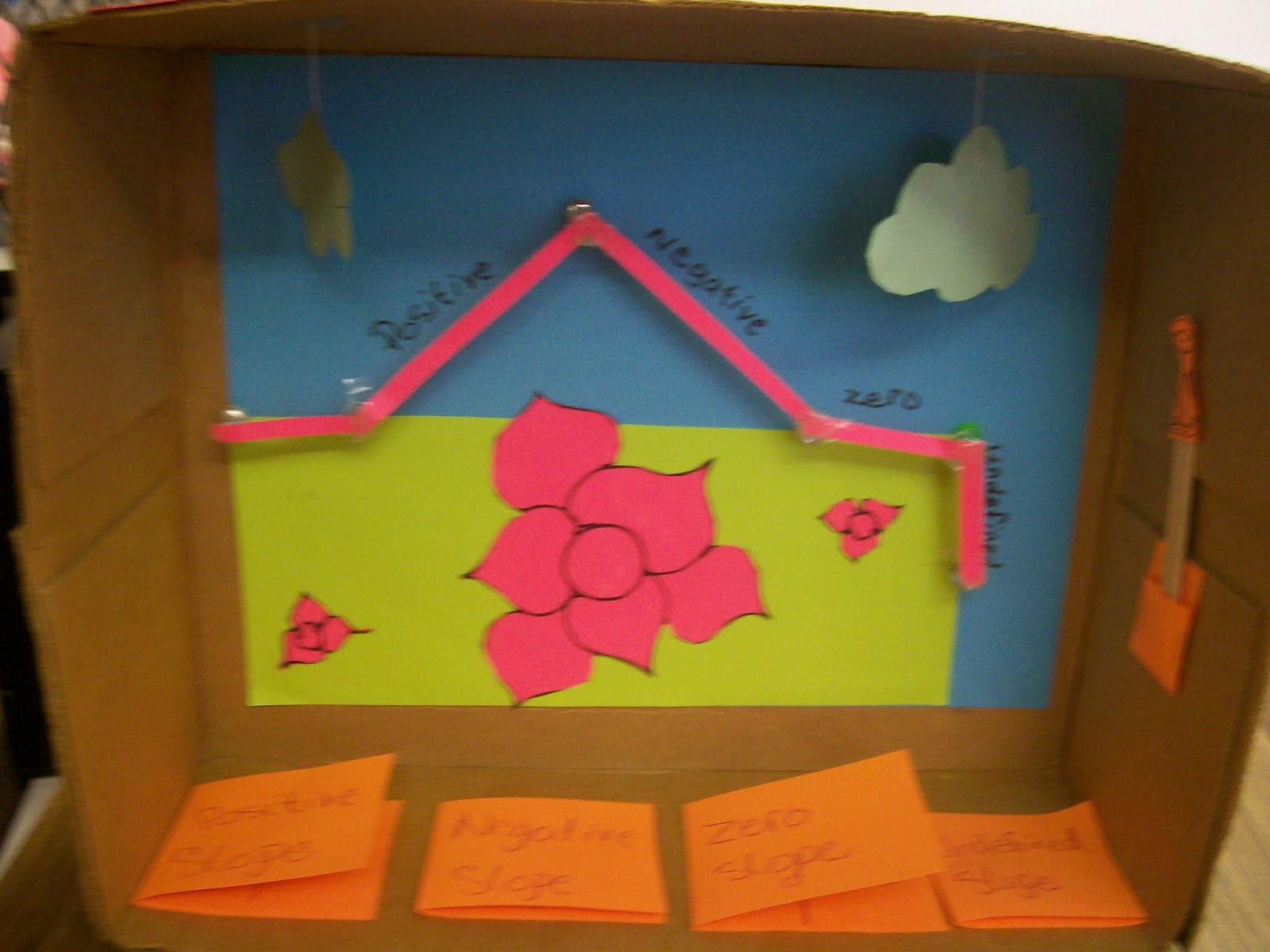
There were foldables for each of the four types of slope.


If you couldn’t tell from the first picture, the clouds are actually hanging from the ceiling of the box! The box tells the story of Slope Dude’s journey.
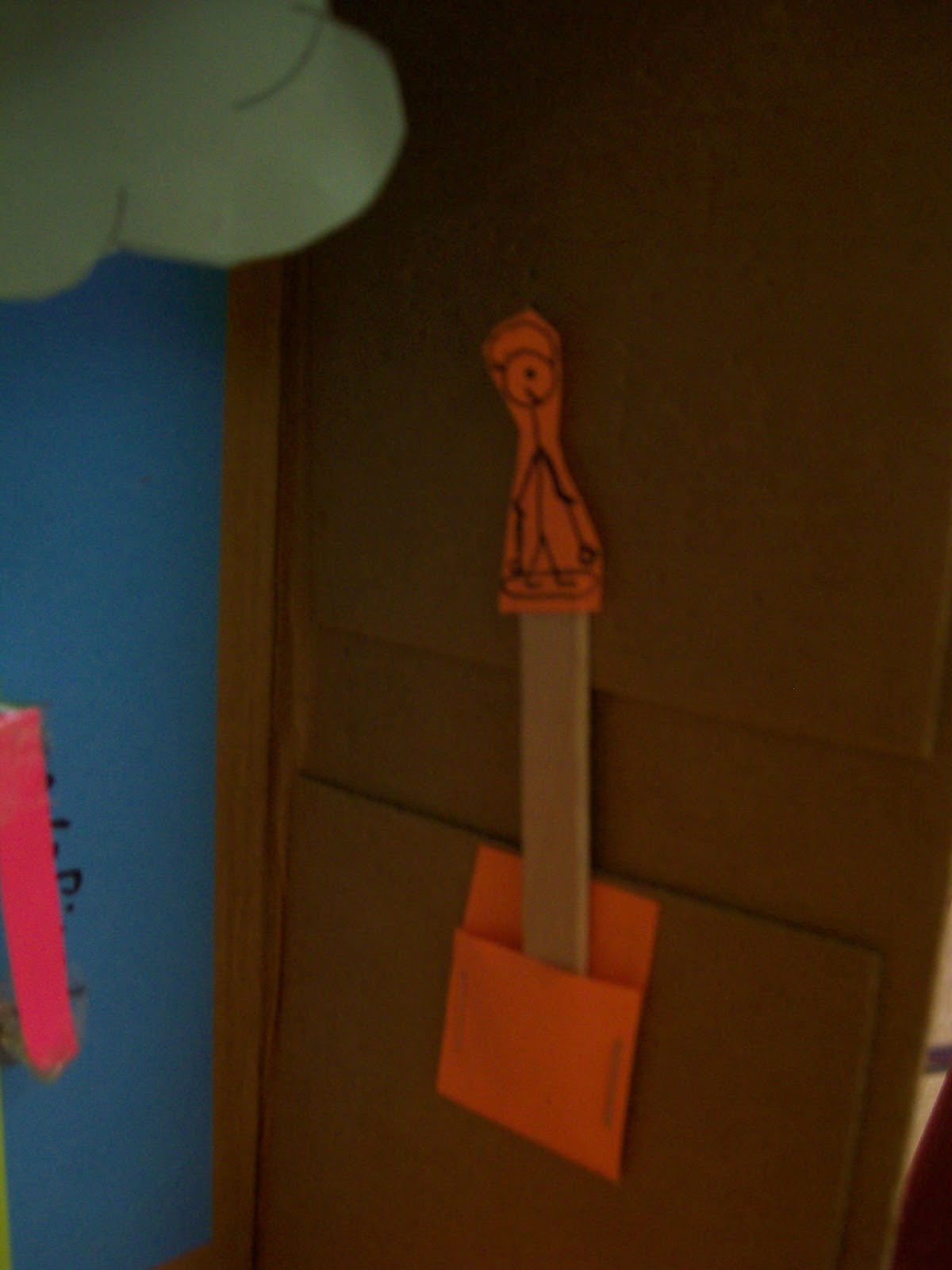
I think my favorite part of this box is Slope Dude. He has his own pocket on the side of the box to hang out in when he is not skiing the slopes. Now I see why she needed a popsicle stick…
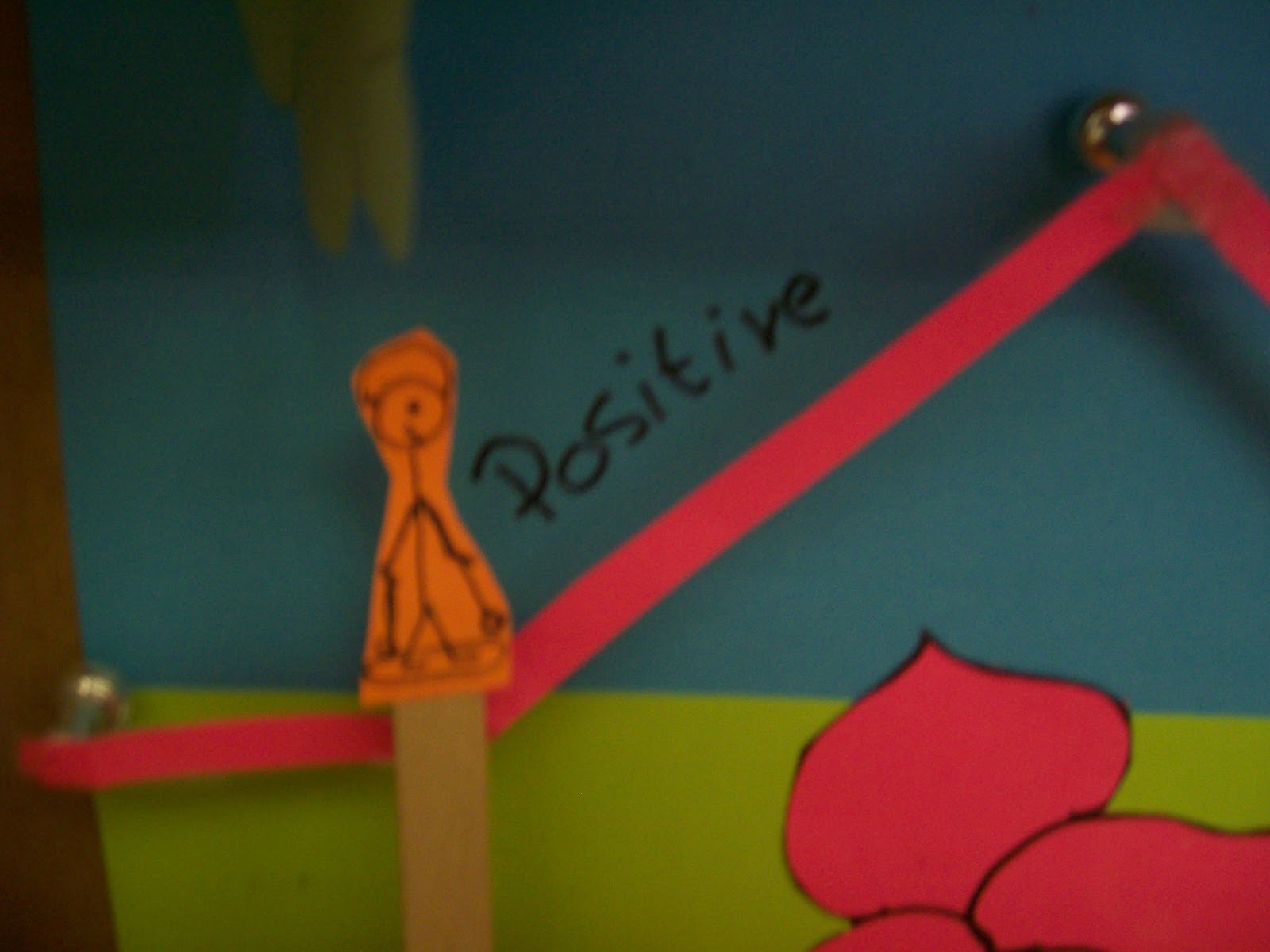
If you want to teach someone about the four types of slope, all you have to do is take Slope Dude out of his pocket. Using the course that has already been set up, one can quickly re-enact the story of Slope Dude.
I knew Slope Dude had made a major impact on my students. And, this was only one of many projects submitted that included Slope Dude in some form or fashion. I’m at the point now where I can’t imagine teaching slope without Slope Dude.
Though I was thoroughly impressed by this project, my student was exhausted. She had finished one out of the required three parts of the assignment in the same time that many of her classmates had finished all three parts. She vowed that she was going to be lazy with the last two parts.
Instead, she decided to take on an even bigger challenge. Remember that box of boxes? Well, by this time, the supply of small boxes had been depleted. But, the large box that had been holding the small boxes was still sitting in the corner. And, this was a pretty large box. It was probably 3 feet by 2 feet by 8 inches.
Ready to be amazed by what she produced?
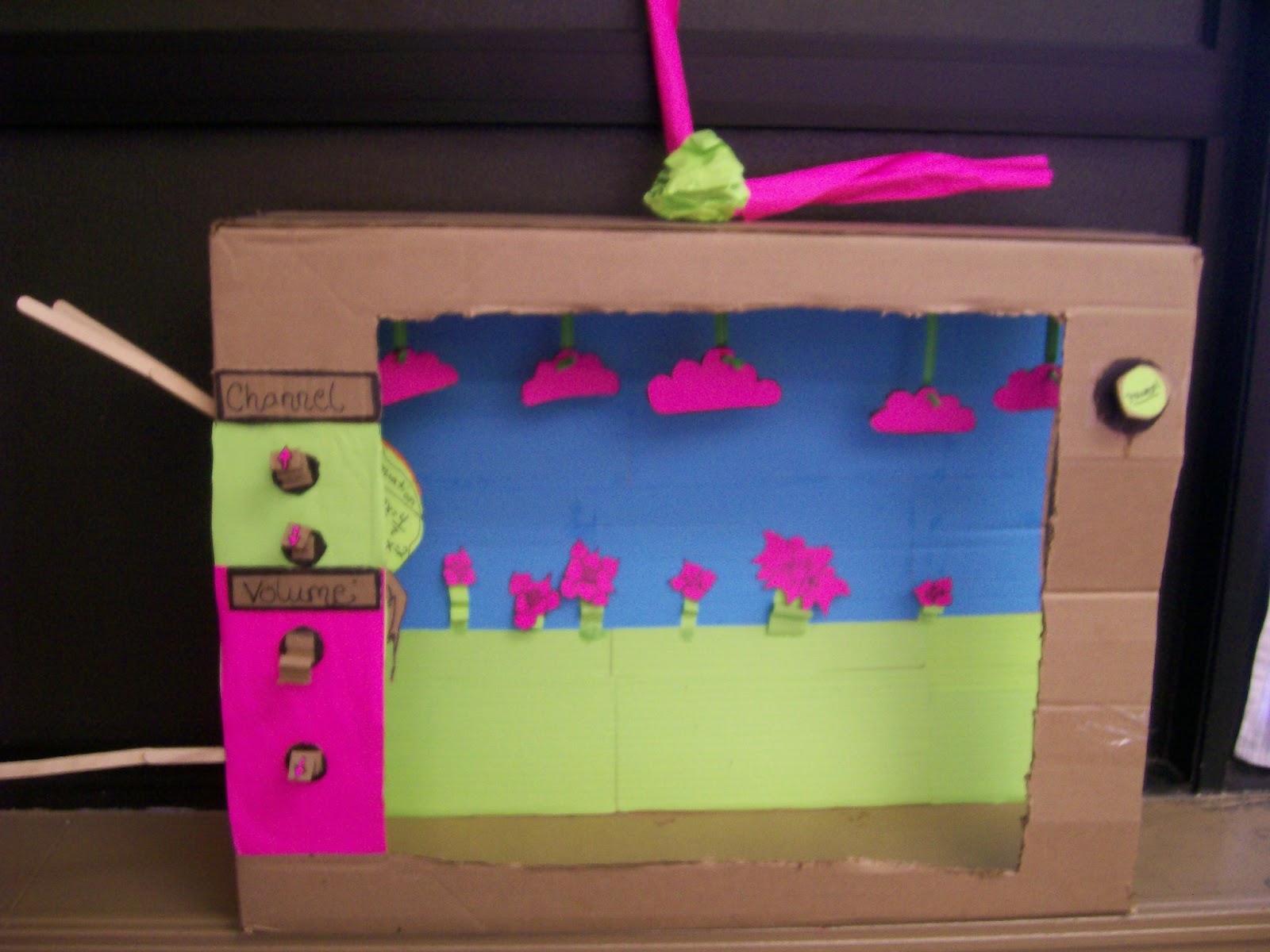
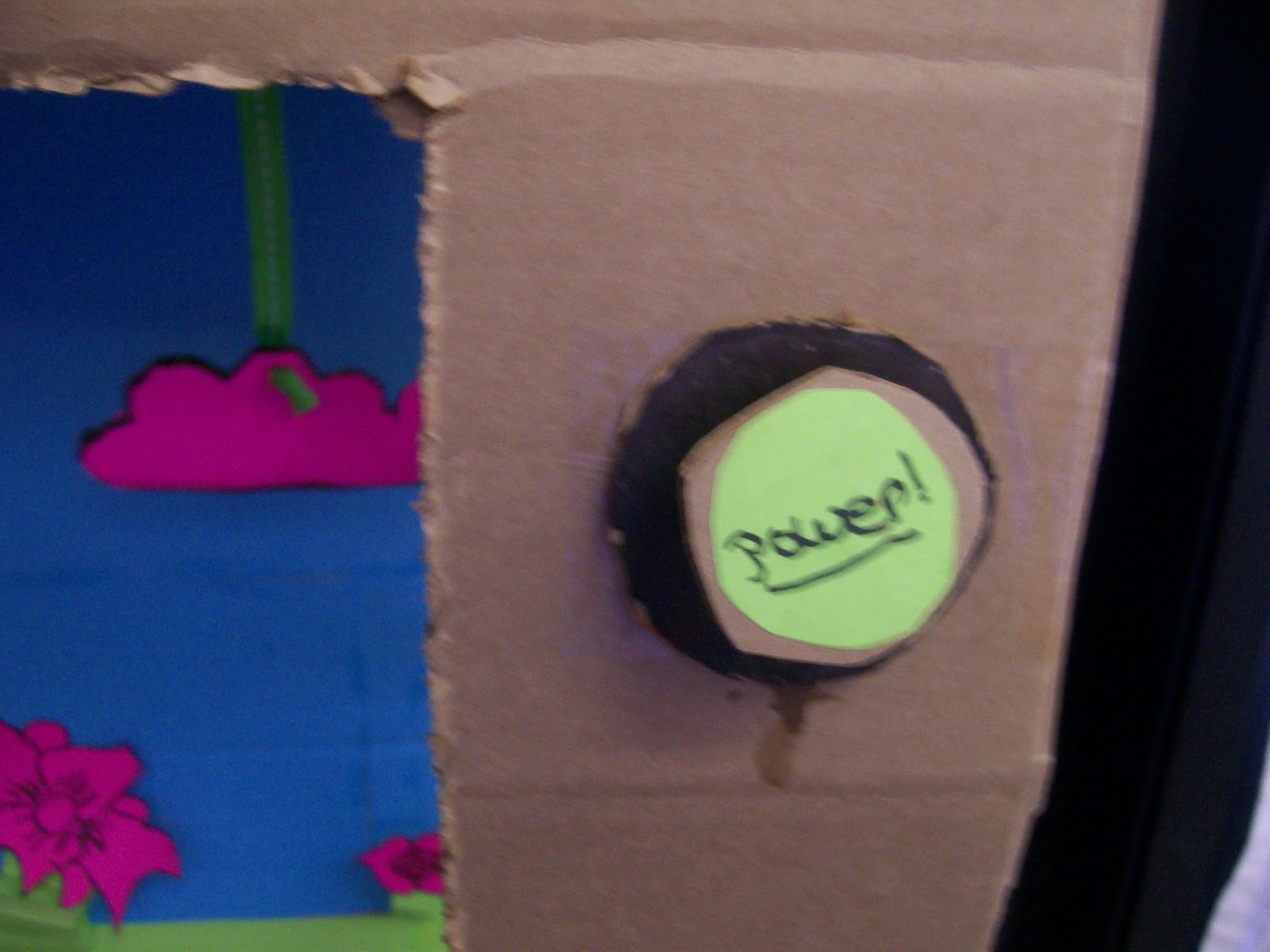
The power button is attached with a cardboard spring mechanism so it “works.”
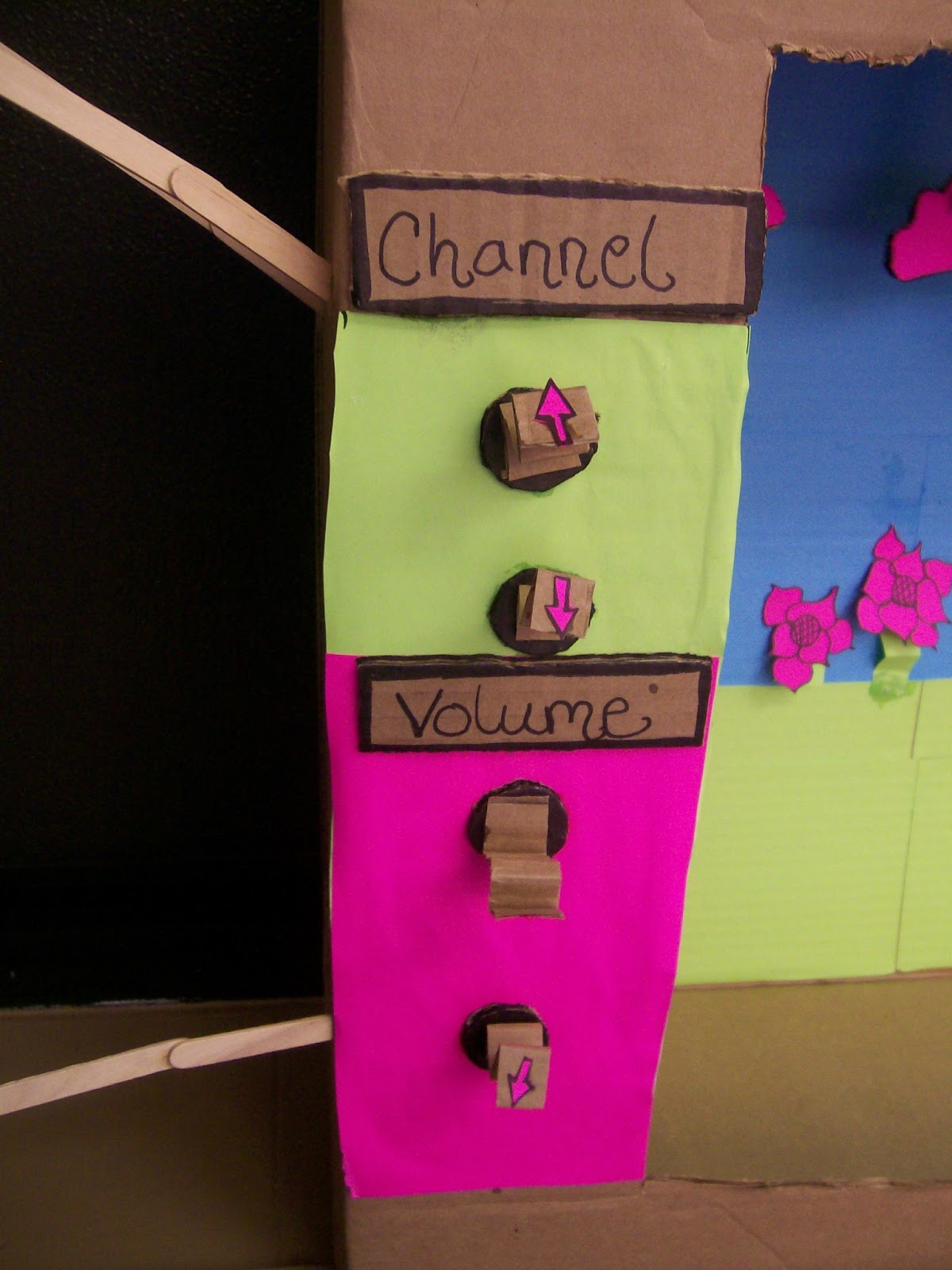
The volume and channel buttons are made with similar mechanisms. This project features amazing attention to detail!

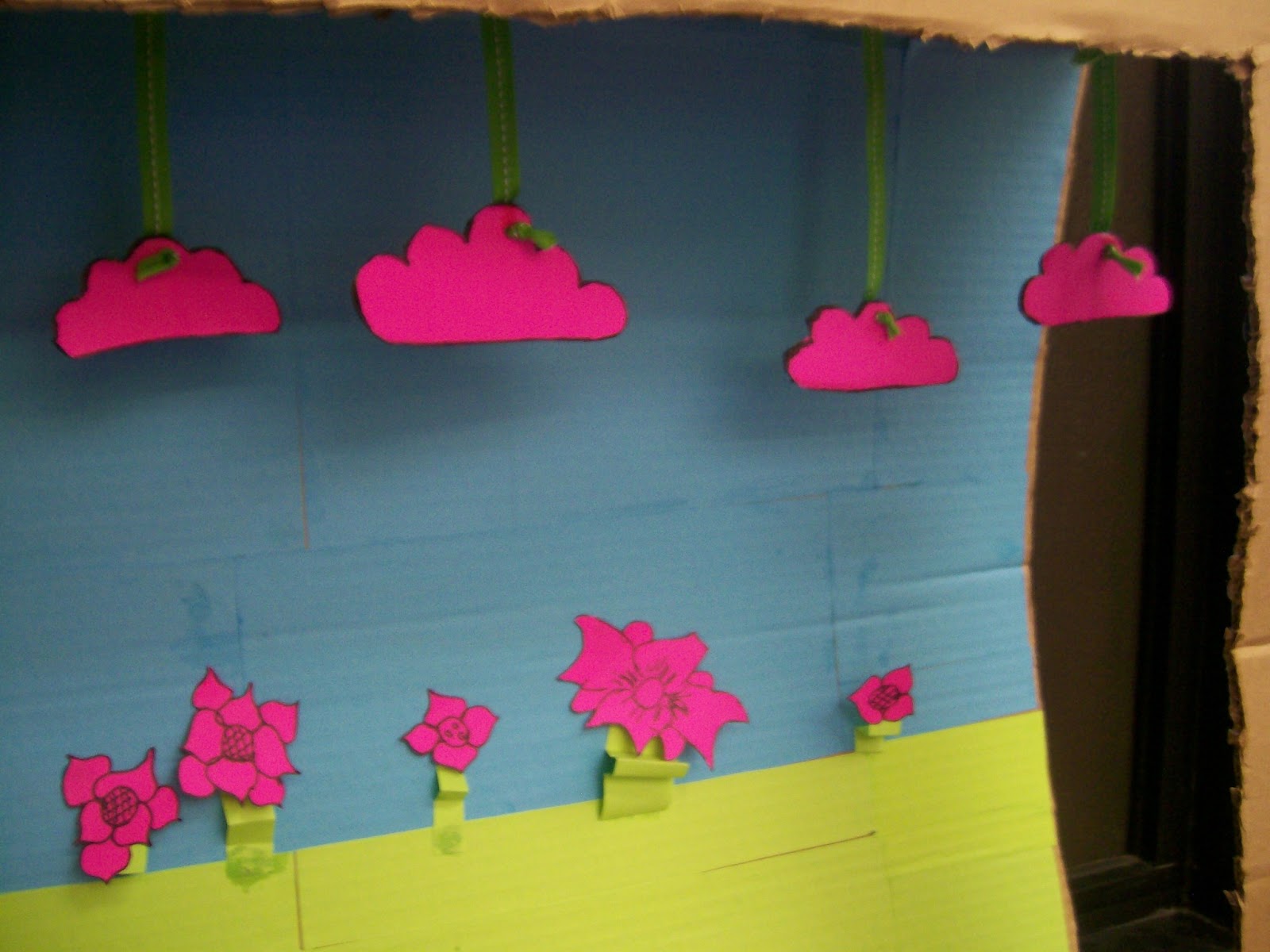
Hanging clouds and flowers complete the background for the reporter’s news story.
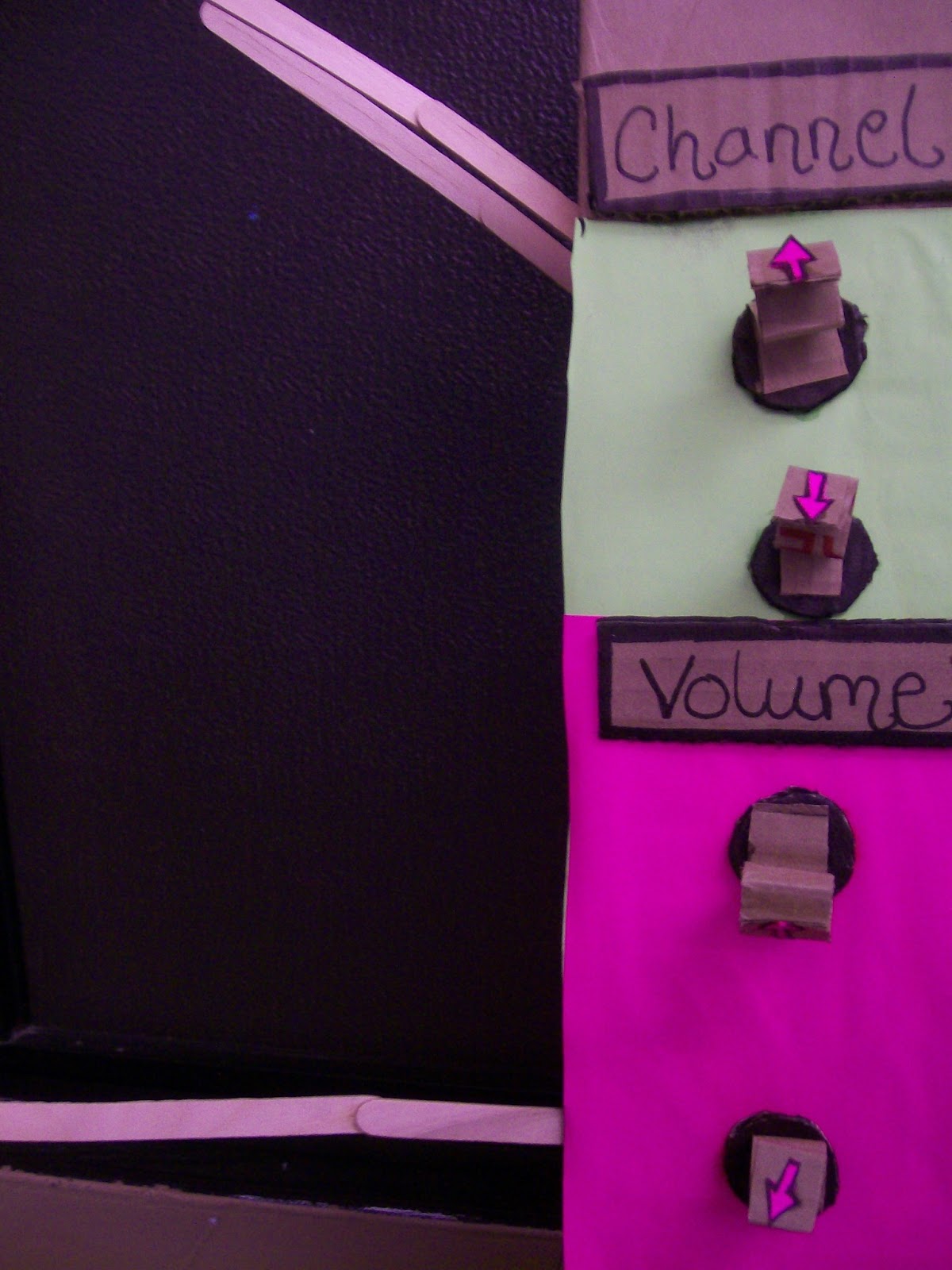
The reporter and her news stories are controlled by these popsicle stick controls.

The bottom popsicle stick control brings out the reporter. Her first news story is on how to solve two-step equations.
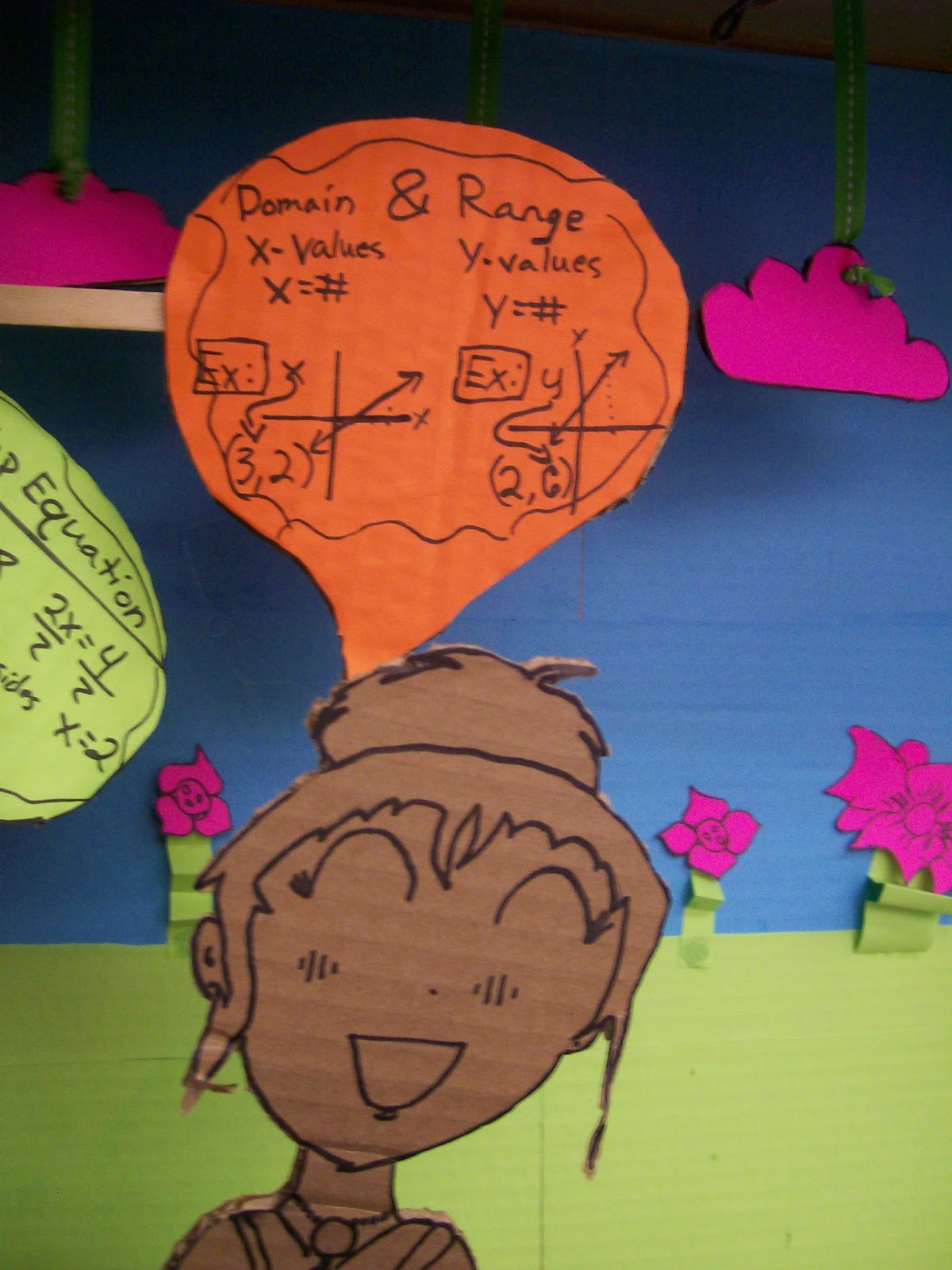
The reporter’s second news story focuses on the concepts of domain and range.
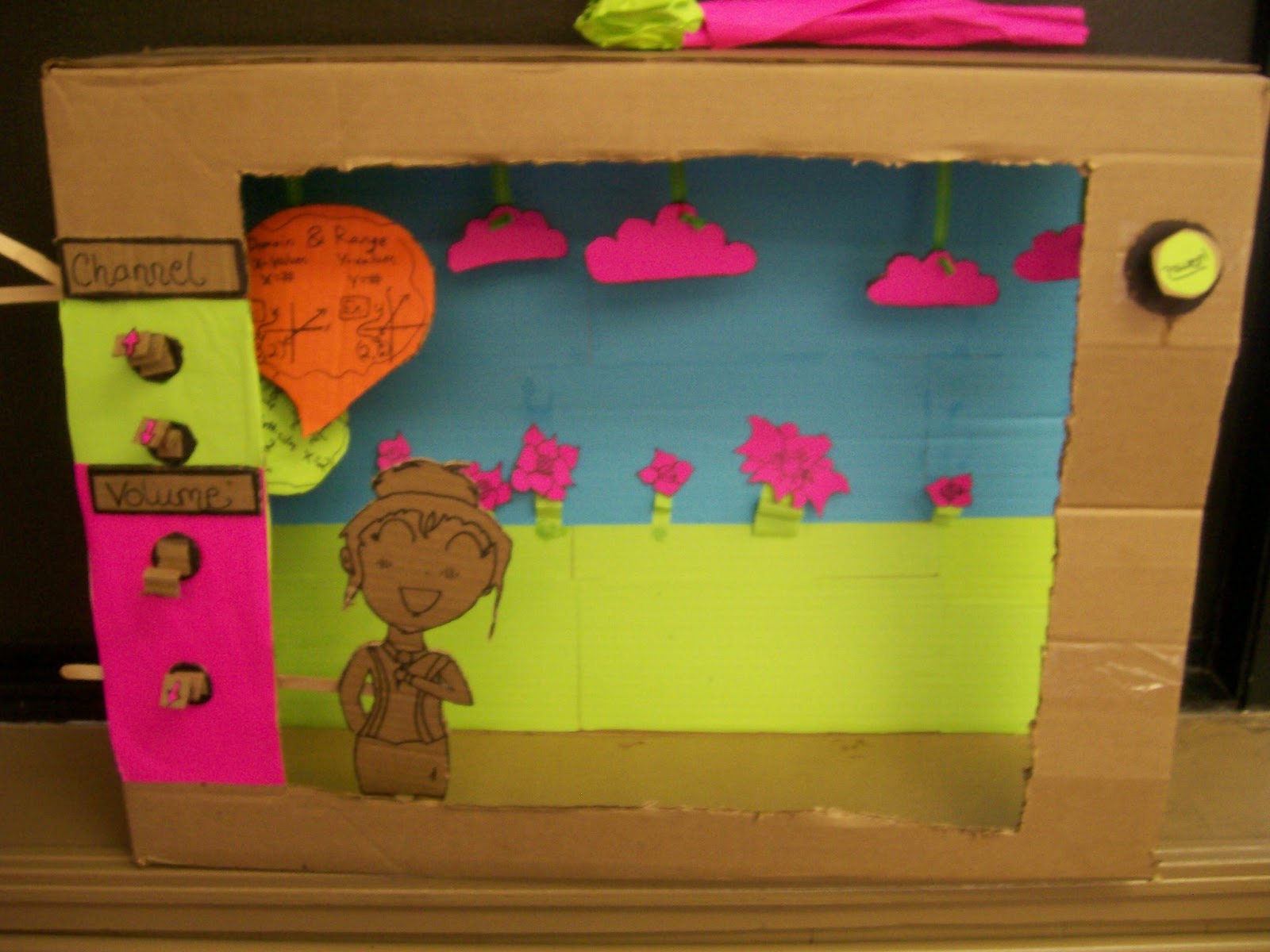
While all of my students were amazed by these two projects, several of them couldn’t help but ask why? Why would you go to all this work when you could have gotten full credit for just designing a colorful foldable with examples and gluing it to a piece of notebook paper?
My student’s answer surprised me. “In high school, you don’t get many chances to be creative. So, when you get the chance, you need to take advantage of it.”
How may times have I stifled my students’ creativity? This summer when I was planning my interactive notebooks, I wanted students to be responsible for creating the left hand pages. But, I never gave them the chance. I told myself that I didn’t have enough time. There was too much to cover. Students would make mistakes. It would be too messy. I made up excuse after excuse.
Next year, I want to give my students more freedom. I want to give them more opportunities to be creative. I want them to think outside the box sometimes. And, there’s nothing wrong with thinking inside the box, either. Because, as this post demonstrates, students will rise to the occasion. And, they’ll surprise you.
I want to throw my fears out the window. I am the type of person who wants/needs to be in control. But, sometimes the most learning happens when things don’t go as planned. The learning process is hectic, chaotic, and messy. And, when I try to remove those elements from my classroom, I am doing myself and my students a disservice.
I feel it necessary to note that these two projects were not done by an A student. They were done by a student who has the potential to be an A student. However, this student was actually in danger of not passing Algebra 1 if she did not do well on this project.
Here are some other projects that were inspired by my student who chose to think inside the box.
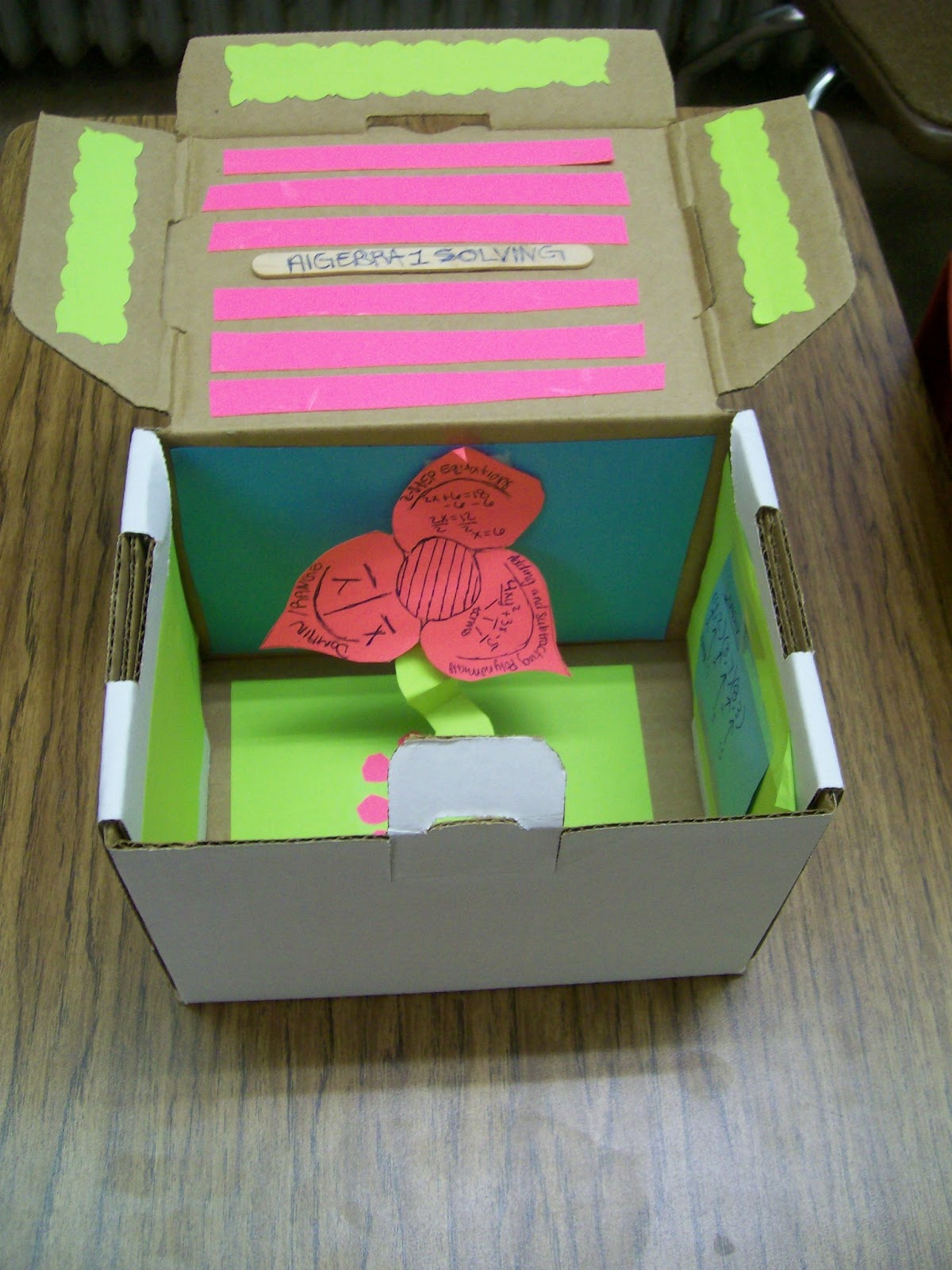

Each flower focuses on a different concept from Algebra 1.
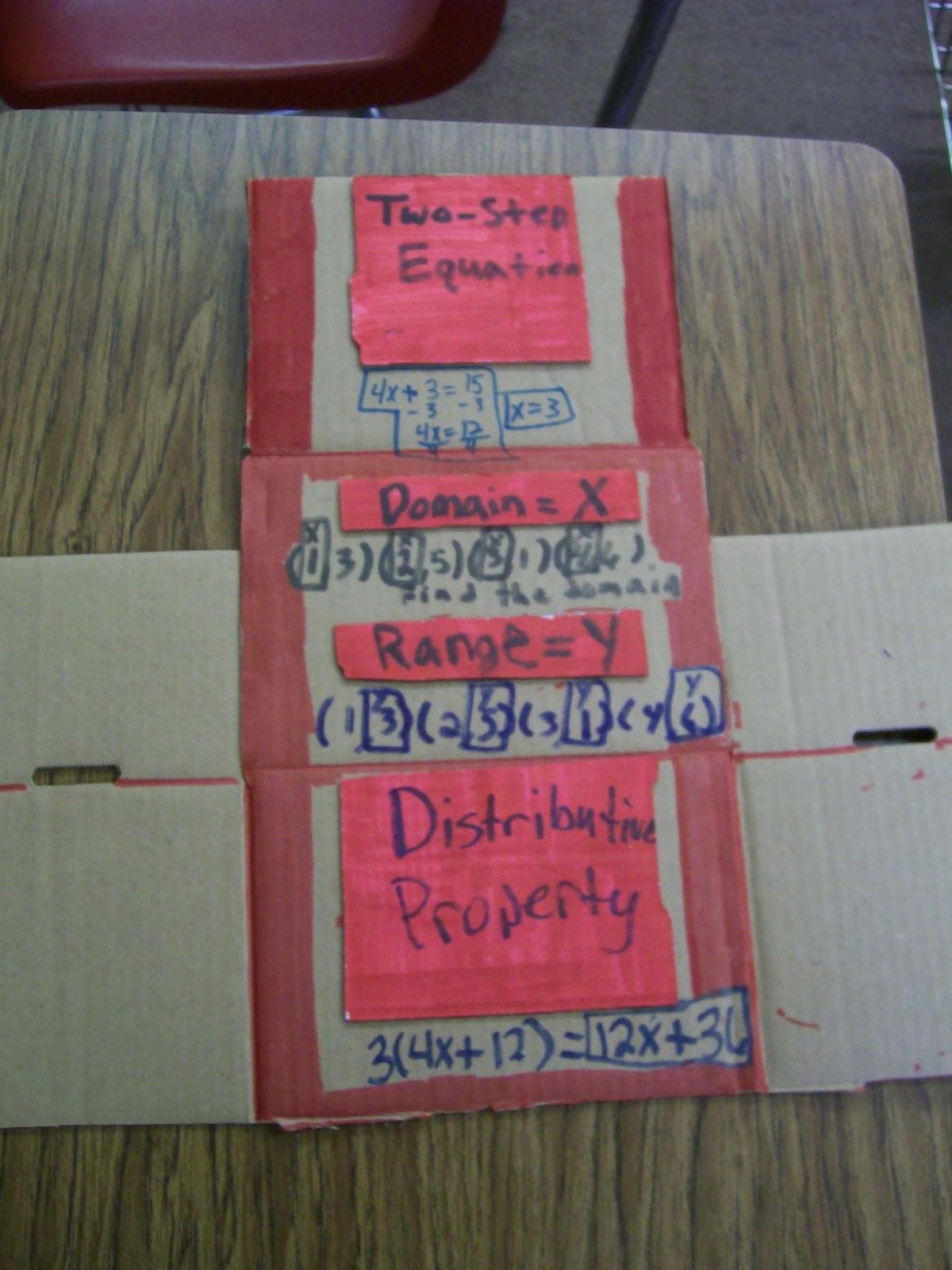
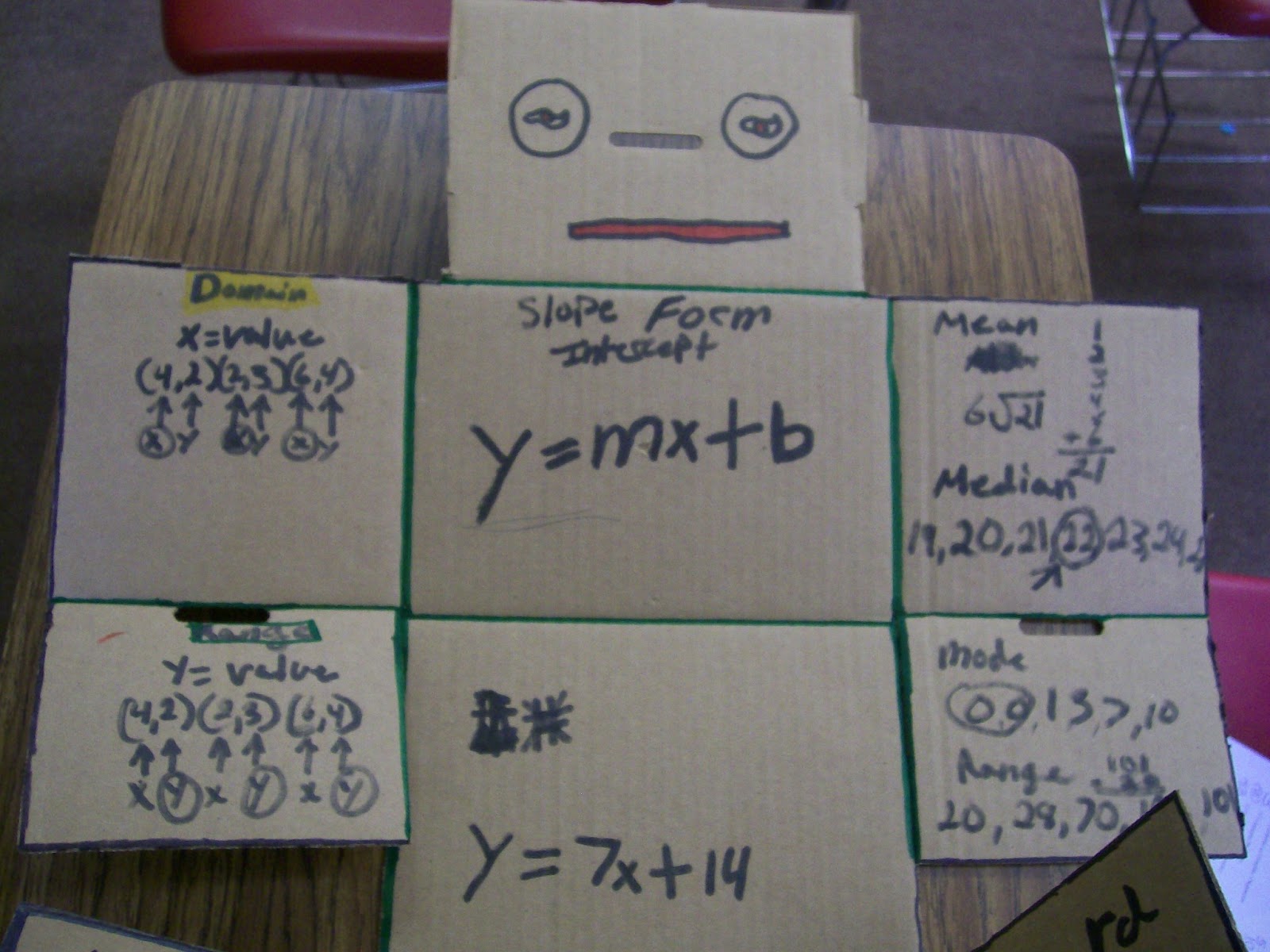
I believe this is supposed to be an Algebra robot…
May 15, 2013 – Algebra 2 Advice
Want to feel like an amazing teacher, mediocre teacher, and terrible teacher all at the same time? Ask your students to write a letter of advice to future students taking the class.
Though I asked for advice for a future student, I was actually looking for feedback on how I am doing as a teacher. I have an entire list of things I know I need to work on. But, it’s different hearing it in the words of a student. My Algebra 2 class this year was small. Second semester, I had 12 students. A large percentage of these students made it clear that they did not want to be there. It was a daily battle to get them to stop talking, sit down, and get to work.
As a first-year teacher, I made a rookie mistake. Whenever one of these students would misbehave, I would call them out on it in front of their peers. I would stop my lesson in an attempt to get them to refocus. When that didn’t happen, I would start to lose my patience. I made the entire class pay for the unwise decisions of a few. Instead of disciplining these students, I was rewarding them. I gave them what they wanted–the attention of the entire class. No wonder they never seemed to learn their lesson. I was rewarding them and punishing my other students in the process.
In one of the books I’m reading this summer, the author talks about how she always asks students to step out in the hall before confronting them. When I first read this, I thought it was a crazy idea. After all, if I did that I would spend more time outside my classroom than inside it. But, then again, maybe not. When I deprive my misbehaving students of their audience, maybe there won’t be quite as much misbehaving.
Last summer, I spent a lot of time reading about classroom management. But, I didn’t go into my classroom with a plan. This summer, I want to create a classroom management plan that fits my teaching style and philosophy. My students deserve a more conducive learning environment than I provided them with this year.
I do believe I made a difference in the lives of my students this year. Every single one of my Algebra 2 students passed their EOI exam. Every single one of them. 100%. Last year, the pass rate was 39%. I did some good things, and I bolded them below. But, I’ve got lots more to work on.
“Your hard work will pay off and you will learn more then you ever know by the end of the year.”
“This class will probably start out as fun and easy, but make sure you work just as hard, as if it were trigonometry or calculus. Because if you do this at the beginning of the year, it won’t be too hard at all to continue to do that to the end of the year.”
“Algebra 2 has its ups and downs, but it can be really fun…”
“It can be really easy, but how easy it is depends on your attitude and your determination.”
“Algebra 2 is hard. You want to pay attention to everything! Come to class everyday because if you miss one day, you will be confused for the rest of the year!”
“Make sure you learn to use your graphing calculator really good because it will pretty much save your life.”
“The last piece of advice I have for you is that if something seems easy just stop because you are probably doing something wrong.”
“Be willing to think.”
“If you don’t know how to do something, don’t be scared to ask for help.”
“Don’t backtalk the teacher. Seriously don’t. It’s stupid. You’re just wasting your time and everyone else’s. When the teacher tells you to do something, just shut up and do it. Again, you’re wasting everyone’s time.”
“Take your Algebra 2 class very very seriously…Do not goof off, or anything at all. Pay attention and shut your mouth! Teachers mean it man. They serious.”
“Treat the math book like your personal Bible. Come prepared and shut up!”
“First off you do not want to talk. You should pay attention all the time. Algebra 2 is very difficult anyways so if you don’t pay attention you will struggle more than you should.”
“If I had to retake the class I would pay attention in class a little better than I did.”
“You must be an extremely fast learner. Nothing is easy if it seems easy then you are wrong.”
“You must never talk or you will get in trouble.”
“DO NOT act like [a certain classmate] in class at all because once you do she will get aggravated and have less patience with your class all because one person. Remember it only takes one person to ruin it for everyone else.”
“Do not be afraid to ask questions. Everyone asks questions and Ms. Hagan will explain very well and show you what your doing wrong.”
“Also take chance to make corrections on the tests. Coming in during lunch also helps a lot with learning chapters you struggle with. You should also keep track of all your homework and turn it in. They are small grades but they all add up.”
“And last piece of advice is keep calm during EOI time and have [patience] with your teacher because she will be stressed.”
May 16, 2013 – Summer
My list of things I want to accomplish this summer is filling up fast.
* OCTM (Oklahoma Council of Teachers of Mathematics) Conference – 1 day
* OGAP (Oklahoma Geometry and Algebra Project) – 5 days
* Pre-AP High School Math Workshop – 4 days
* AP Statistics Summer Institute – 4 days
And, those are only the conferences I plan on attending. I’ll be directing my church’s Vacation Bible School for the second year. And, I’ll be taking a group of 3rd-6th graders to church camp for a week this summer.
Other to-do items:
* Decorate Classroom
* Create Algebra 1 Curriculum Map
* Create Algebra 2 Curriculum Map
* Algebra 2 INB Ideas
* Plan Statistics Curriculum (New Prep!)
* Decide if I want my statistics students to keep a notebook
* Start Common Core Transition Process (The OGAP Project will help a lot with this!)
* Come up with a better process for word walls for Algebra 1 and Algebra 2
* Create a classroom management plan that I can actually stick with
* Find a method to assign student jobs for next year
* Catch up on blogging and responding to comments/e-mails
* Write bylaws for Student Council
* Create community service requirements for NHS
* Plan staff development opportunities for 2013-2014
* Fully implement my new filing system
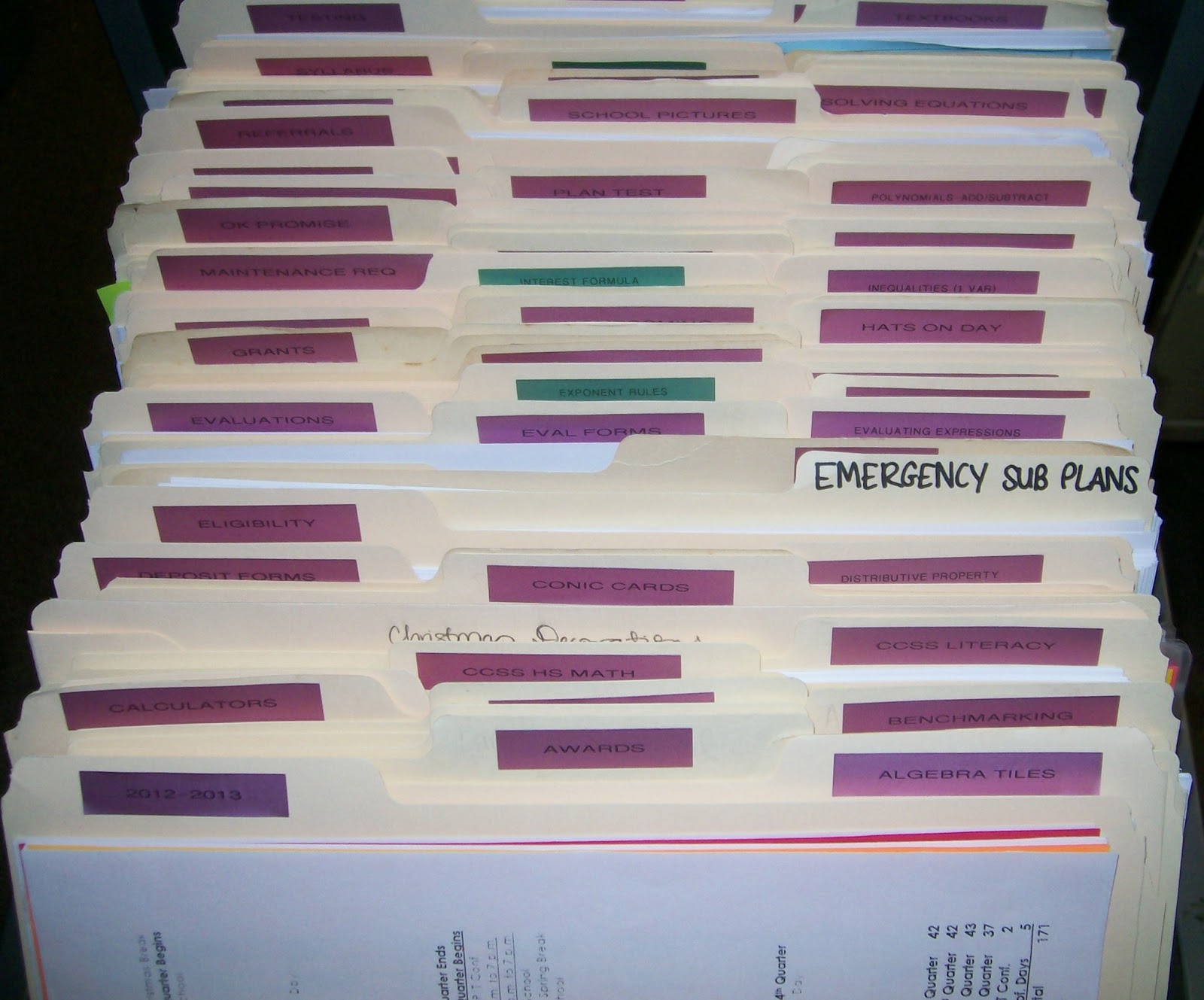
My label maker and I are becoming very close. 🙂

Then, I have my summer reading list to conquer.
May 18, 2013 – Awards
We had our awards assembly on the afternoon of the last day of school. Considering the fact that we have an attendance problem at our school, this was probably not the best idea. Many of our students just chose not to show up for school on the last day of school. Others chose to skip out right before the assembly began.
For Algebra 1, I gave two awards. I gave one award to the student with the highest Algebra 1 average. This student was very deserving. But, it was also her second time to take Algebra 1. Last year, she did not pass the end of instruction exam at the end of the year. So, she was required to retake Algebra 1 concurrently with Geometry.
I also wanted to reward a high-achieving student who was taking Algebra 1 for the very first time. The student with the highest average in this category was also very deserving. She worked extremely hard all year. In the past, she had not done well in math. She doesn’t like school, and she is very vocal about it. But, this year, she made an exception for Algebra I. She kept the perfect notebook. She did every single homework assignment. She asked questions when she didn’t understand things.
She challenged me as a teacher this year, and I’m thankful for that. Every time I tried to play review games with her class, it would fail miserably. You would think I would learn, but I didn’t. And, every time this student would get frustrated with the review game, she would announce, “Ms. Hagan, I don’t think I’m learning a single thing.” As painful as that is to hear sometimes, it’s something I need to hear as a teacher. I wish I had a bunch more students who were willing to speak up when my presentation approach does not meet their needs.
Next year, I want to give my students more opportunities to vocalize whether or not something is helping them to learn. Because, that’s what it’s all about. It doesn’t matter how fun an activity is if it isn’t helping my students to learn.
Anyway, back to the awards assembly. I walked up to the podium to announce who will be receiving my top student awards. I gave the award to the top Math Analysis student and the award to the top Algebra 2 student. I announced my first Algebra 1 winner, and no one rises from their seat. I announce my second Algebra 1 winner, and no one rises from their seat. I find this hard to believe because I had asked this student if she would be there just hours earlier. I had done everything but tell her that she was going to be receiving one of my awards.
After the assembly is over, I look up and am surprised to see my missing student approaching me. She has a question to ask me. “Can I still have my award? I was too scared to go up there and get it.” I’m not sure if this student has ever won an award before. I proudly presented her with her medal, and I shook her hand. It breaks my heart to think about what must have been going through her mind as she sat there in the auditorium.
Next year, I want to do a better job. I want to do a better job of recognizing students. I shouldn’t wait until the last day of the school year to congratulate them on a job well done. I’m not sure what this will look like yet, but I’m thinking about it.
In the mean time, I’d love to hear about how you recognize students in your own classroom!
May 21, 2013 – Praying
Though I’ve lived in Oklahoma my entire life, I don’t think I’ll ever get used to tornado season. For the past two days, I’ve watched news story after news story of the devastation that’s just over an hour away from me. As a teacher, I can’t imagine what it was like for those teachers and students to endure a tornado as it destroyed their school. I wonder what I would have done. I hope I never have to find out.
I’m praying for the families whose lives have been forever changed.

I teach in a town that has been devastated by a tornado twice. Yet, our school mascot is the tornado. We wear shirts depicting cartoon tornadoes dunking basketballs. We yell, “Go Tornadoes!” at sporting events. But, today it just doesn’t seem right.
May 29, 2013 – Math Lessons in the Making
This summer, I’ve been scouring thrift stores and yard sales for stuff. Not just any kind of stuff, but the type of stuff that can make math come alive. The only problem is that I don’t know what that stuff is until I see it. It started when I asked my mom to keep an eye out for Barbie dolls when she stopped by a certain thrift store. I’ve read so much about the Barbie Bungee activity on other blogs. I decided it is a must-do with my Algebra 1 students next year. The only problem is, I didn’t own any Barbies.
I didn’t stop at just buying Barbies. I’m a very visual person, so here’s pictures of my “stuff.” I already know how I’m going to incorporate some of it into my classroom, but I’m still waiting for inspiration on how to use others. So, if you have any great ideas on how to use this stuff to help my students experience the power and beauty of math, please share! And, are there any other unconventional teaching tools that you think every math teacher should have in their classroom?
I picked up this Guess Who? Game at the thrift store. I’ve got plans to repurpose it into a “Guess My Equation” game. Instead of asking if the person is wearing a hat or glasses, one student will ask another, “Is your equation in point-slope form?” “Does your equation have a positive slope?”

My sister actually made these in her elementary art education class this semester. I don’t know what it is about these, but I just think “math” when I see them. These will definitely be finding a place on my wall in my classroom. Last year, I hung up some geometric string art that my sister had done, and it was a big hit.

Oatmeal Cans. I don’t have plans for these *yet.* If I was teaching geometry, these would definitely be making an appearance when we talked about the surface area of a cylinder. But, I’m teaching algebra instead. Hmm…

Aren’t these the cutest little container tubes? I don’t know what they’re from, but I picked 20 of them up at a moving sale for $2.00. I’m planning on making some self-checking activities for my students to use as remediation or extra practice if they finish early. And, I think these cute containers will work perfectly to keep these activities organized.
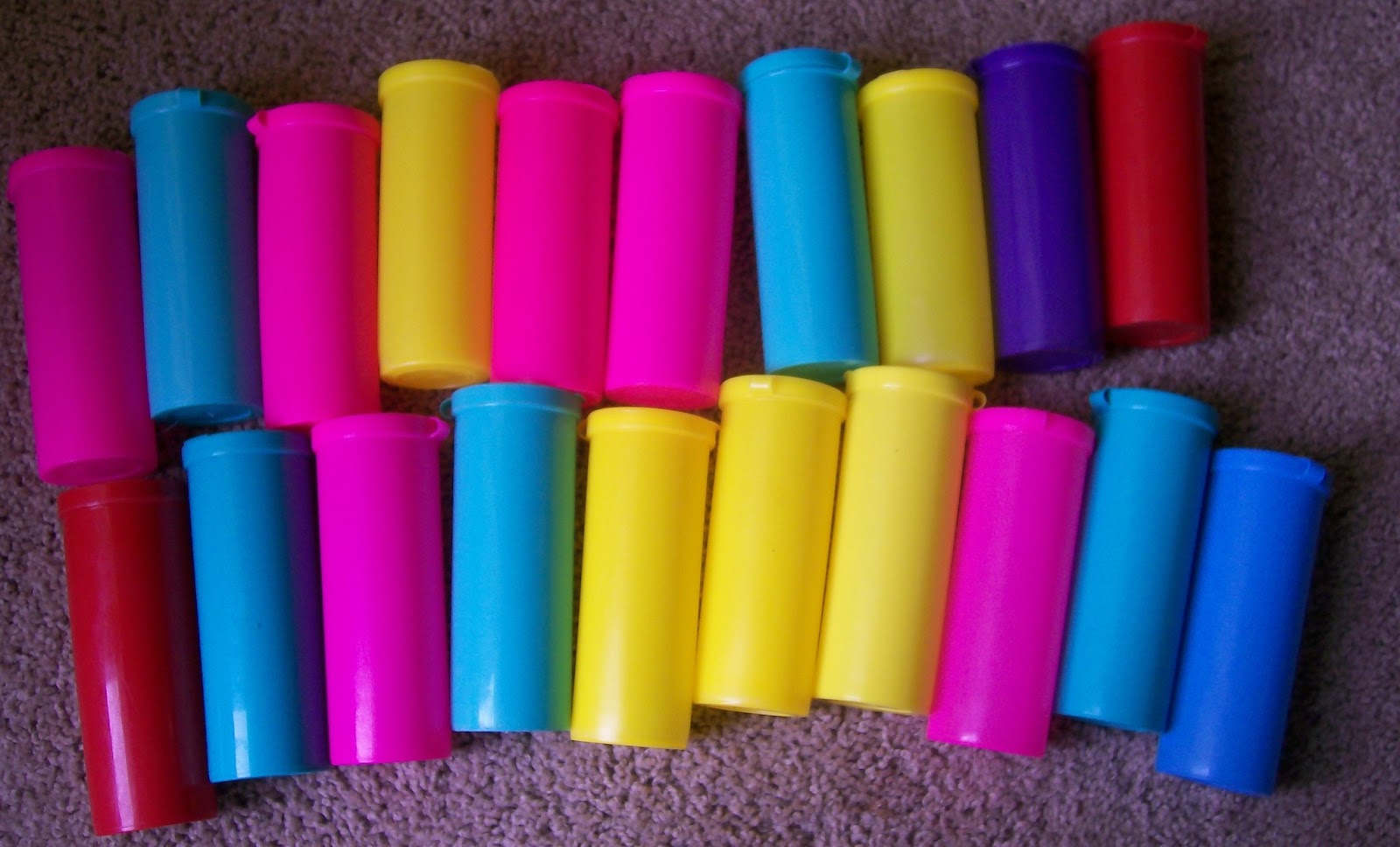
Bingo Chips. I bought red and yellow bingo chips last year to use to model adding and subtracting integers. I’m excited to see if there are any other ways I can use bingo chips in my classroom.

I picked up this Katamino game at a garage sale for $2.00. It’s brand new and still wrapped in the plastic. I had my first experience with pentominoes in the second grade, and I’ve loved them ever since. I plan on keeping this in my classroom for early-finishers or those crazy days where everybody is gone except two people.
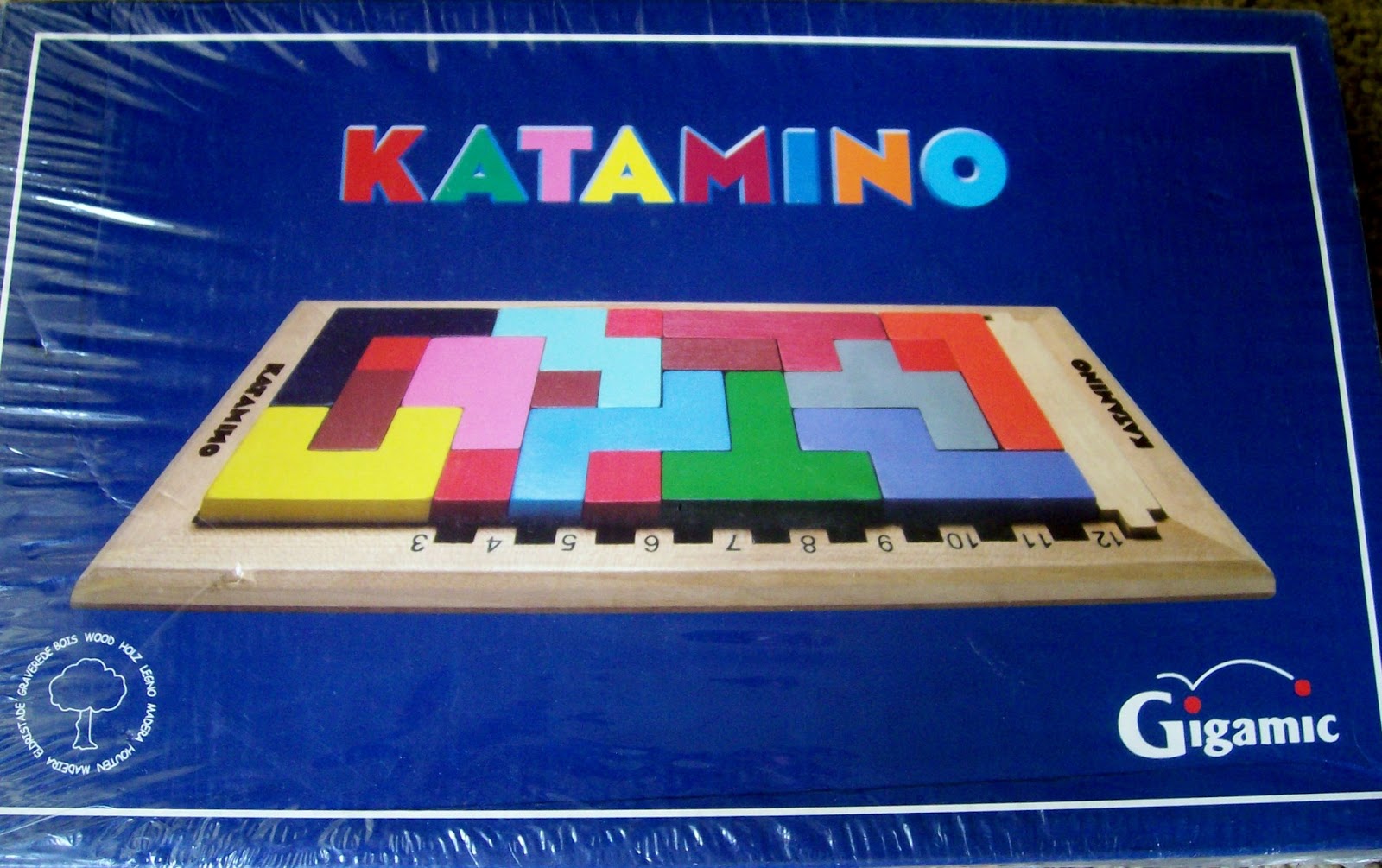
Playing Cards. I’ve seen tons of math ideas using playing cards. I can’t wait to try out a few with my students!
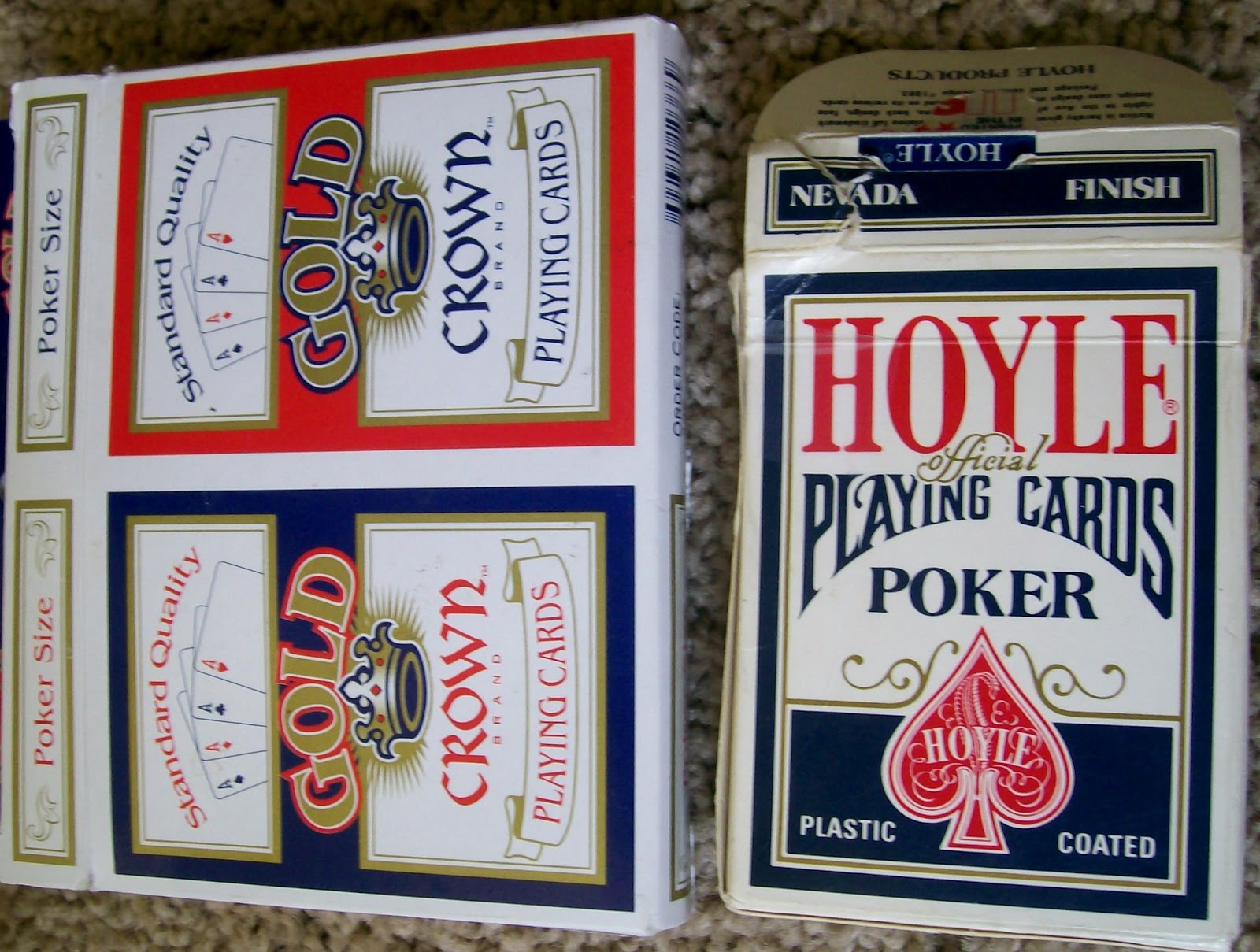
Slinkies. If these will successfully travel down the stairs at my school, I can see myself challenging my students to write a linear equation that models the height of the slinky at time t.

These lovely ladies will be participating in our First Annual Barbie Bungee Competition.

These men may also be participating in the bungee jumping festivities. My dad told me that I needed to give the boys a more manly option. I found these at a garage sale for 25 cents each.

This isn’t a math lesson, but I’m excited that I will have a trash can behind my desk next year. Last year, my classroom only had one trash can, and it was as far away from my desk as possible. I guess I could make this into a math problem by asking my students to estimate how much less distance I will cover in year if I don’t have to walk across the room to throw something away.

I couldn’t resist picking up this light-up hula hoop for a dime. This will definitely be making an appearance in my Algebra 1 class’ unit on ratios and proportions. Now, I just need to find a couple more hula hoops so I can make it into a group challenge.
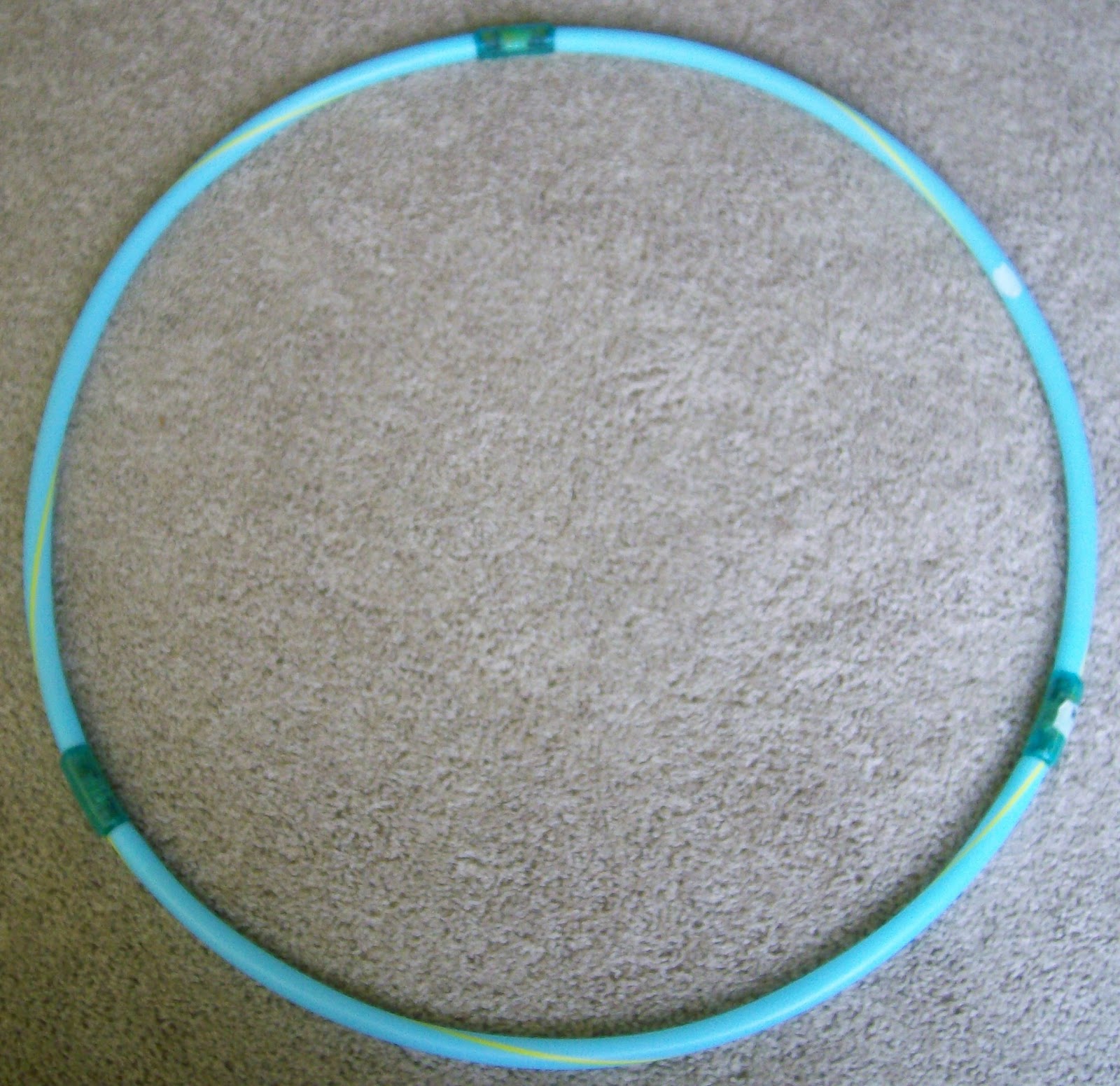
I found this bucket of 30 sets of Tangrams on Amazon. These will be used for early finishers. Or maybe, I could plan a day of math Olympics where students compete to complete various math-related games.
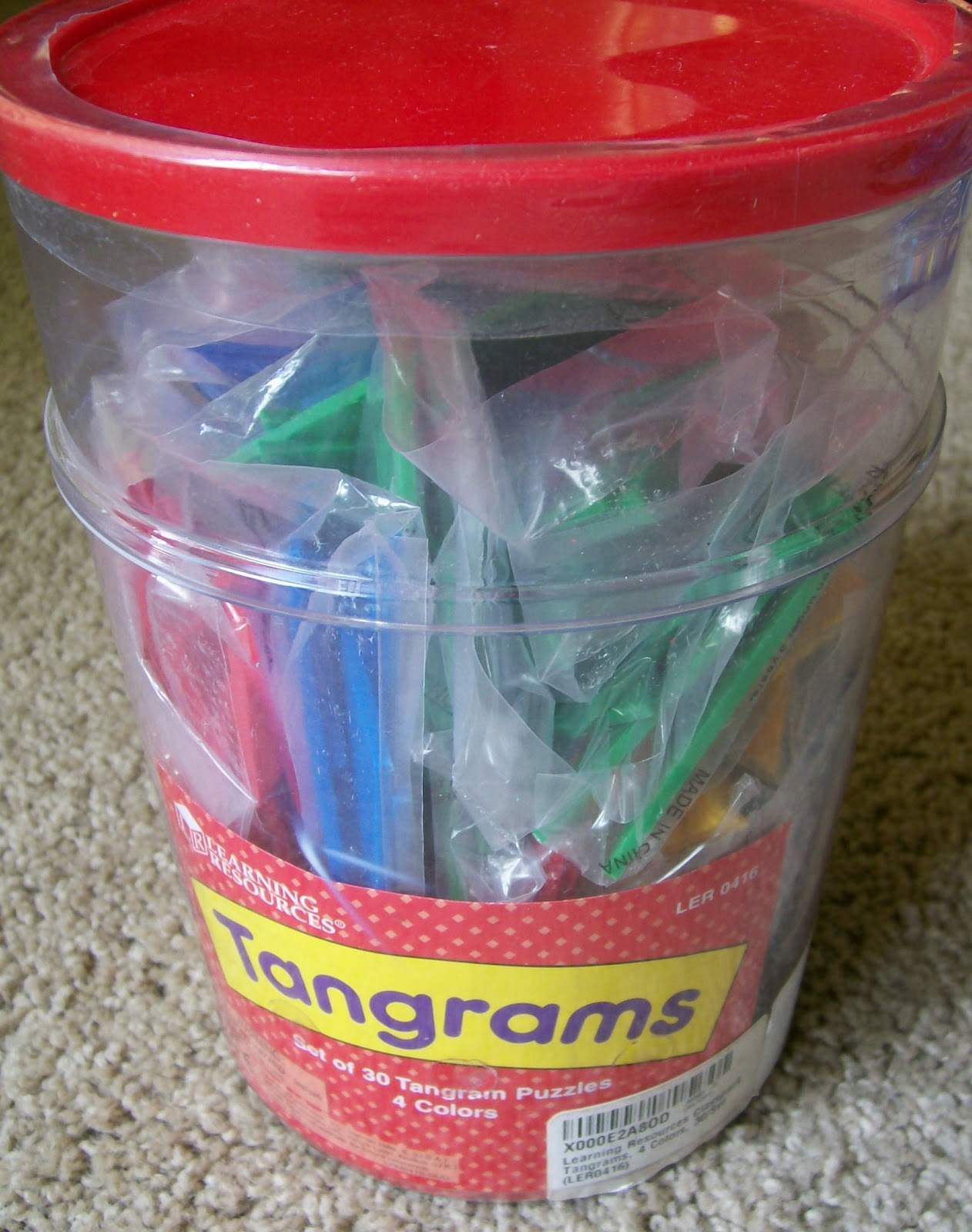
I saw a post on pinterest that said these foam rollers can be used as mini dry erase erasers if you take out the plastic part. My students are in desperate need of new erasers for their dry erase boards, so I’m looking forward to trying these out to see if they work.
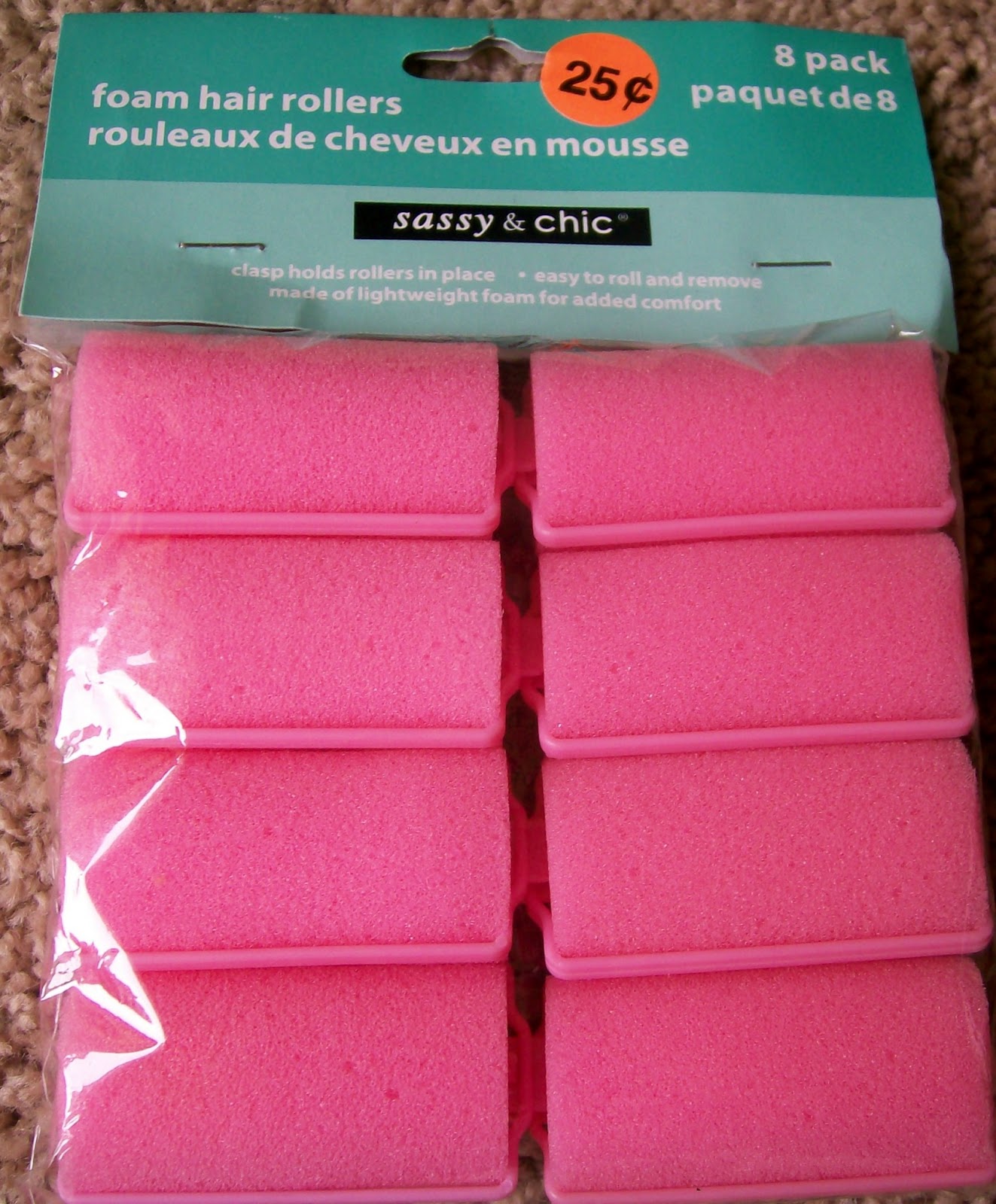
My mom picked up this globe for my classroom. I’m not quite sure what I’m going to do with this yet, but it will look pretty cool setting on top of my pi filing cabinet until I come up with an idea.

May 30, 2013 – Common Core Flipbooks
As soon as I saw this post by Algebrainiac, I knew I had to make my own common core flipbooks. Oklahoma is one of the many states to adopt the CCSS. We still have one more year of our old standards, but we are supposed to be starting the transition process. I’ll be honest. As a first-year teacher, I did very little with common core. I read a lot about it, but my main focus was getting my students ready for their end-of-instruction exams which are required for graduation. And, those exams are not common core aligned.
Next year, I have plans to do better. I want to make a conscious effort to incorporate as many of the mathematical practices as possible. I want to ask more rigorous questions. And, I definitely want my students to ask more questions. I’m going to be part of the Oklahoma Geometry and Algebra Project (OGAP) this summer, and I’m hoping to learn a ton more about what exactly common core will require in my classroom through that.
Back to the flipbooks. I printed the flipbooks off of this website. Next year, I am going to be teaching Algebra 1 and Algebra 2. So, I decided to print off one flipbook for each. I didn’t print off the entire thing, though. That would be a bunch of pages! Instead, I use our Oklahoma OC3 standards to figure out which common core standards belonged to each subject. I followed Algebrainiac’s advice and color-coded my booklets.
I printed these off double-sided on letter size paper. All the colors I used were 24 pound paper except one of the colors which was 20 pound paper, and I noticed it really did make a difference.
To make these more durable and to make sure I could tell them apart, I printed off covers for each booklet on cardstock and ran them through my laminator. This will protect the cute little tabs when I’m not using my flipbooks. I love that these flipbooks put the standards, sample problems, common errors, and more all in the same place. I can already see me using these a lot!
My finished products:

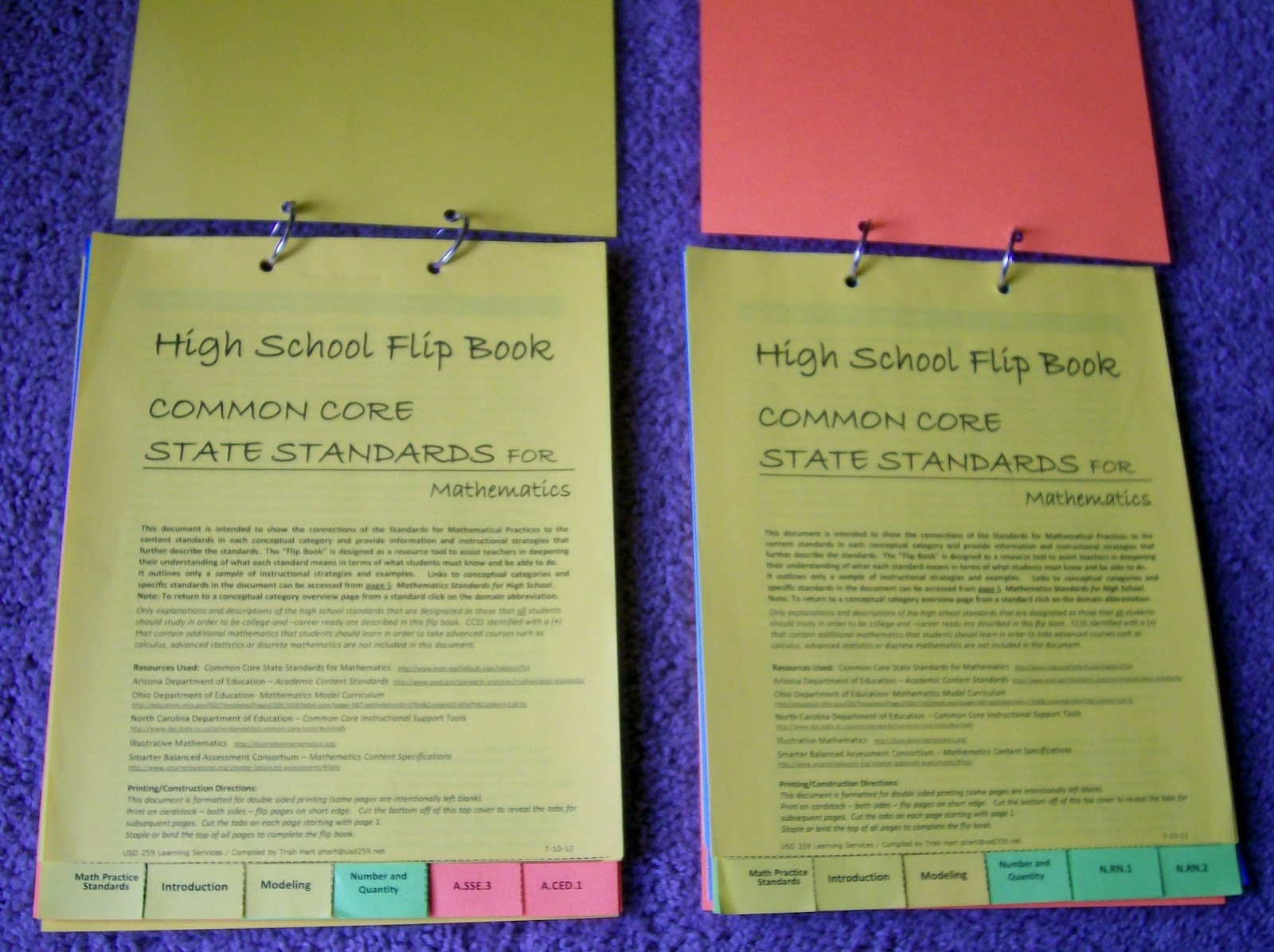
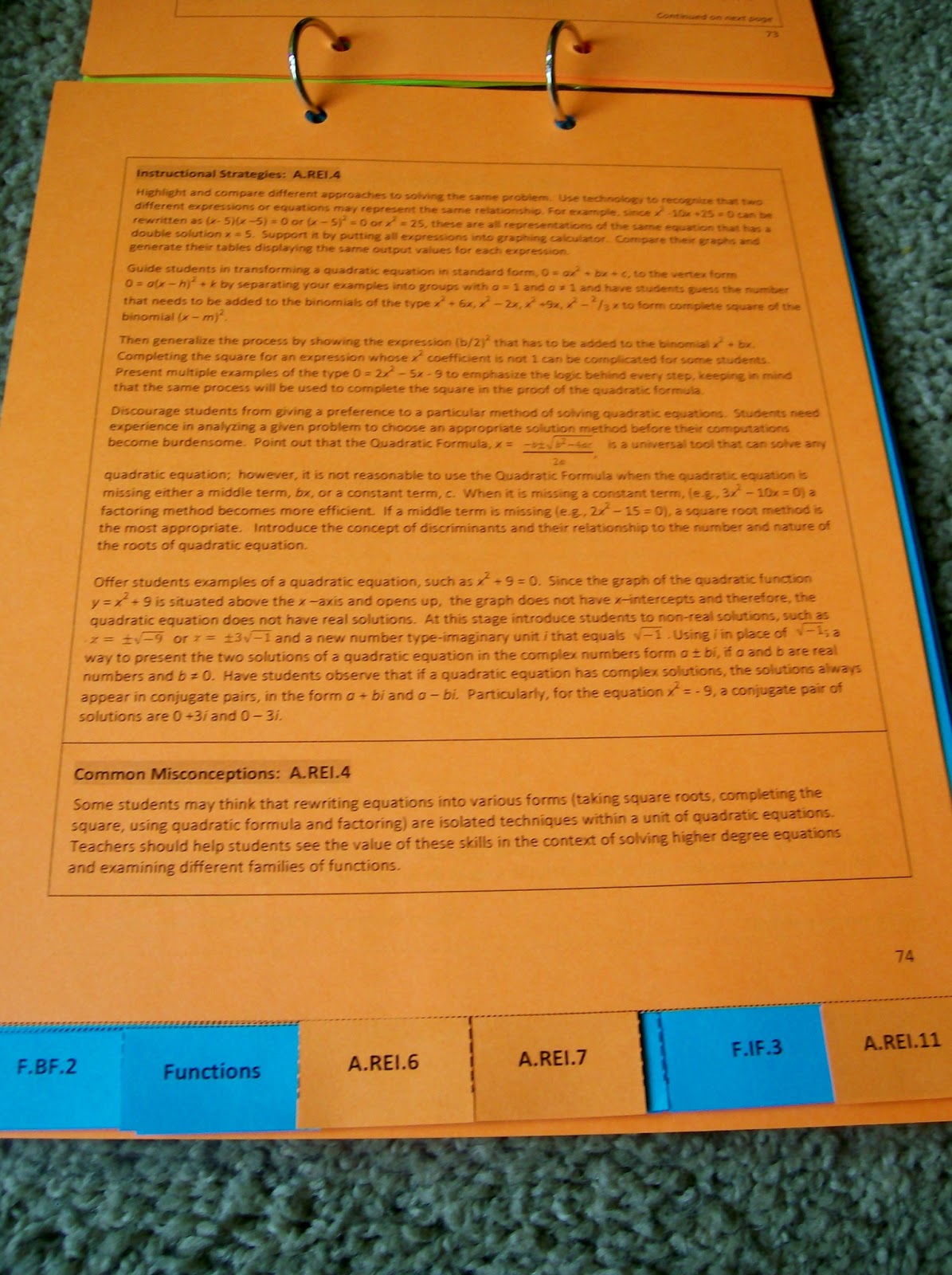
May 31, 2013 – Conic Sections Foldables and Interactive Notebook Pages
Today I want to share some conic sections foldables and interactive notebooks created by my Algebra 2 classes.
Yesterday, I wrote about the amazing experience my Algebra 2 students and I had using Cindy Johnson’s Conic Cards. Here’s the proof. Instead of giving my Algebra 2 students a final exam, I challenged them to complete three interactive notebook pages over three topics we had studied this year. I was pleasantly surprised to see tons of projects about conic sections!
While working on these projects, my students asked me where the conic cards were so they could use them as a reference. This is a testament to just how comfortable they feel using the conic cards. Even though they hadn’t used them in several weeks, students still knew exactly where they could find each piece of information that they needed. And, I’m pretty sure hyperbolas were their least favorite conic section because only one student submitted a project over hyperbolas.
Again, remember that these are student projects. If you decide to use any of these with your classes, be on the lookout for small and large errors!
Conic Sections Foldables and Interactive Notebook Pages
Circles
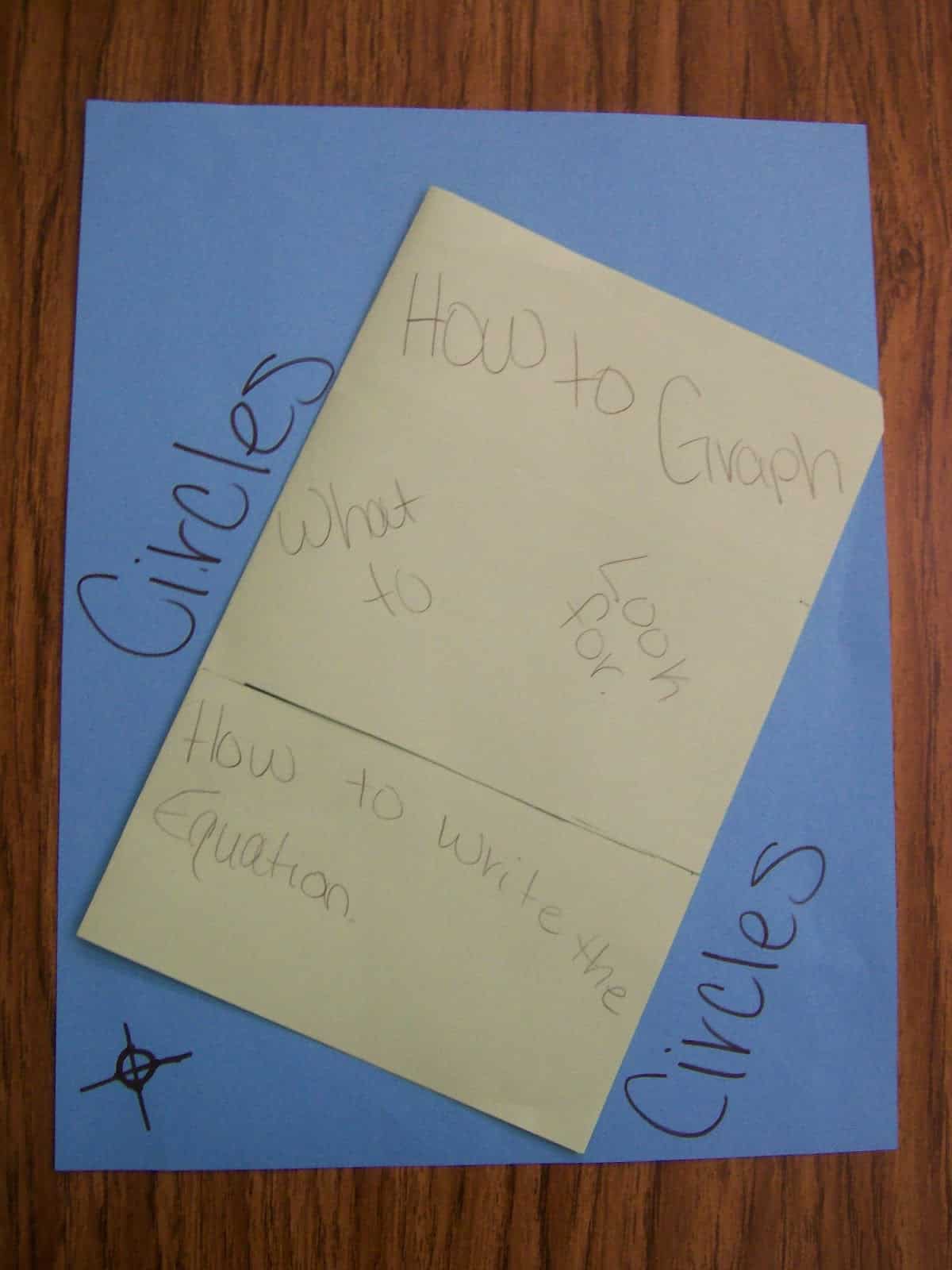
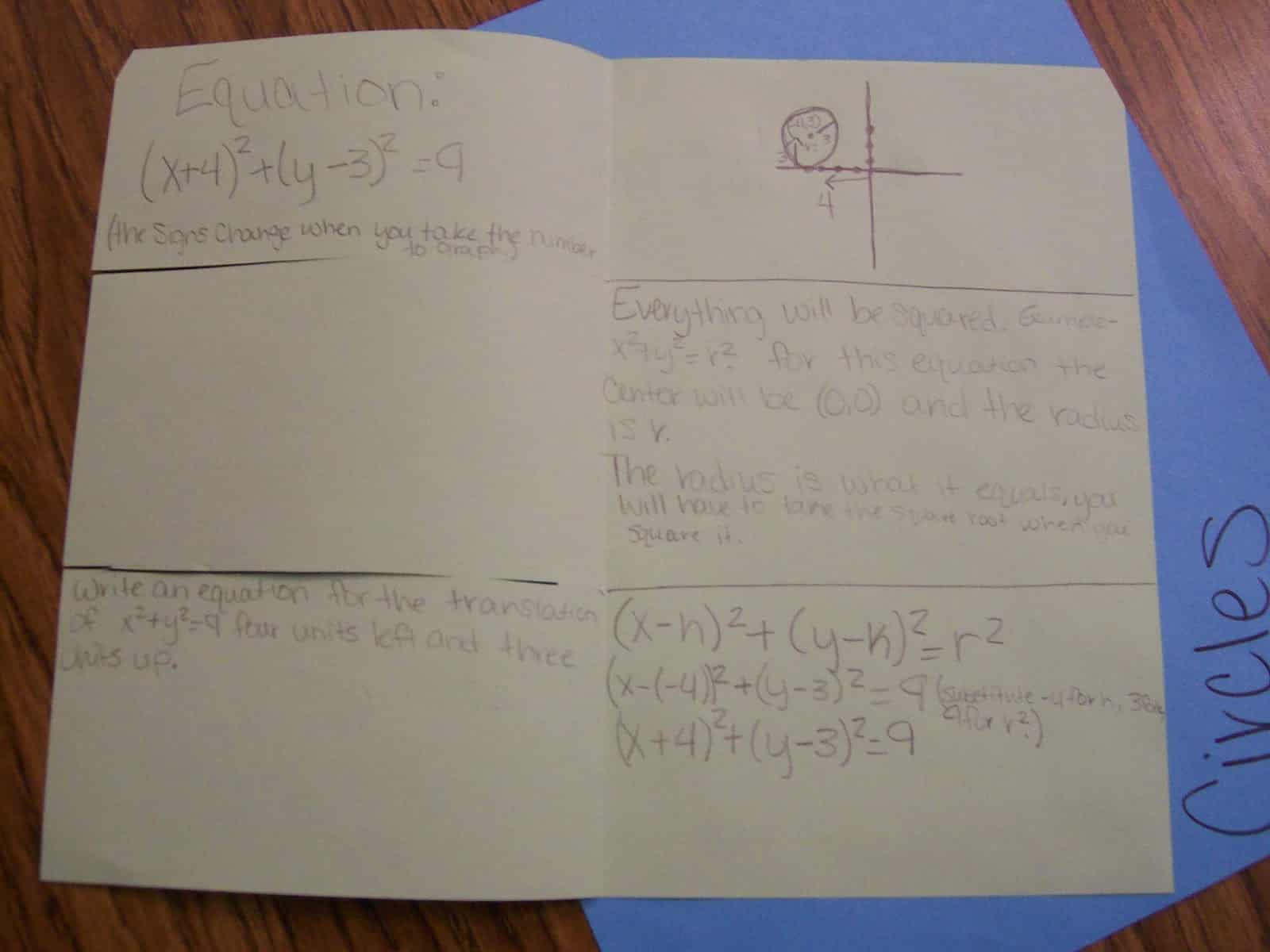
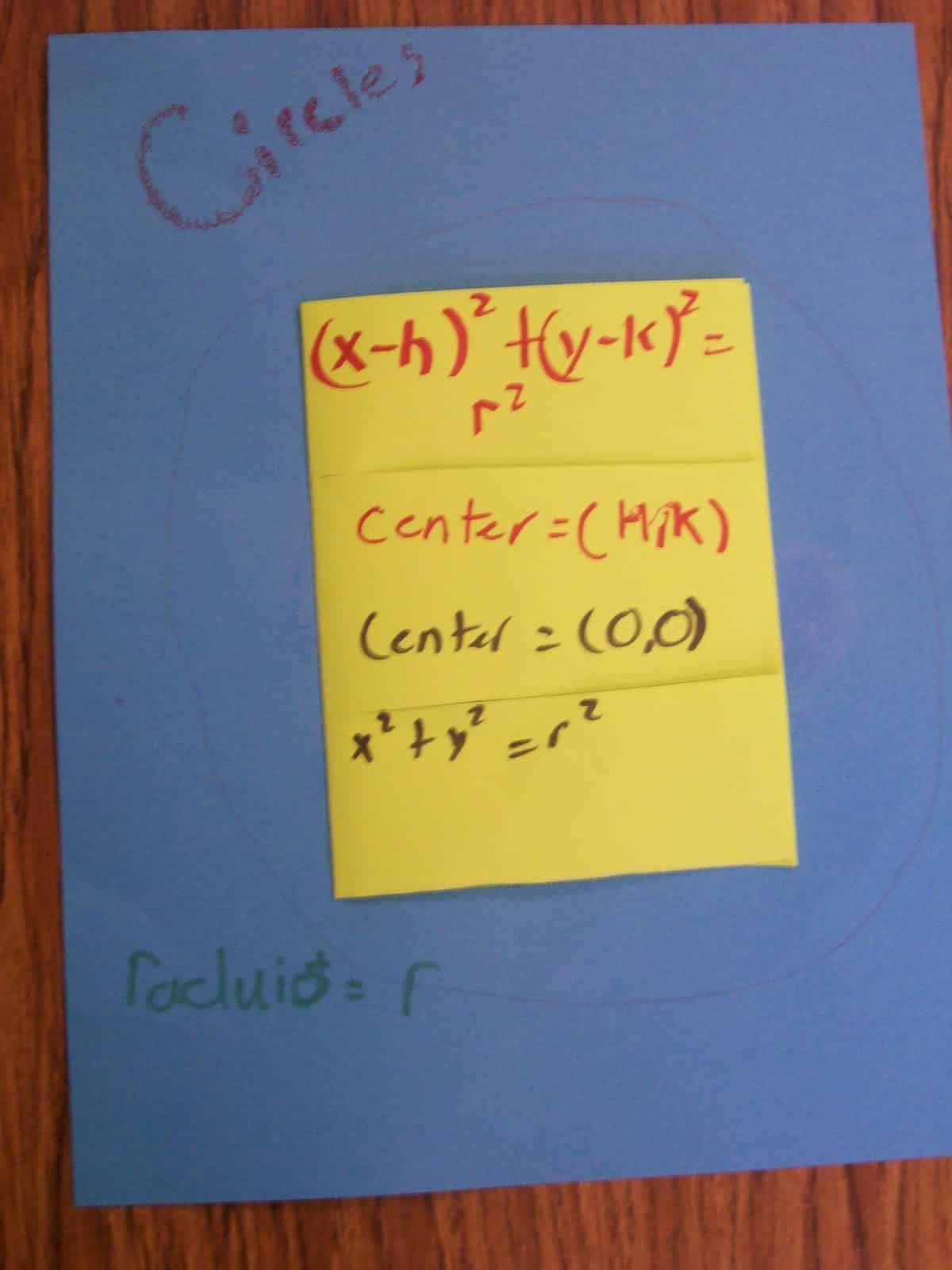
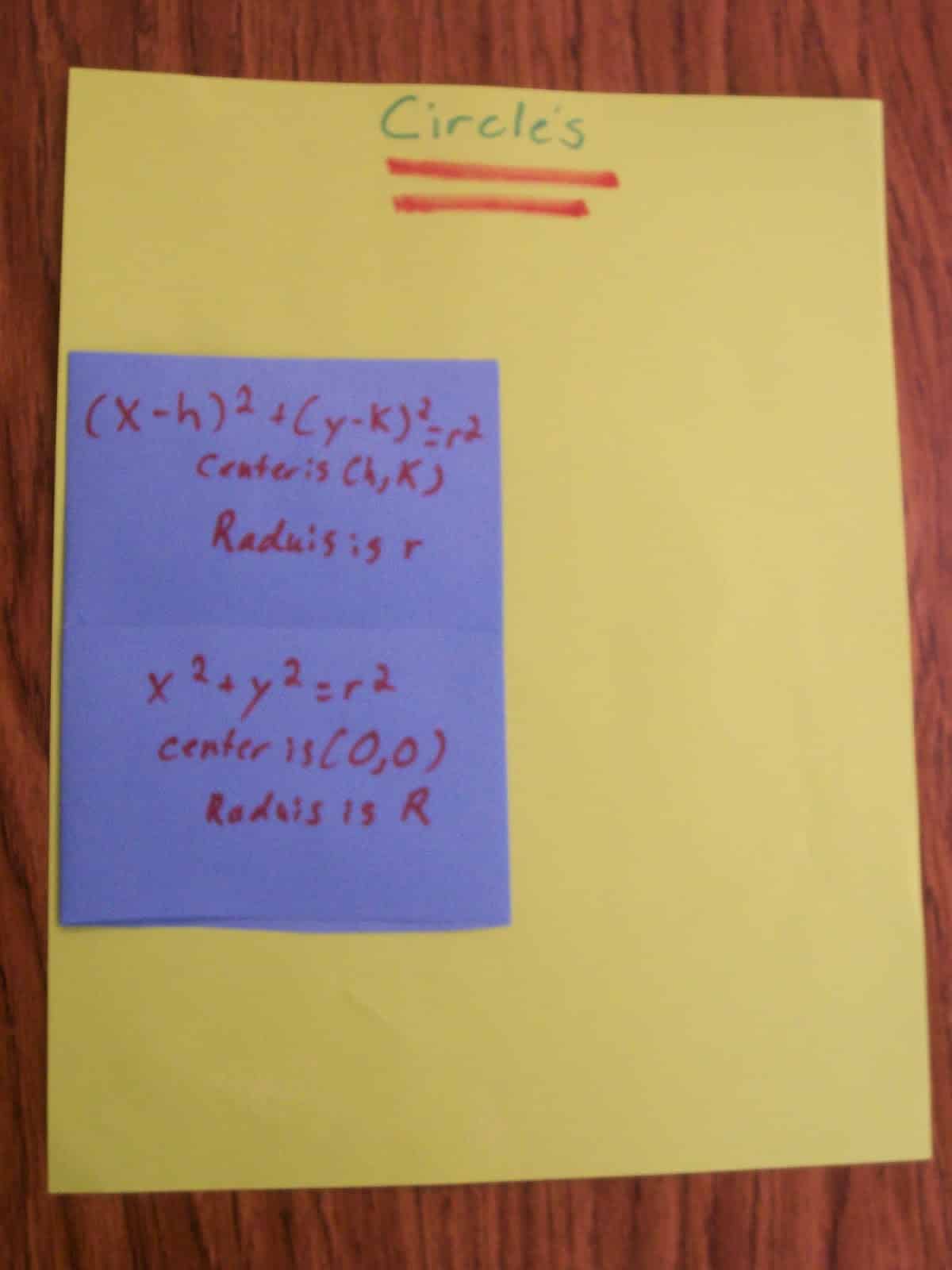
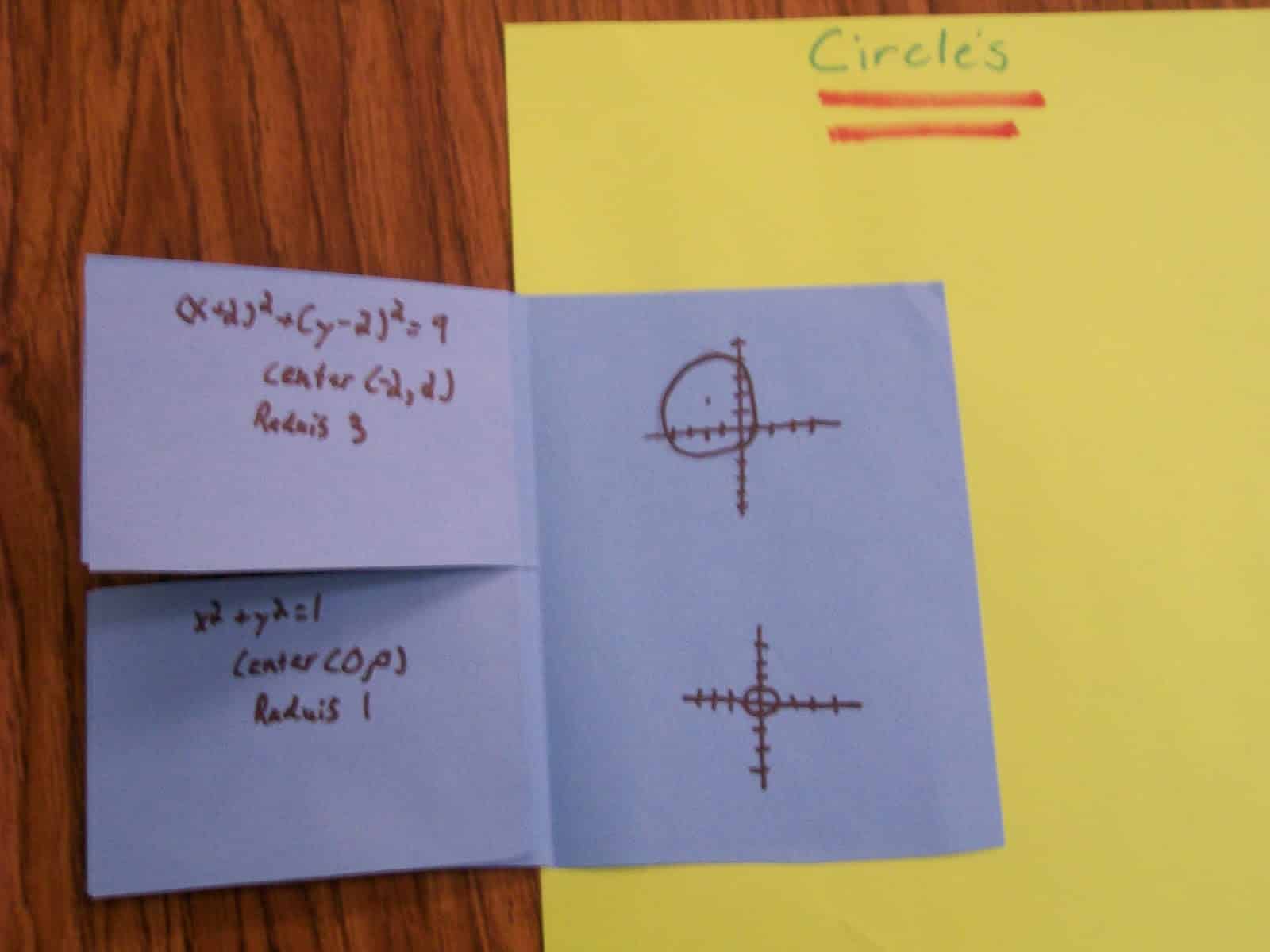
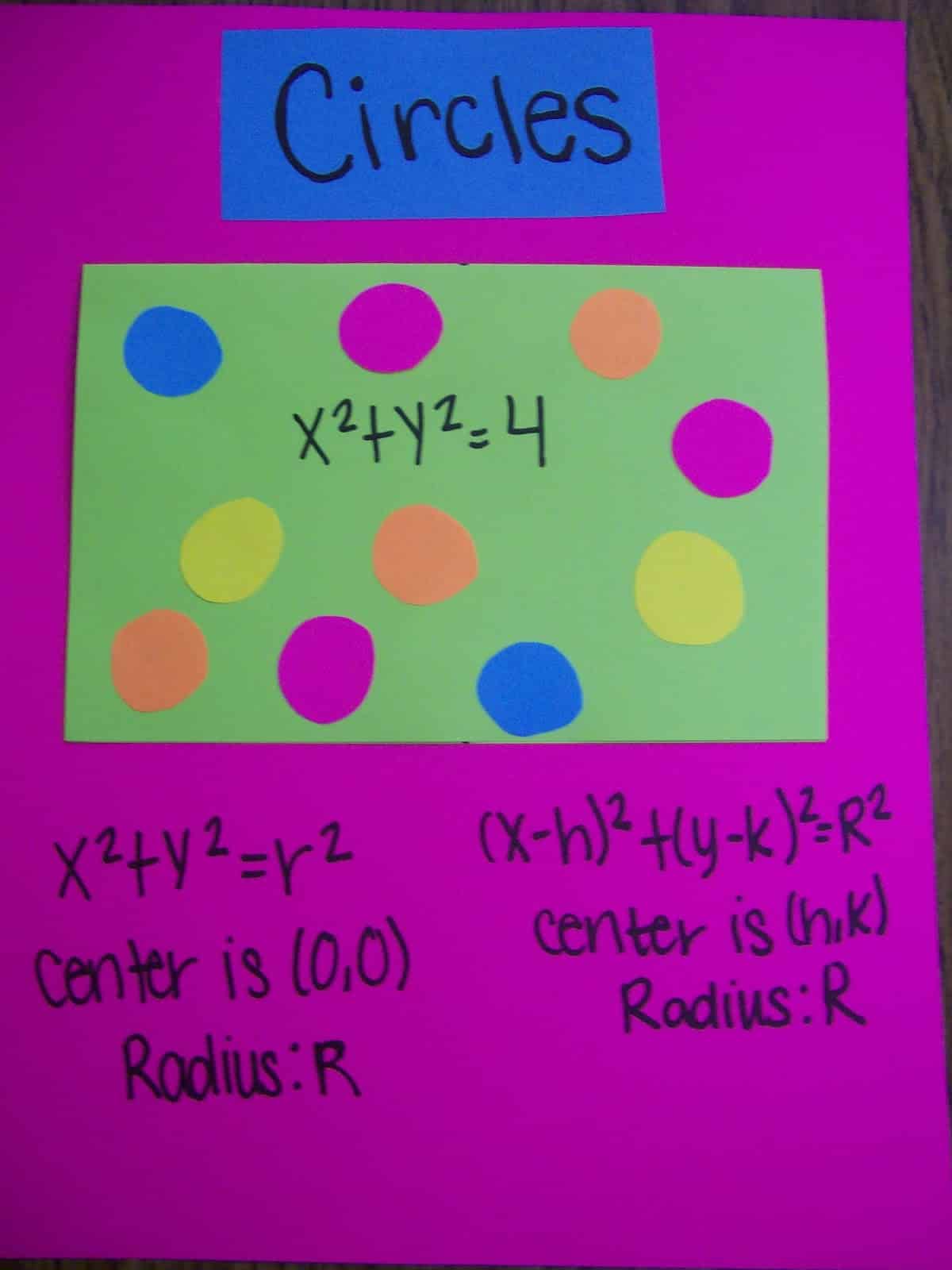
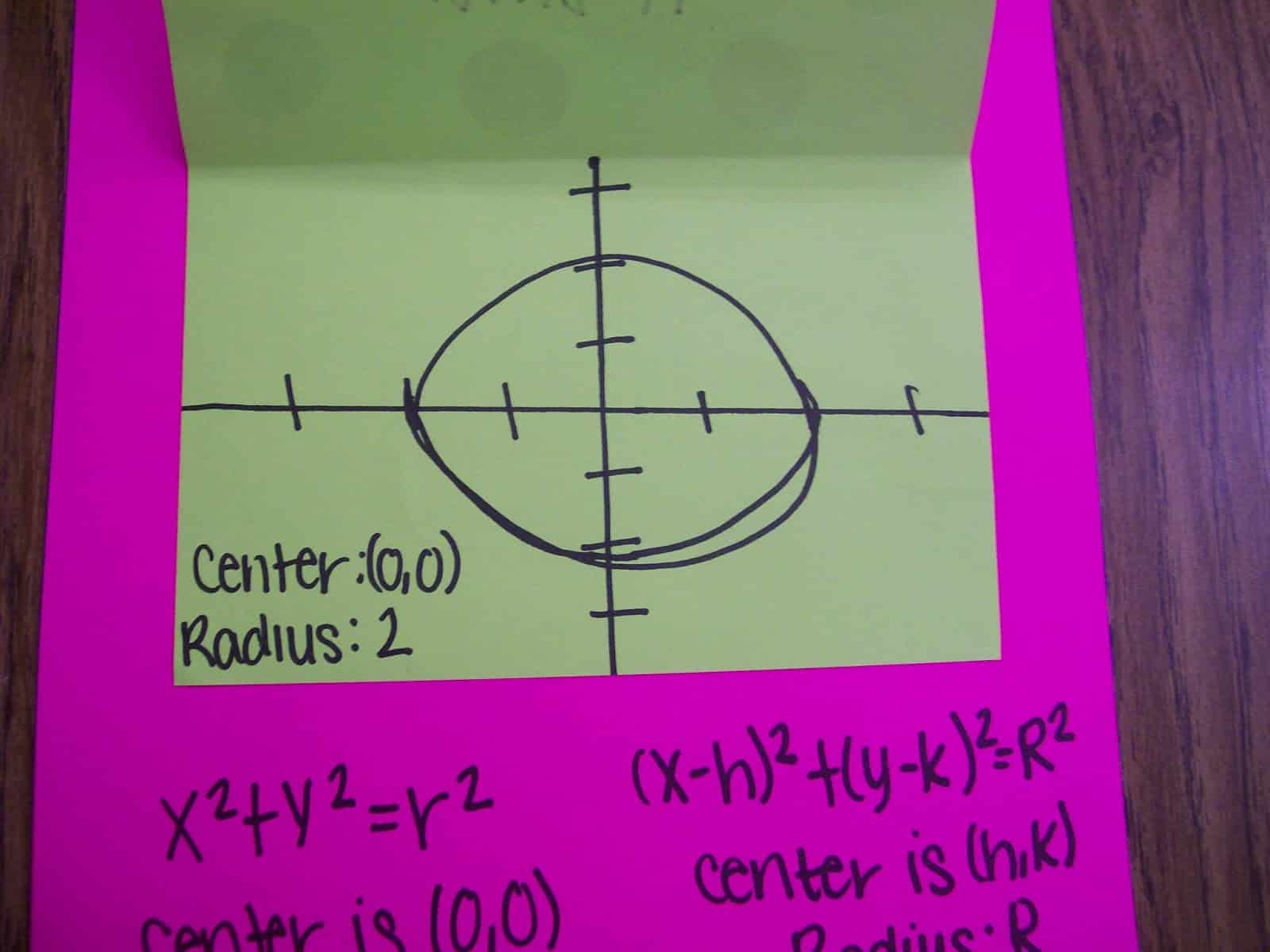

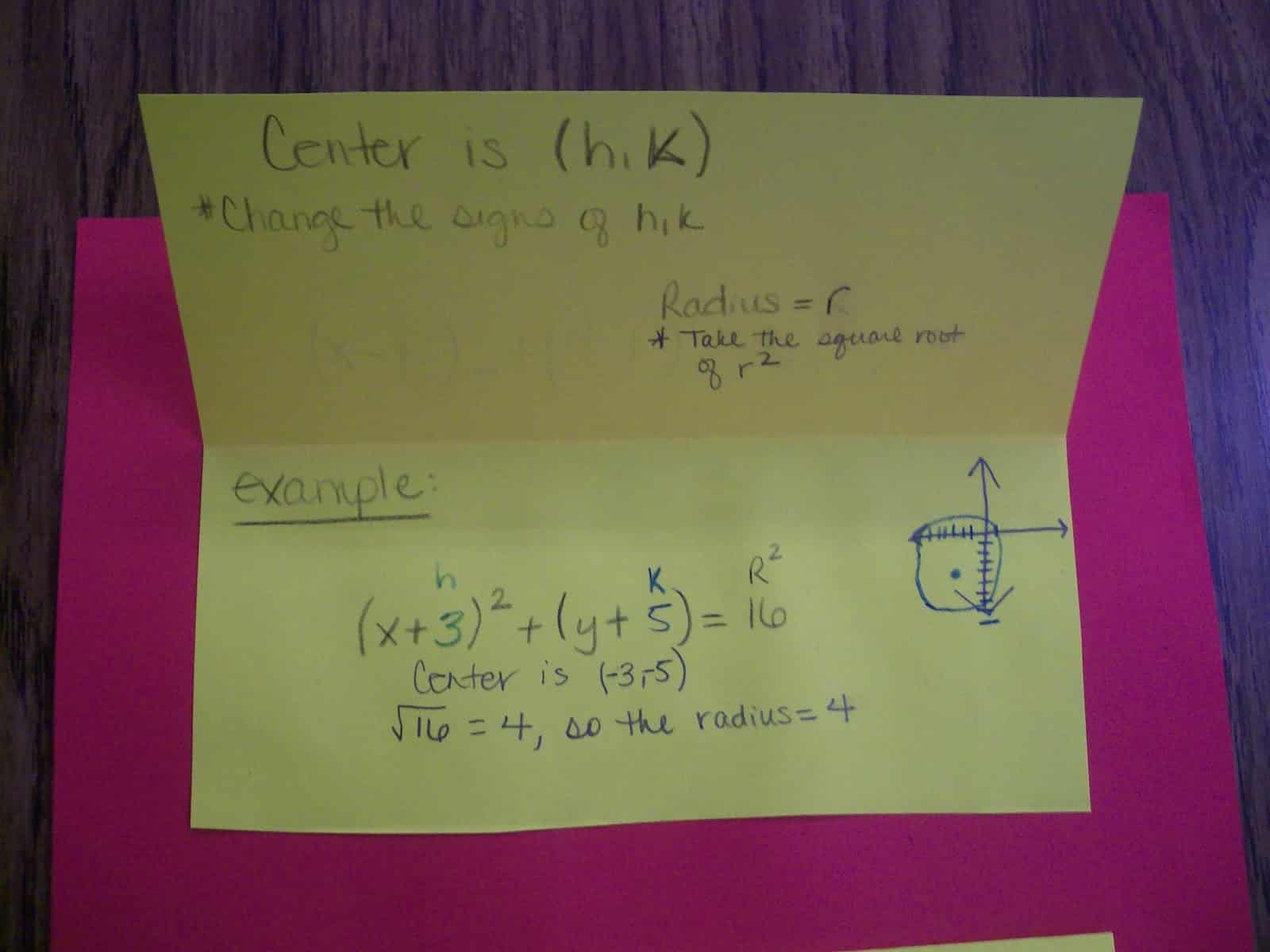
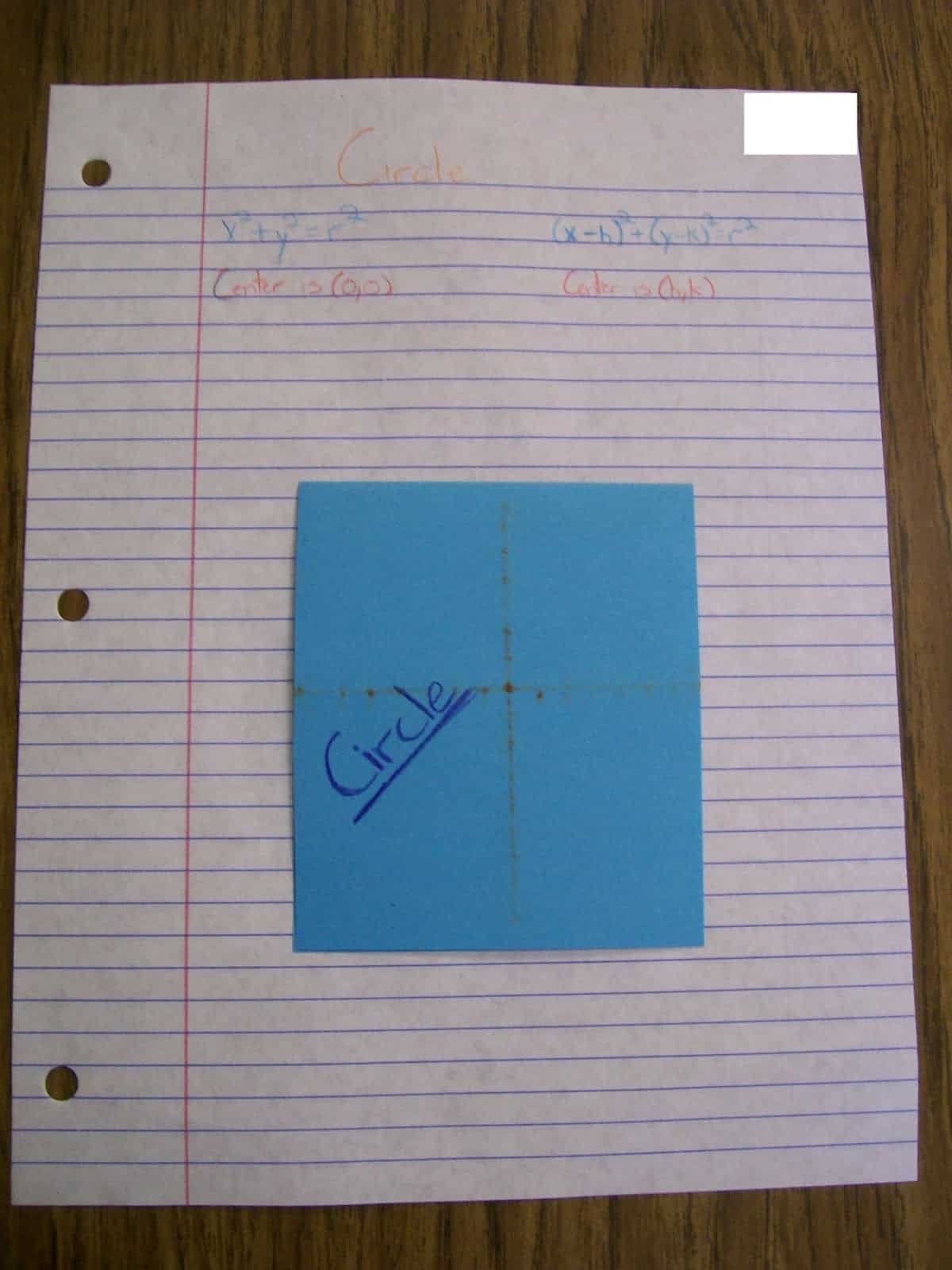
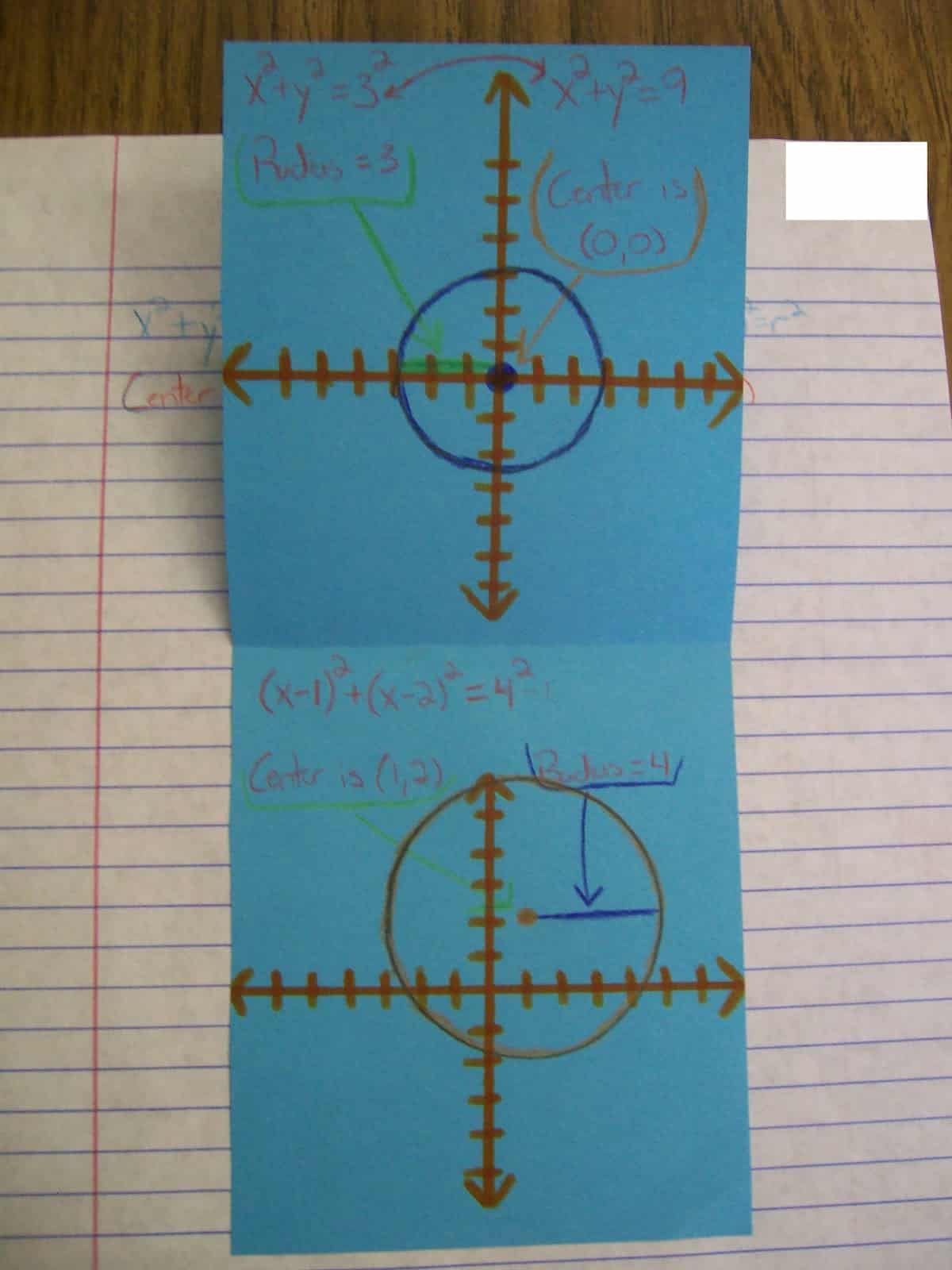
Ellipses
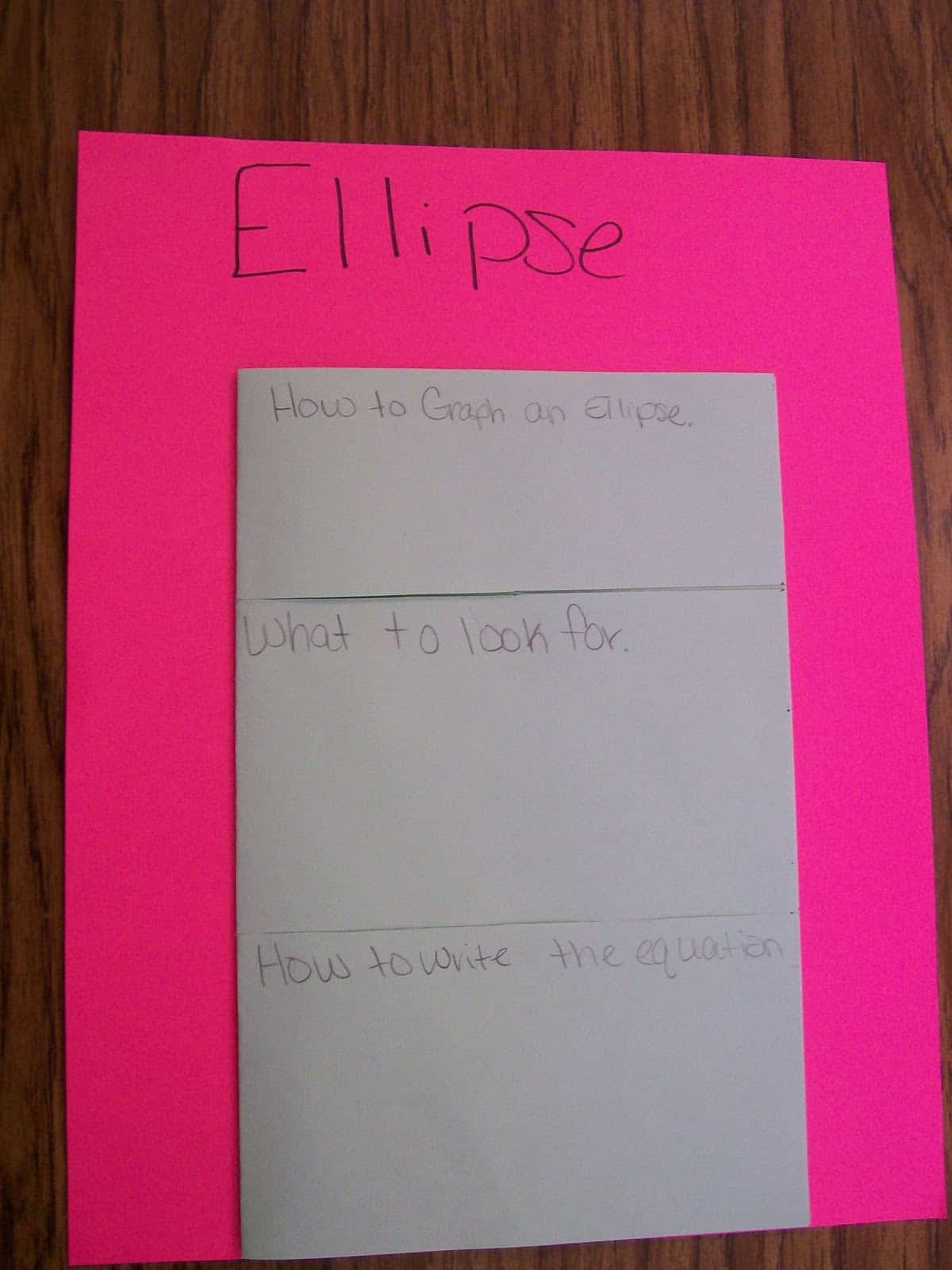
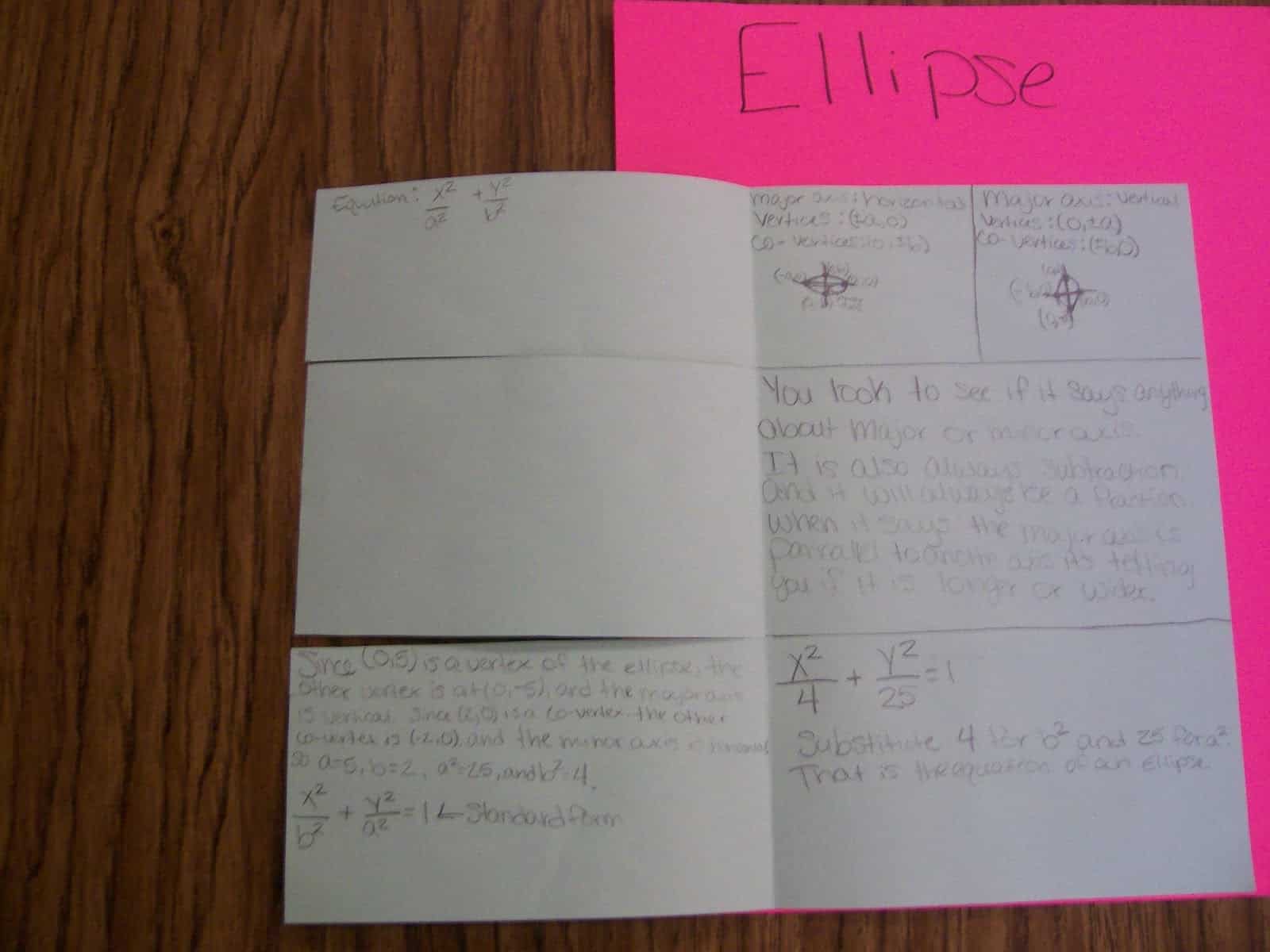

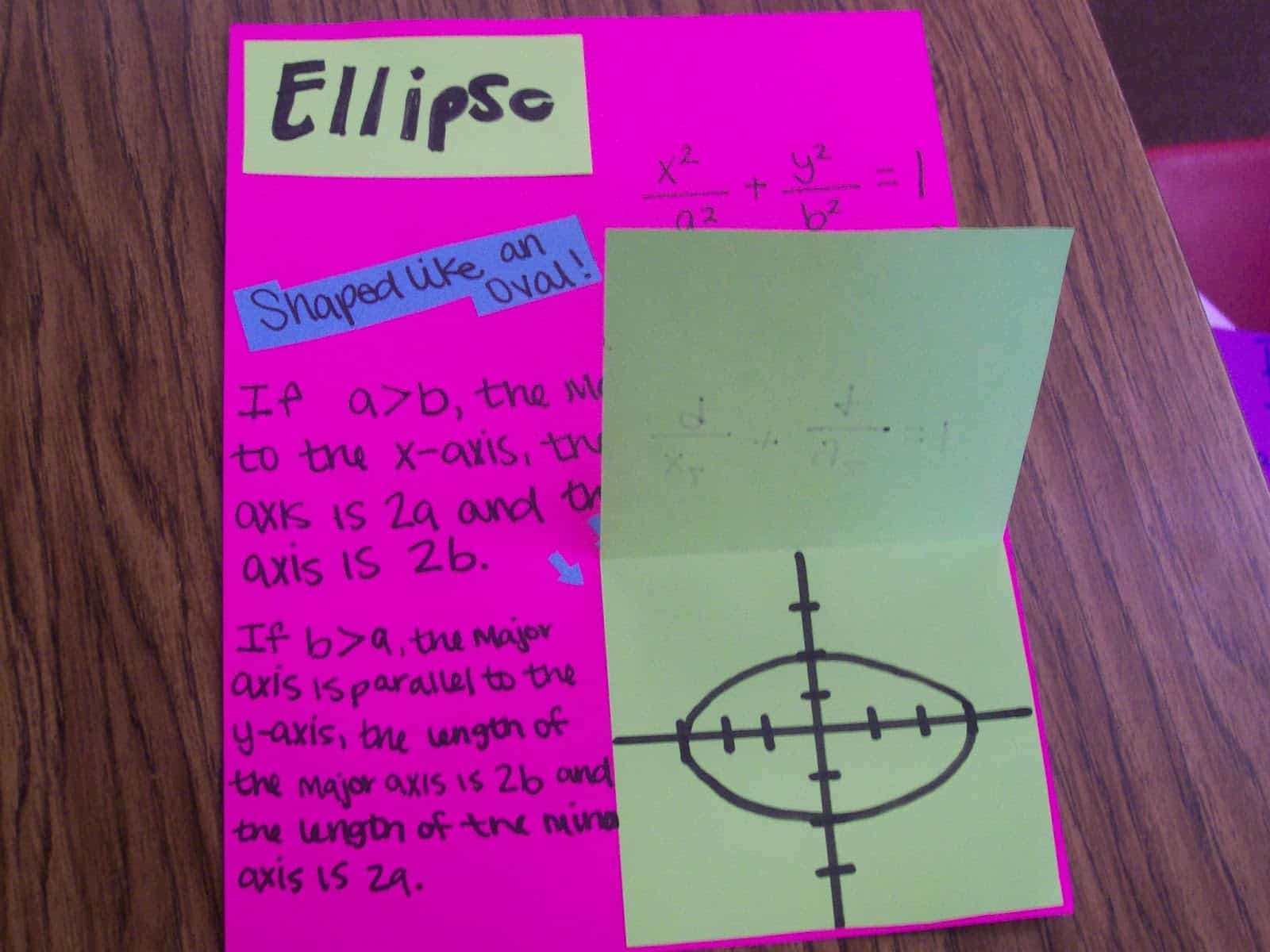
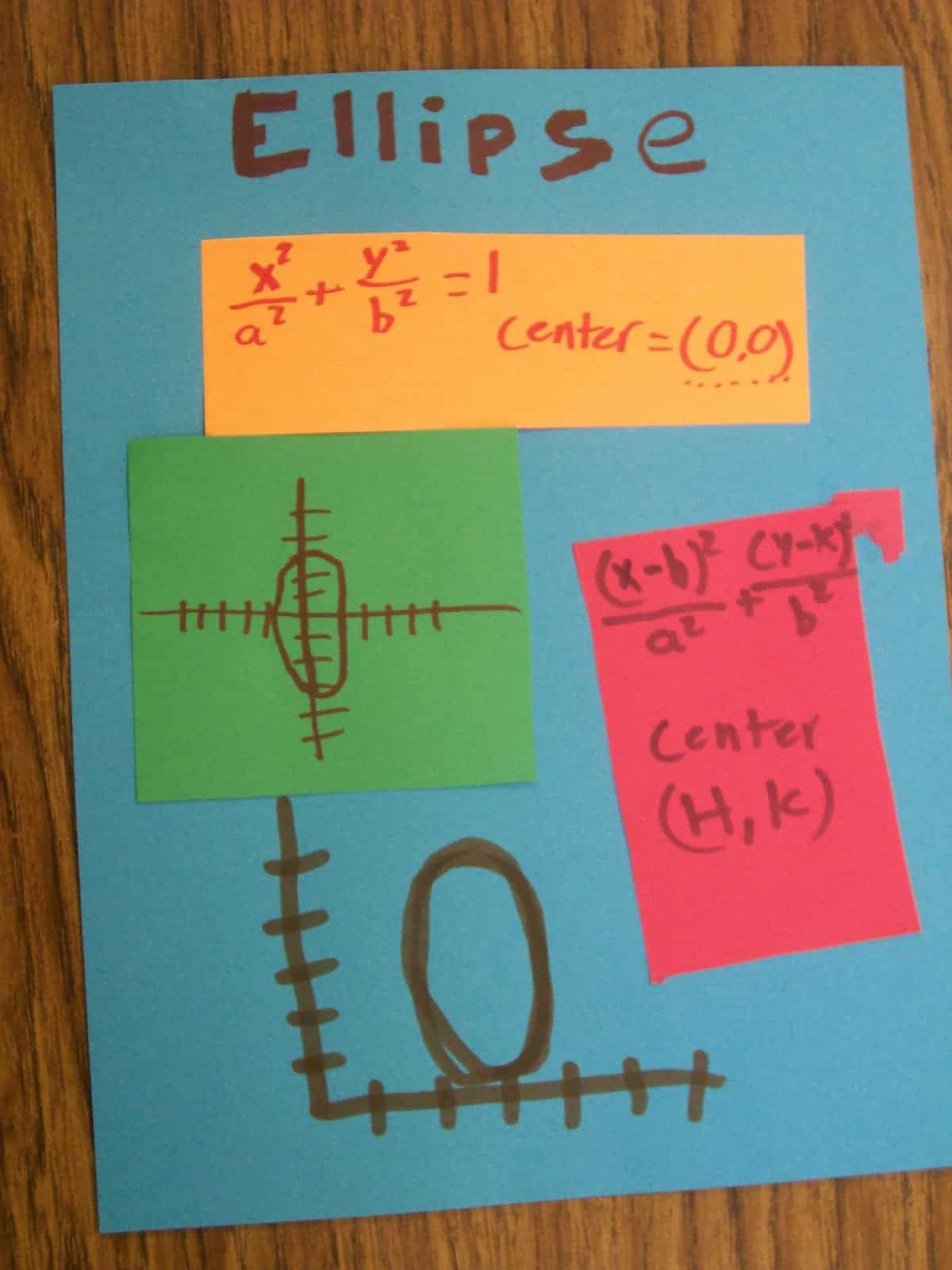
Parabolas
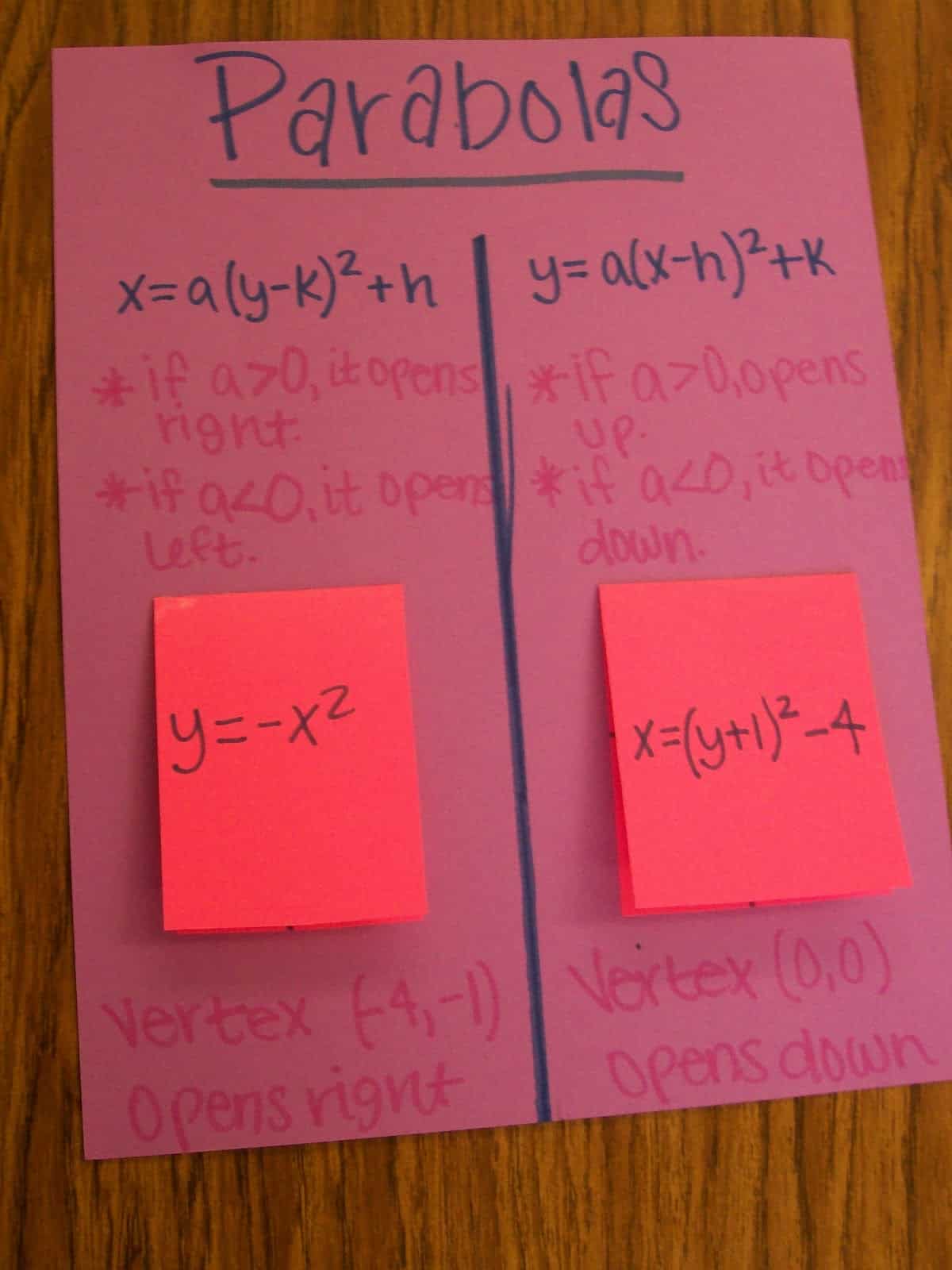
(Notice – they accidentally flip-flopped their foldables when they glued them down.)
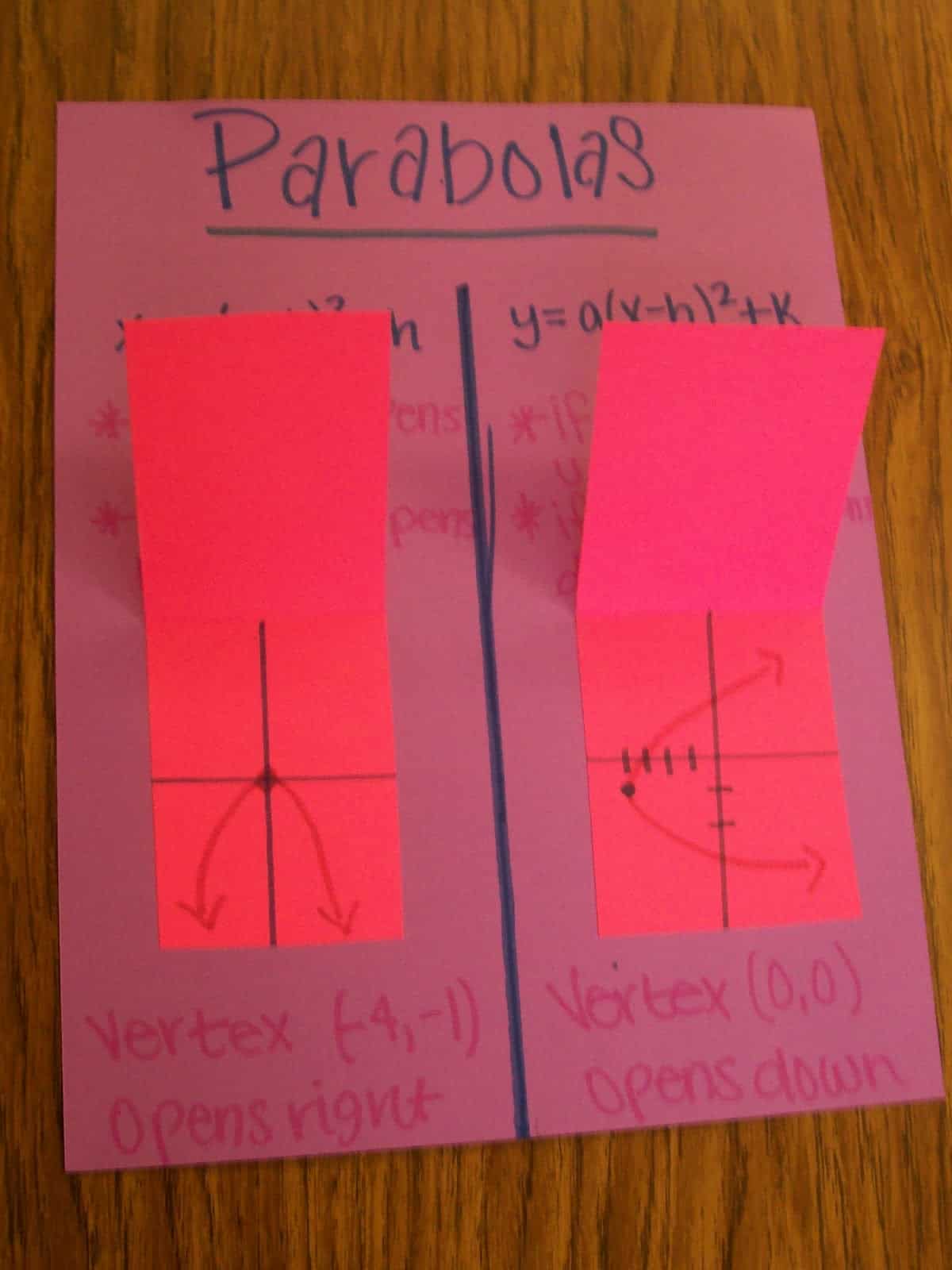
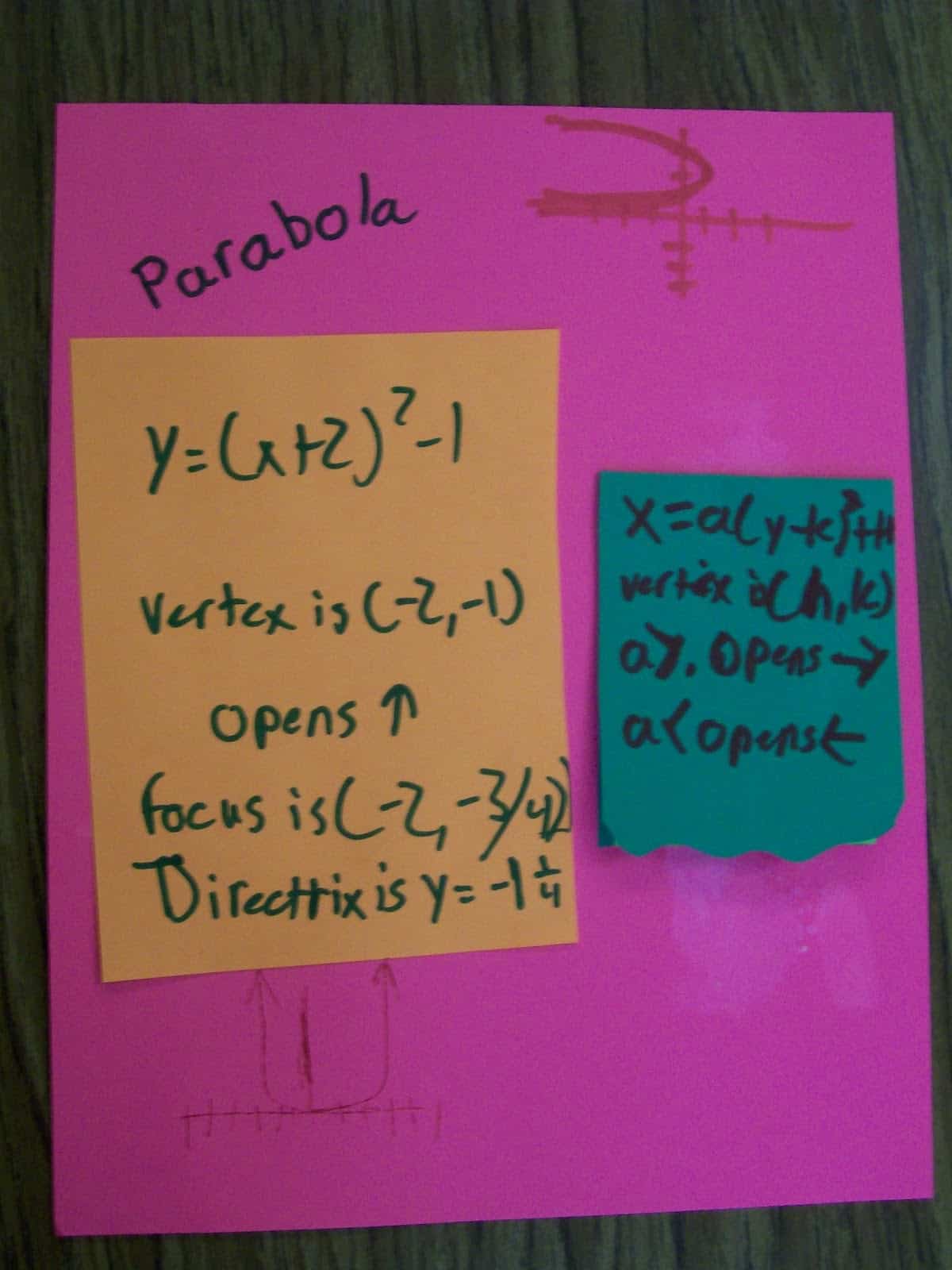
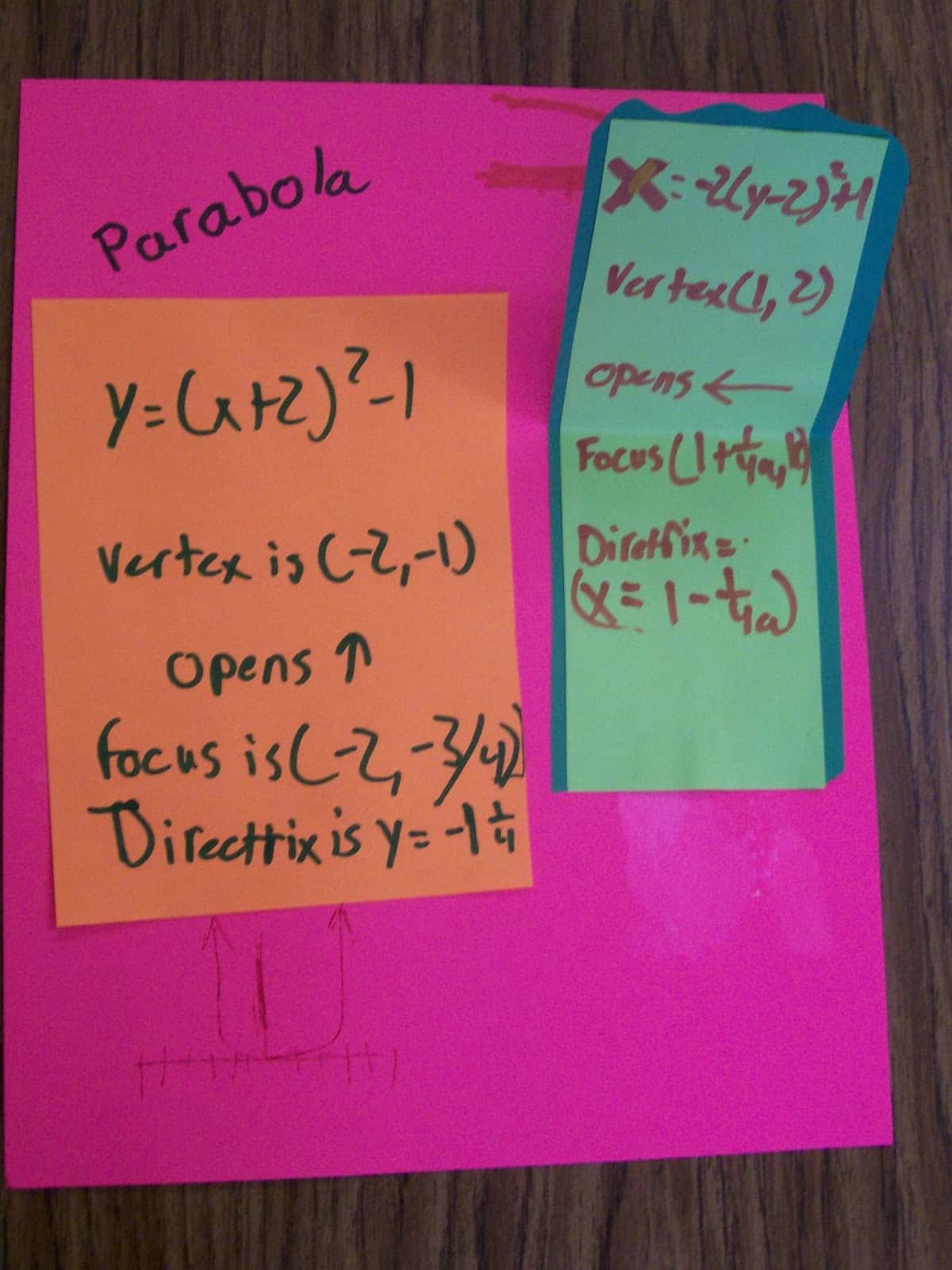
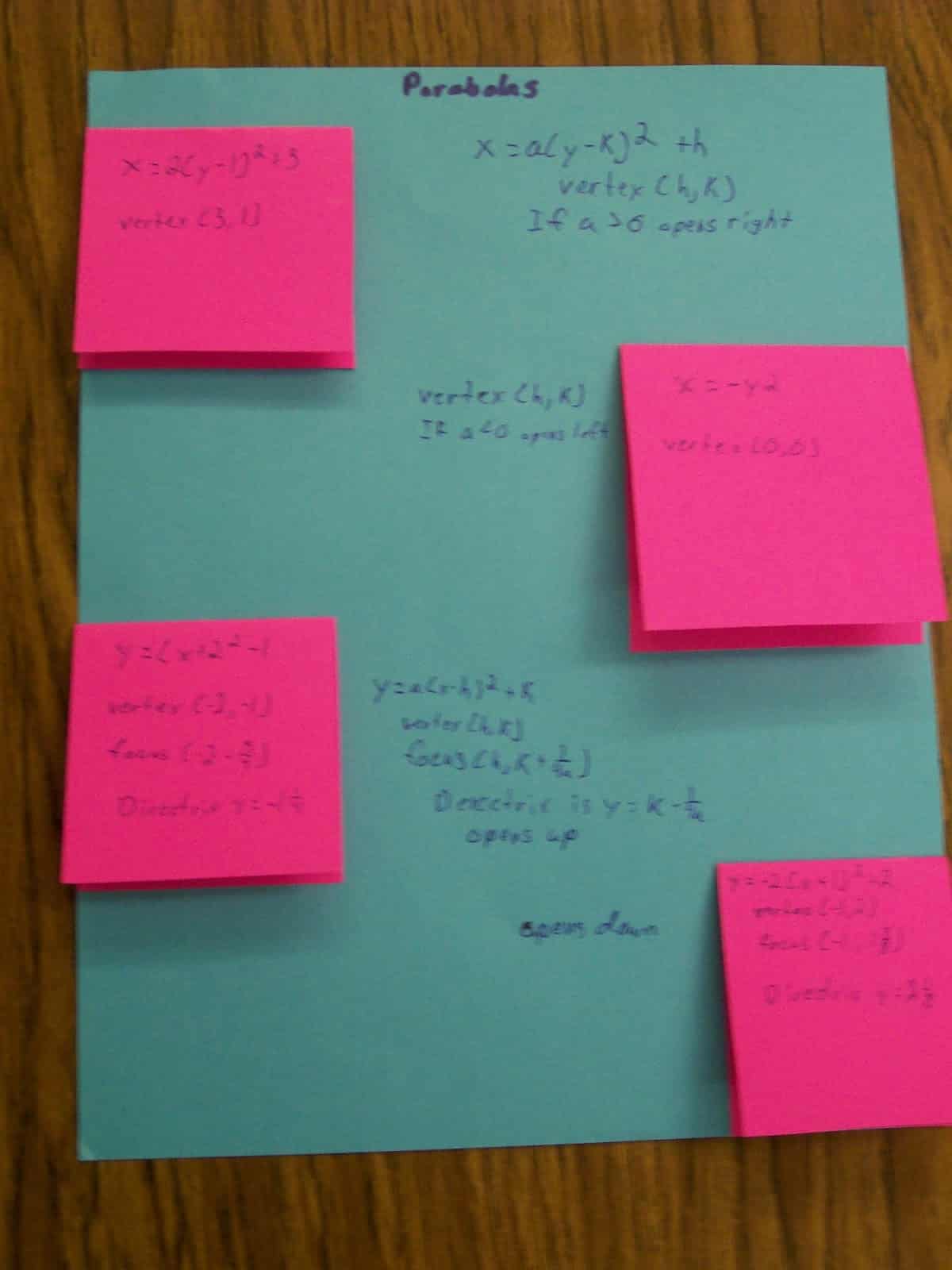
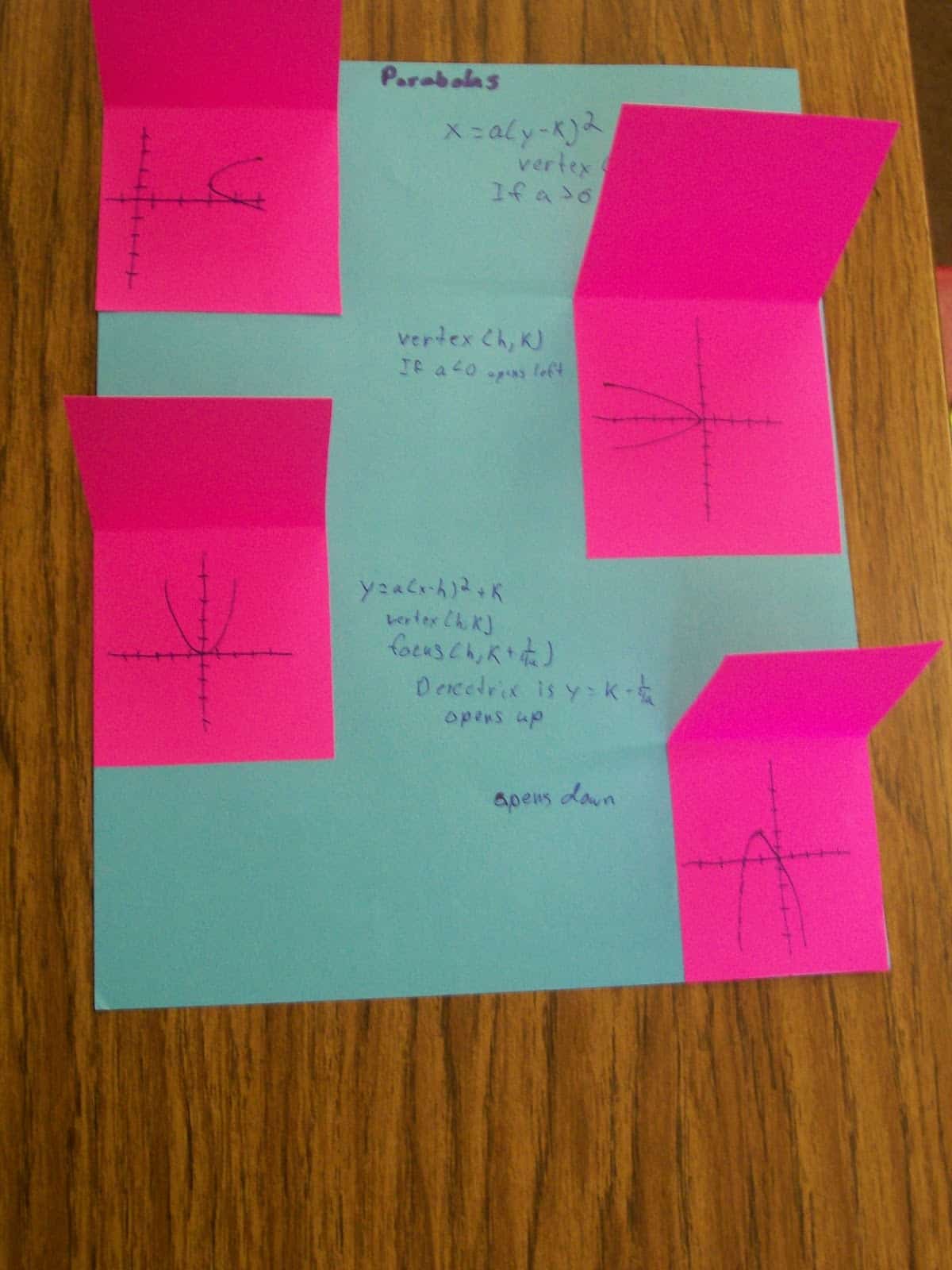
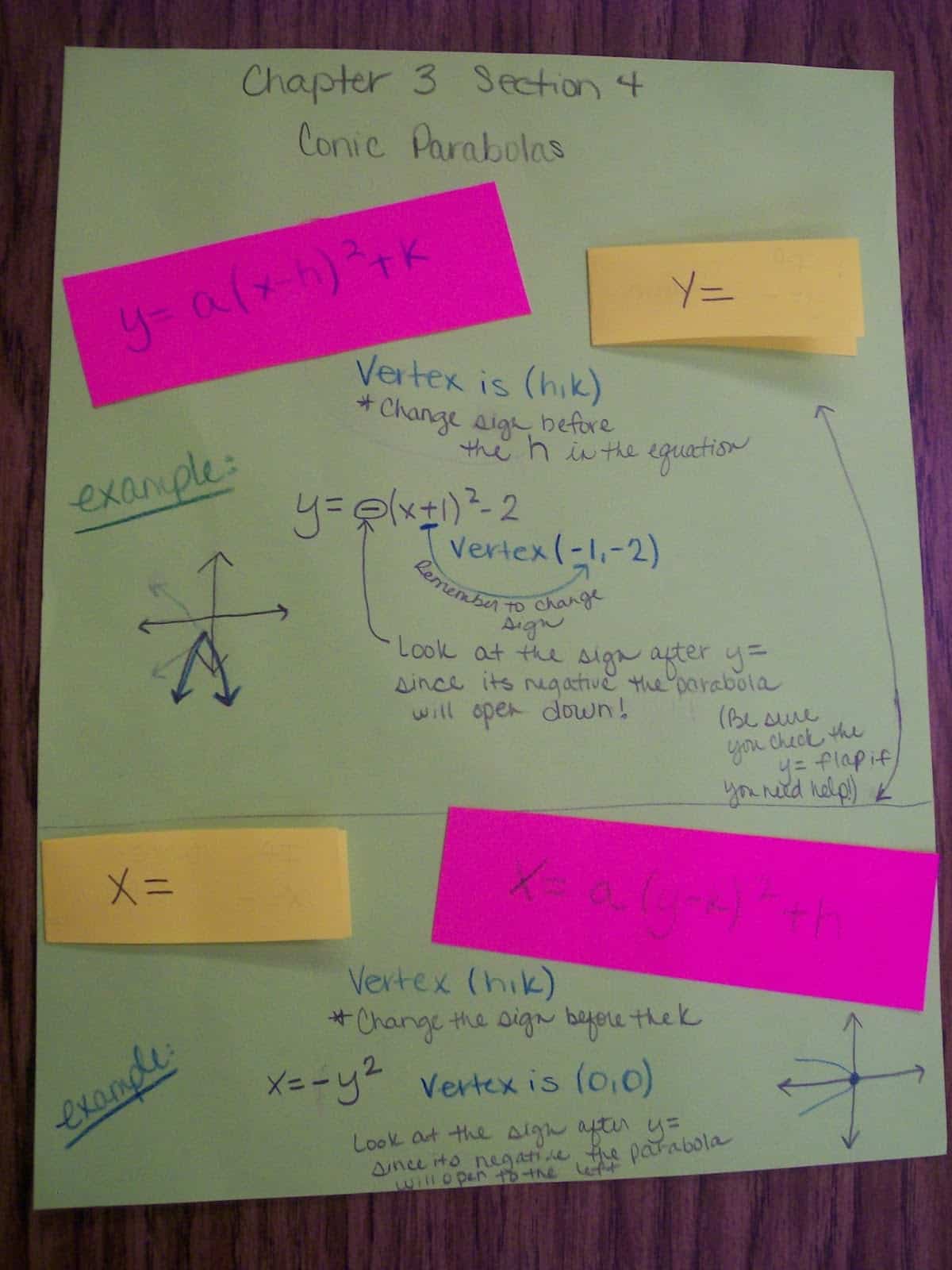
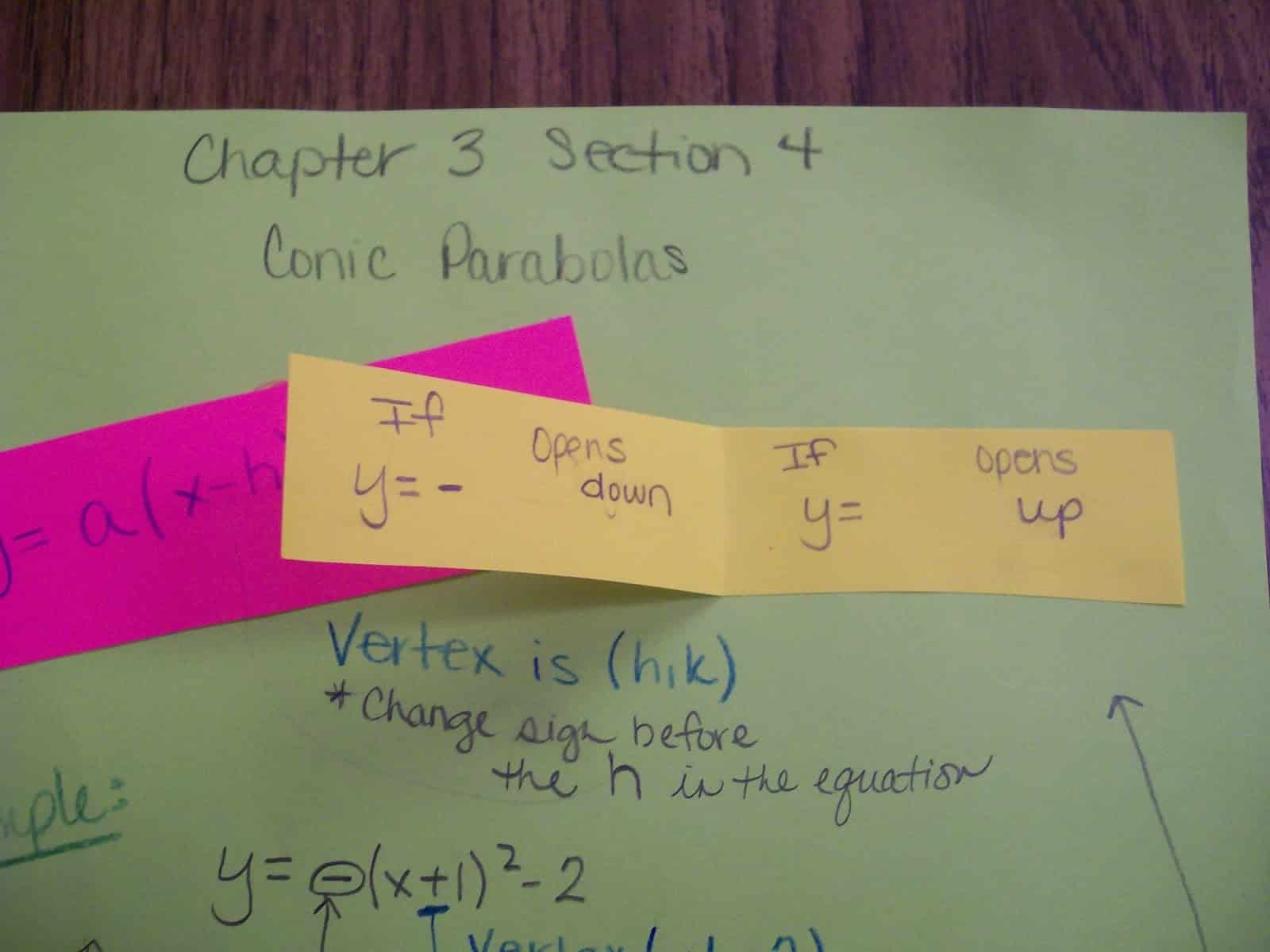

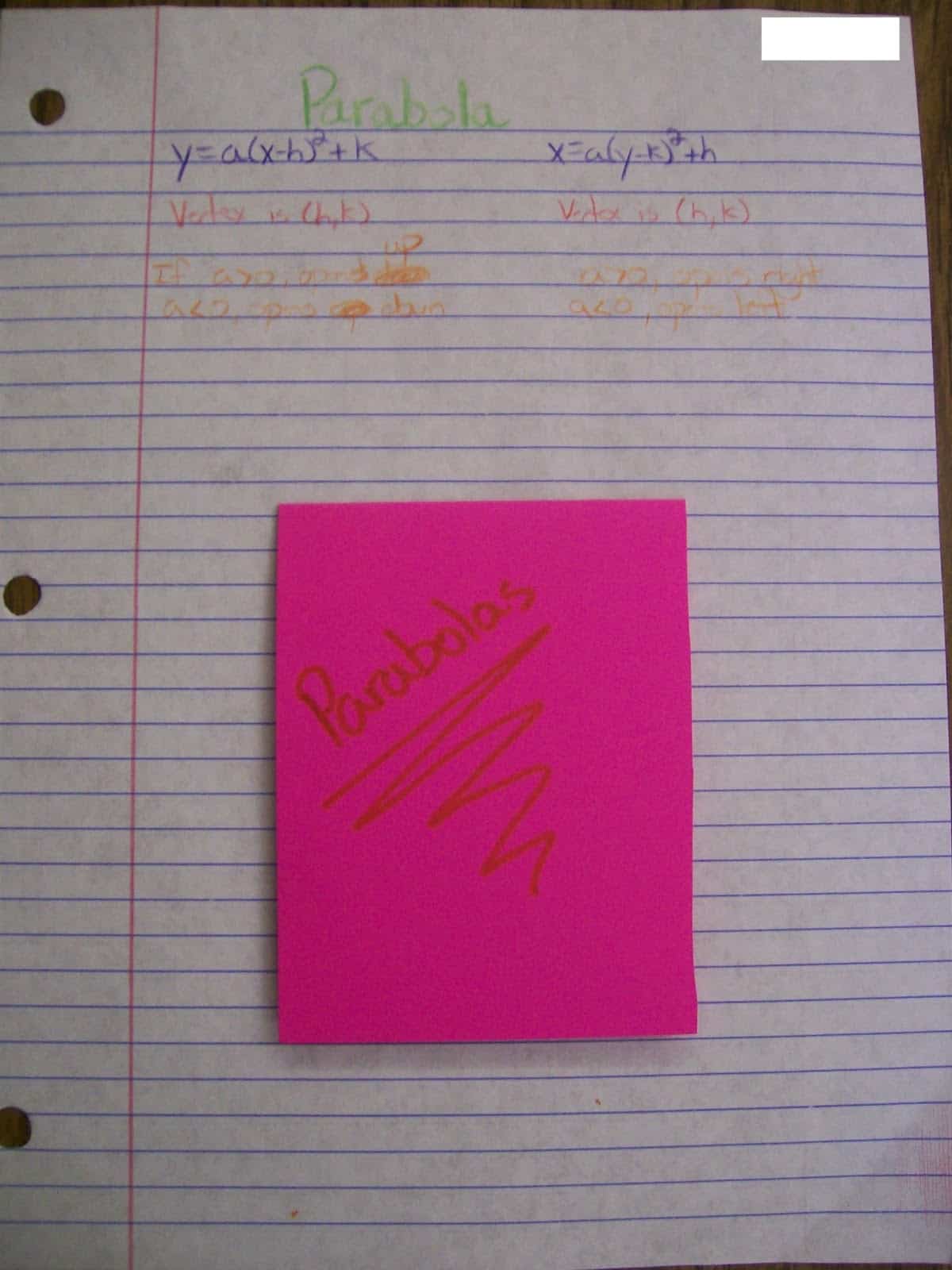
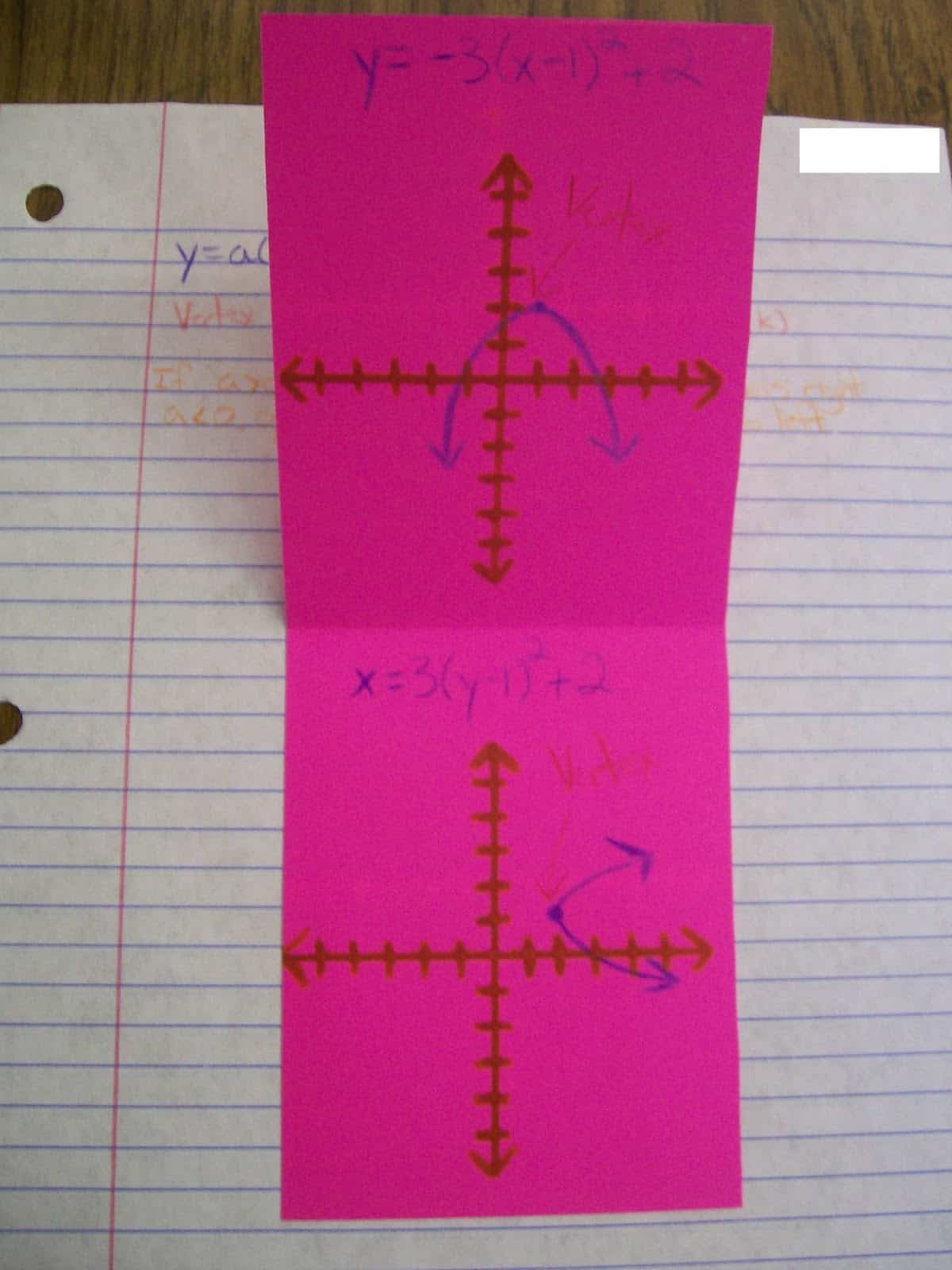
Hyperbolas
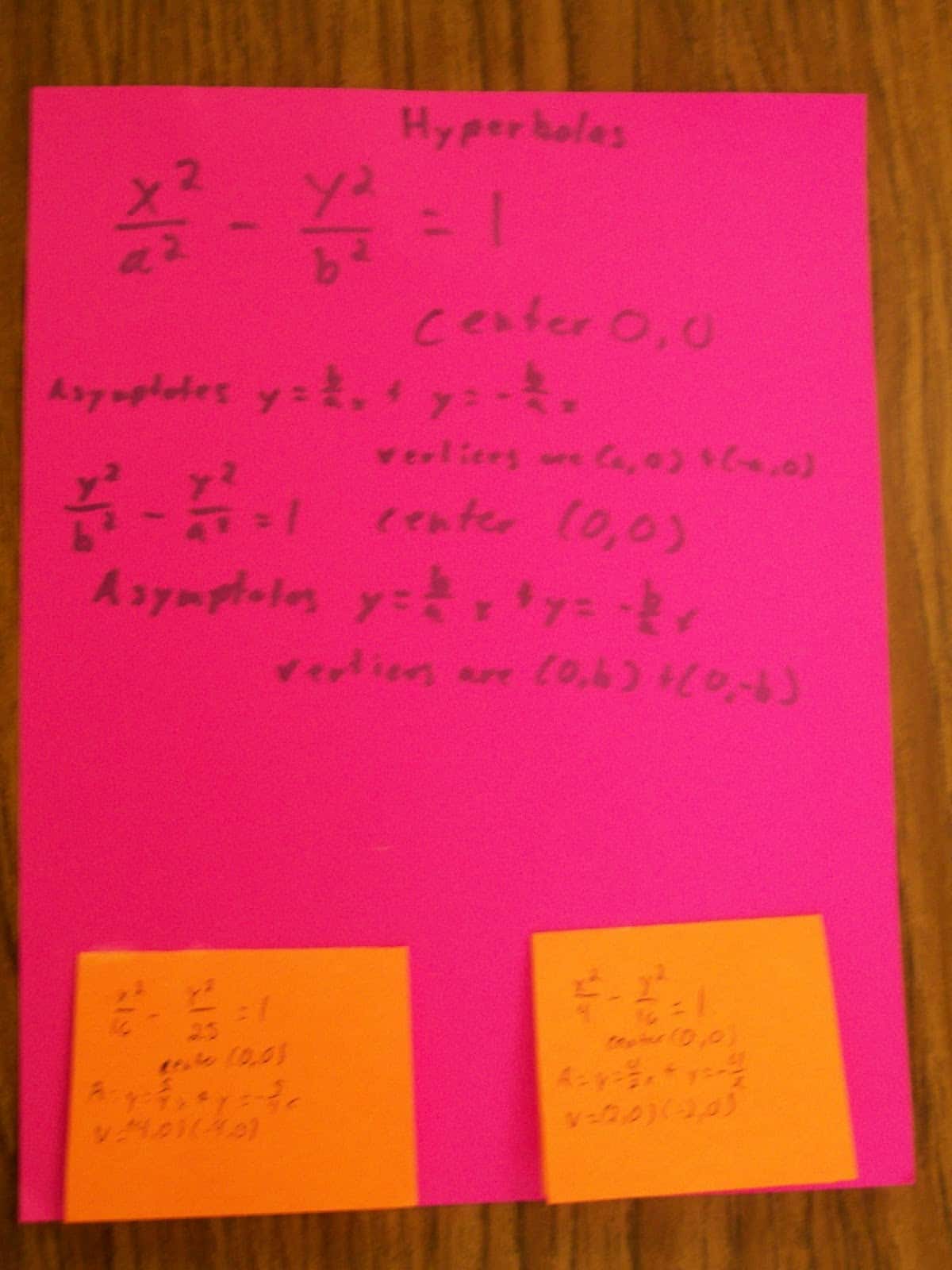
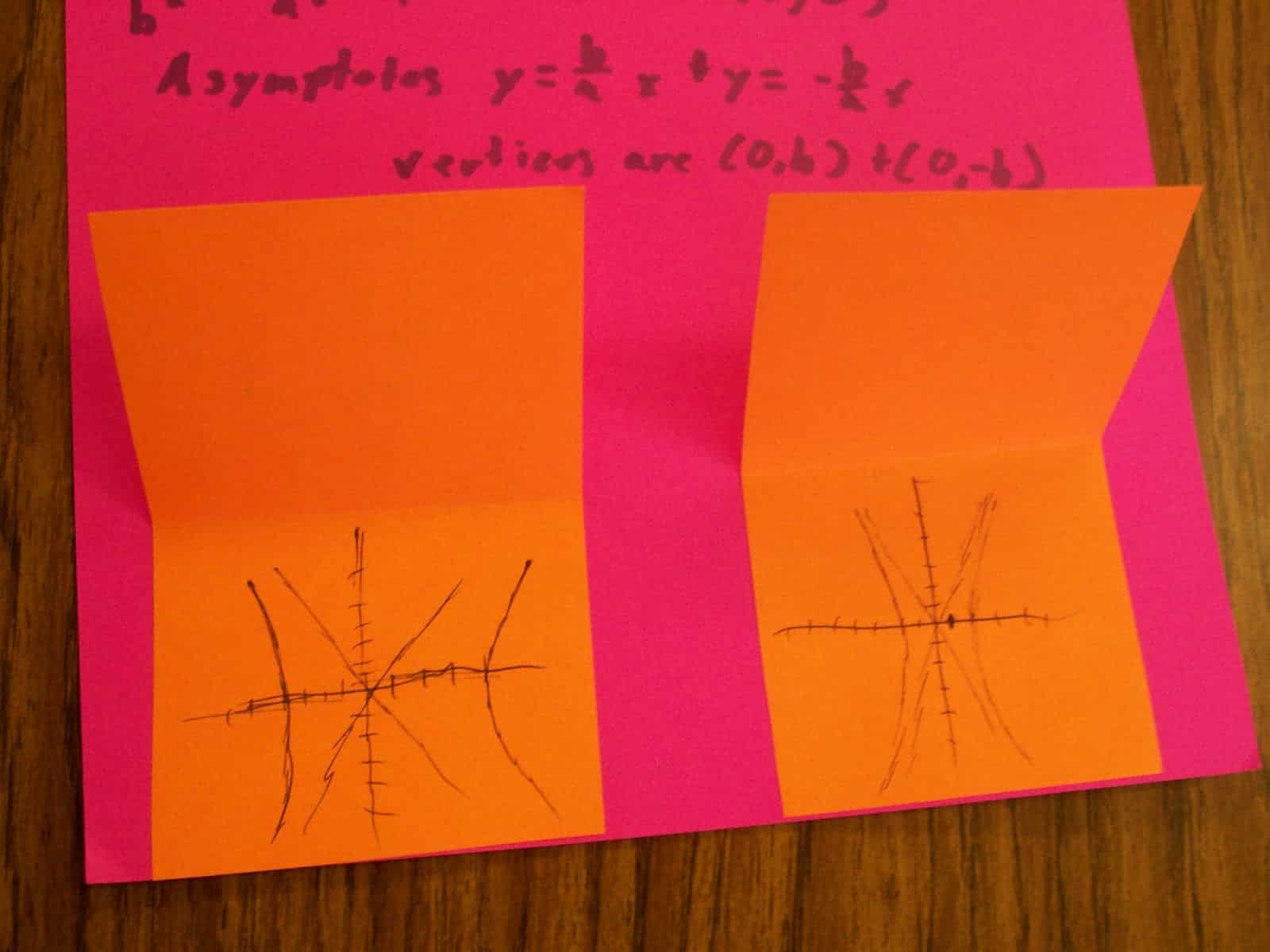
June 7, 2013 – Algebra 1 Advice
Last month, I posted excerpts from the letters written by my Algebra 2 students to future Algebra 2 students. Today, I’m going to do the same with my Algebra 1 students.
Here are my takeaways. I need to manage my classroom better. I used to think that classroom management just meant that I didn’t let my class get out of control. But, there has to more to it than that. I too often end up taking my frustration with one student out on my other students. And, my students don’t deserve that. I was happy to read lots of good comments about our interactive notebooks. Even though they are a lot of work, they are worth continuing next year. I may not have made my students love math, but I do think I taught them that algebra is do-able. I showed them that they could conquer something that others deemed too hard or impossible. My students learned more math than most thought possible.
This year was a success, and next year will be even better. I can’t wait to see my Algebra 1 students conquer Geometry next year. I’m kind of sad that I won’t be teaching them, but I think they know that I will be there to help them and cheer them on throughout the process. And, before I know it, they’ll be back with me again for Algebra 2.
Algebra 1 Advice from My Students
“You will not like the notebook, but it will help you in the long road.”‘
“Always use algebraic terms when talking to Ms. Hagan.”
“Never guess “C” on anything, it rarely works.”
“Next year, when you are introduced to Algebra 1, it will all look confusing. But I promise you, if you just pay attention and follow directions, you will be just fine. The most important thing is PAY ATTENTION. If you pay attention, it will be an easy class; if not, it will be your hardest class.”
“I’m not going to lie, algebra is not that easy, but you can make it easy as long as you pay attention. Ms. Hagan makes learning math fun and easy but if you don’t like doing the work and want to get rude, disrespectful then get ready for the worst year of your life. Ms. Hagan doesn’t play around when it comes to making sure you get your work done and turned in. By the way, I don’t care how tired or bored you are always get your work done.”
“Don’t get on Hagan’s bad side or she’ll get upset and yell at you and be all butt hurt for the rest of the day so be good and learn, its not that hard. She’s actually a super duper teacher. You get to play games a lot! It’s like third grade in here but we actually learn stuff we’re supposed to. AND WE COLOR! (sometimes)…(like at the beginning of the year…)”
“You will have fun in this class if you do all your work and do not talk. Well you need to make fun of her sometimes but don’t get in trouble so don’t do it on her bad days.”
“Always do what she tells you to do. No matter how ridiculous it sounds.”
“Ms. Hagan’s class is the easiest class I’ve ever done. It’s fun and makes Algebra easy. But, if she tells you that she thinks something’s fun? Don’t believe her! It’s a trap!”
“Shut your mouth and listen in this class or you will get in trouble! Miss Hagan is super mean! Her work is easy but the test is not!”
“This class may seem difficult at first, just keep trying. This is the first year that I have ever had an A in math. Keep up with your notebook, be nice to the teacher, and don’t mention [the science teacher]! Pay attention as much as you can, if you need help Ms. Hagan will help you.”
“My advice to you in Ms. Hagan’s class next year is to steal all her candy in her drawer, make up the work you miss, and be LOUD. Always do your homework and pay attention. Listen to your teachers and behave unlike me! Eat lunch with Ms. Hagan and give her your apple and milk and you’ll have lots of brownie points.”
“If you are coming into Ms. Hagan’s class please be nice. She is very sweet to most people. She doesn’t get mad very easily unless you are goofing off and not doing your work.”
“The thing I liked most about Ms. Hagan’s class was doing the notebooks. They actually help a lot with papers. If you study the notebook before the test, it’s very helpful.”
“Dude you may not like the class at first, but it is easy at first, but along the way it gets tougher.”
“Don’t argue with Ms. Hagan because she will send you to the office.”
“Dear Random Student who is being forced to take a class, Just turn in your assignments even if you don’t have it completely finished because ANYTHING is better than a zero. Also feel lucky if you get Ms. Hagan as a teacher, she is an amazing teacher that helps people understand math better.”
“My advice to you is to always, always, always pay attention. Try to be here as often as possible. PAY ATTENTION!!! I’s not hard if you pay attention and are here as much as possible. Don’t be afraid to ask for help if you don’t understand how to do something. She always explains things to you, and gives you shortcuts.”
“There are many terms that seem very confusing at first but if you listen you will understand it and it will be a lot easier.”
“I know algebra looks hard, but do not fear, it is easier than you think. Always listen to Ms. Hagan because once she explains how to do something, it’s so much easier to do.”
“Make sure to do all of your work and pay attention in class don’t get on Ms. Hagan’s bad side. If you pay attention you will do good on your EOI.”
“Make sure to do all your work and don’t mess around in her claws. When you are doing your work always try your hardest in her class. If you pay attention and listen she is a real good Algebra 1 teacher. A lot of her work is hard but you understand it after a while.”
“All I got to say is that you brace yourself for a lot of info and be sure to bring a notebook so you can take all the notes.”
“Keep your grade up and do what Ms. Hagan tells you to do. Never get on her bad side. Do all of your work and don’t get behind. Come to class every day ready to work because Ms. Hagan never will give you guys a free day. Don’t play around and do not laugh in her class because she gets really mad and will send you out. Do your own work so you can pass the EOI at the end of the year. Ms. Hagan is really easy to get a long with as long as you do what she says.”
“Algebra 1 is very easy if you just pay attention to class and it is sometimes fun, but at times you have to get serious and do your work.”
“Do not under no circumstances do not fall behind. Remember everything you get told.”
“Algebra is a very fun, creative class and you do a lot of fun stuff…Always show up to class on time and be ready to work hard.”
“You will have lots of work, but it easy and funny. It’s never boring in this class. You also need to be told about Ms. Hagan. She nice but don’t disrespect her.
“You will be doing a lot of coloring and glueing. This class may just be the easiest class you will have all through high school.”
June 8, 2013 – 50 Lessons Learned During My First Year as a Teacher
- Dry erase markers do not last long in the hands of teenagers.
- Always make your copies long before you will need them. If you wait until the morning you need them, the copy machine will be in use, out of ink, or tell you that it has an F2-37 error, and you will have to wait until the office calls the copy repairman.(While there are many perks of working in a small school, having only one copy machine is not one of them.)
- The Internet will be down on the exact days that you plan on using it in your lesson. The likelihood of the Internet being down increases when your principal is formally observing your lesson.
- Cutting with scissors is hard for students. And, it takes them way longer than you will intend.
- There is nothing more interesting to teenagers than your relationship status.
- Grants are great.
- The fact that you are a vegetarian will spark more questions than you could ever imagine.
- The youtube videos that make your students groan and complain in class will be shown to their friends outside of class.
- If you plan on showing your students a math rap, make sure you like how it sounds. You will hear it for weeks.
- Make notes next to grades in the gradebook. It’s a lifesaver. And, one parent will actually read them.
- Some students will need to keep their INBs in your classroom. Let them. It will save you both a ton of hassle.
- When the electric pencil sharpener no longer works, that is a sign that it’s time to empty it.
- If the handle to your manual pencil sharpener goes missing, look inside the pencil sharpener.
- Colored paper makes everything more fun.
- Work out ALL of the problems on any worksheet you download from the Internet. No matter how good it looks, there will always be that one problem that ends up giving your students more grief than necessary.
- Long days are inevitable. A filing cabinet drawer full of snacks makes it better.
- Hand Sanitizer is your best friend. Cold and flu season makes you aware of every door knob you touch.
- Keep your pens and pencils separate from the ones you let your students borrow. They will not bring them back.
- Extra-curricular activities are a ton of work. But, they allow you to meet a ton of great students you wouldn’t normally get to work with.
- Some days, it’s in your best interest to just leave your to-do list at work.
- Chocolate. Ice Cream. TV Shows Involving Murder and Mysteries. Find the things that help you recover from a bad day.
- Some of the best lessons come from trying a last-minute idea. Some of these ideas lead to the worst lessons ever, too. That’s okay. Nothing ventured. Nothing gained.
- Meetings will take you out of your classroom more than you like. Always have an emergency lesson plan ready just in case.
- Smile. Even when you don’t feel like it, smile.
- Communicate with your principal. It will save you a lot of problems later on down the road.
- Become best friends with the counselor. She will save your life multiple times.
- Find a support group within your school. They will help you maintain your sanity. The daily battle is easier to fight when you know you’re not alone.
- Fill your desk with important things like bandaids, safety pins, bobby pins, and hair ties.
- Don’t hang origami from your ceiling unless you want to hear incessant begging from your students until you teach them how to make said origami.
- 500 sheets of origami paper doesn’t last very long.
- If you’re really and truly sick, it’s okay to take a sick day. Your health is important. Go to the doctor.
- Always make more copies than you will need. Then, make a few more copies just to be on the safe side.
- Make sure you don’t forget to eat breakfast. It’s easier to do than you think. It’s even possible to be so busy that you forget to eat lunch.
- Always make sure you introduce yourself at an IEP meeting. Especially if you regularly get mistaken for a 16 year old.
- Your students may hide when they see you in Wal-Mart, but be prepared to answer lots of questions about what they see you putting in your shopping cart. I never realized buying a can of black beans could be so controversial.
- It’s important to have a plan to manage all the papers that come across your desk. I have always thought of myself as an organized person, but you couldn’t tell that from the state of my desk.
- An electric label maker will keep students captivated for a long time.
- Teenagers will complain about cutting, gluing, and coloring. Don’t believe them. They secretly enjoy it even if they won’t admit it.
- Write down the funny things that students say. If you don’t, you will forget them. And, there’s nothing more fun than flipping through student quotes when you need a quick pick-me-up.
- When a student writes you a nice note, keep it in a special place. These are what I turn to when I feel like I’m not making a difference.
- Word about you and your teaching style will spread around the school. Some will be good. Some will be bad. Be thankful for the good and forget the bad.
- Invitations to an IEP meeting are blessings in disguise. Yes, they take a lot of time. But, I learned more than I could ever imagine.
- Students will do almost anything to earn a cheesy “Super Star Student” Award.
- You can never be too specific with your instructions.
- Classroom decorations matter. You spend hours a day in your room. Make sure your room makes you smile.
- Students show that they care about you in different ways than you might expect.
- Sometimes it gets worse before it gets better. Sometimes it gets a lot worse. In this case, seek out #27.
- Progress is not always immediate. Slow progress is still progress.
- If you need help, ask. Teachers love to help teachers. But, sometimes asking for help is hard.
- Never stop learning. My students push me to know my subject area better. Blogging pushes me to be a better teacher. I’m continually inspired to become a better teacher, and I hope that desire never ceases.
June 11, 2013 – Cardboard and Fish Stories
I sometimes wonder if the things that come out of the mouths of my students will ever stop shocking me. As I’ve been cleaning up my classroom and attempting to organize all the papers I’ve collected over the past year, I’ve ran across several notes I’ve jotted down of crazy things that my students have said.
Scenario 1
Towards the end of the year, I had to tell one of my Algebra 1 students to please stop eating a piece of cardboard. He didn’t. I did google it to make sure it wasn’t deadly or anything. He ended up eating a piece of cardboard that was probably 6 inches by 2-3 inches.
Scenario 2
One day I asked my 8th grade Algebra 1 students what a quadratic was. We’d talked about them the previous week, and I was trying to help them refresh their memories. Without missing a beat, one student responded, “It’s what happens at an aquarium when the fishies die.” That gave the class a good chuckle.
Scenario 3
Late first semester, I was tutoring a student to help her prepare for her upcoming EOI exam. We’d been at it awhile, and I could tell that we were both getting tired. When I looked up from writing something down, this student had a bobby pin stuck over her lip. After I gave her a strange look, she announced, “Now I know why fish don’t like this.” We wrapped up our study session soon after that, and she did end up making advanced on her EOI!
June 19, 2013 – Common Core Training Reflection
I’m attending an amazing Common Core State Standards workshop this week for high school math teachers. It’s called the Oklahoma Geometry and Algebra Project (OGAP.) I’m two days into it, and I’ve already learned so much. For once, I’m actually able to visualize my students doing Common Core level work. Before I learn anything more, I decided that I need to try to write down what I’ve learned so far and attempt to process it. My list of things I want to do before school starts is growing rapidly.
Before starting this workshop, I was terrified of Common Core. I’d printed off the standards, but I really had no idea where to start. The only help my district provided was a poster to hang on the wall that contained all of the standards. We’ve been studying the Standards for Mathematical Practice, and I think I’m finally starting to understand what they might look like in the classroom. As we complete activities, we have been finding exactly which standards they align with. The more time I spend with Common Core, the less I dread it. Yes, I’d rather not have to learn a new set of standards. But, these standards will make me into a better teacher. They will help make my students into better thinkers and problem solvers. It’s going to be a rough transition. But, I’m excited now to challenge my students so I can watch them rise to the occasion.
I don’t know if any of this information will be of use to anyone else. But, I’m putting it out here in the hopes that it might be. And, if it’s on my blog, I’ll be more likely to find the information again than if I have to go searching for the many post-it notes that this information is currently written on.
Personality Test
One of the first activities we did was a True Colors Personality Test. I had never done this test before. After choosing which words best describe you, the test will tell you whether you are primarily Blue, Gold, Orange, or Green. Blue people value relationships. Gold people value duty and responsibility. Orange people value freedom. And, green people value information and knowledge. I was not surprised to find out that I was almost pure Gold. My perfectionism, my obsession with to-do lists, and my need for order attest to this.
I’ll be honest. At first, I thought this activity was kind of silly. Okay, I’m gold. Now what? But, as the week progresses, the other teachers and I are constantly realizing how knowing someone’s color sheds a lot of light on why they do what they do. I think this would be beneficial to do with my students at the very beginning of the school year. I’d also love to do this as an activity with my fellow teachers. I’m going to be part of the professional development team at my school next year, but I’m not sure we will have time for this on our only in-service day before school starts.
If you’re interested in learning more about this personality test, I found some great copies of the test and explanations of the meanings of the colors online. Let’s just say there is a whole lot more to the colors than the one-word descriptors I wrote above!
Graphing Calculators
As part of the workshop, each teacher received a new TI-84 Plus C Silver Edition Graphing Calculator. This is my first time to use a calculator that graphs in color. I like that you can choose what color to graph each line or set of data in. And, the adapter that allows you to plug it in to charge is also a nice feature. The menus and features are similar but not exactly the same as the TI-84s I already have in my classroom. However, it was suggested today that we update the operating system on all of our TI-84s. I definitely need to look into that this summer and get it done before school starts back up! I think the color and other added features may have slowed down the calculator a bit. I find myself sometimes getting impatient with the calculator because it doesn’t graph things as quickly as I think it should.
One thing that was mentioned this week was that we need to force our students to choose their own window when graphing with the graphing calculator. Our students need to think. And, teaching them shortcuts such as Zoom Fit doesn’t require them to think. Thinking should be our goal. I’m definitely guilty of this.
We’ve done several activities that involved collecting real-world data, creating a scatter plot on our graphing calculators, and using the linear regression feature to find a line of best fit. As a way to start learning everyone’s names, we timed the teachers at the first table as they said their name and their color from the personality test. Then, we timed the teachers at the first and second table saying their name and color. This continued until we had made it all the way around the room. This gave us a set of data to enter in our graphing calculator. We used linear regression to find the line of best fit for our data. I think this would be a great way to review the concepts of slope and y-intercept with my Algebra 2 and Statistics students.
Participating in this activity makes me hope that the grant I wrote for a classroom set of various measurement tools gets funded. I really need stopwatches for my students to use! I’m going to have my Algebra 2 students start getting used to the graphing calculator from Day 1 next year. And, I will expose my Algebra 1 students to the graphing calculator next year to help them prepare for Common Core even though the graphing calculator will still not be allowed on next year’s Algebra 1 EOI exam. If I don’t start my Algebra 1 students now with the graphing calculator, I will be putting them at a disadvantage when they get to Algebra 2.
We also used stopwatches and our graphing calculators to complete the Bouncing Tennis Balls activity from NCTM Illuminations.
Collaborative Learning
“Collaborative learning [group work] involves more than students sitting around a table and working on the same task.”
If I’m going to use collaborative learning in my classroom, I need to establish norms. And, I need to hold my students accountable for maintaining those norms.
If a student is off-task, approach them with a question instead of a command. It’s much more powerful to ask, “What do you need to get started today?” than to tell them to get to work.
Teachers must make thinking intentional.
As teachers, we are not the only people with knowledge in our classroom.
Our students need to experience constructive struggling. We read this article about constructive struggling, and it was eye-opening.
We typically give students easy problems that later build to harder problems. What if we started giving our students the hard problems first?
In a collaborative learning classroom, students should not ask the teacher for help unless they have already asked every single group member for help.
Don’t ever take the pencil out of the hand of the student you are helping!
Students (and teachers) need to know that helping is not the same as telling.
If you want your students to be accountable, here are some rules you can implement: You can write only on your own paper. You can let people see your paper, but you cannot hand it over to somebody else.
Provide students with sentence starters to help students discuss their thinking together. (I need to make a poster of these to hang in my classroom!)
Function Notation
My Algebra 1 students really struggled with understanding function notation last year. Today, we did a great activity that links the concept of function notation to a family tree. This activity is taken from the October 1987 issue of the Mathematics Teacher. I found a link to a pdf copy of the activity online. Before I use this with my classes, I will definitely be retyping it and making sure that every single person in the family tree has a name that starts with a different letter of the alphabet. I love how this activity quickly moves students from reading function notation to finding the composition of two functions.
I’m hoping that my students will start to understand exactly what function notation is. f(x) does not mean f times x. And, I’m hoping this will help keep them from deciding that they must divide both sides by f in order to get x by itself.
July 3, 2013 – Reflections on a Future Lesson: Rationalizing the Denominator
I actually wrote this in response to the Week 1 topic of Walk the Plank Wednesdays. I’m so excited about what I wrote that I decided to break my unintended blog hiatus with this post. I actually have yet to read Teach Like A Pirate. I’m hoping to get to it this weekend. Most of my reading of late has been either Embedded Formative Assessment (amazing!) or non-school related reading.
Note to self: attending back-to-back week-long math teacher conferences is inspiring and really, really draining. I saw all kinds of really cool ideas that I want to blog about, but my motivation has been extremely lacking. So, without further ado, I present: Why I’m Actually Excited About Teaching My Students to Rationalize the Denominator Next Year
Until I went to a Pre-AP Math Conference last week, I had no idea why it was customary to rationalize the denominator of a fraction. I never questioned the practice when I learned it in school. Last year, I simply taught my students that “mathematicians don’t like to have radicals in the denominator.” They complained and weren’t quite satisfied with that explanation.
Next year, I will introduce the concept of rationalizing the denominator by taking away my students’ calculators and providing them with square root charts like those found in old math textbooks. I will ask them to find the numerical approximation of 1/sqrt(2). After suffering through having to divide 1 by 1.414, I hope they will ask for a better way.
Then, we can talk about how a fraction remains equivalent as long as the numerator and denominator are multiplied by the same value. I will ask students what they think we should multiply the numerator and denominator by. Hopefully, someone will suggest that we multiply the numerator and denominator by sqrt(2). (Of course, I’m going to make my students try out all the other possibilities that are suggested, too. They are going to absolutely love me!) Then, we will use our chart to divide sqrt(2) by 2 or 1.414 by 2. This division problem is much, much nicer. Most students should be able to do this in their heads.
I can see myself bringing out the stopwatches and breaking the class into two groups. I will put an expression on the board that involves a radical in the denominator. The goal is to find the numerical approximation of the value. One group will solve the problem using the square root chart without rationalizing the denominator. The other group will solve the problem using the square root chart with rationalizing the denominator. What is the time difference? If you had a homework sheet of 20 problems, how much time would you save by rationalizing the denominator?
I want my students to see that rationalizing the denominator does have a purpose. Or, it did have a purpose in the days before calculators. Yes, in this current day of technology, we just type 1/sqrt(2) into our calculator and let it do the work for us. Hopefully, seeing the historical reason behind the mathematical process will help my students understand why we rationalize the denominator and the process will be more meaningful to them.
With Common Core and the increased emphasis on writing, I’m always on the lookout for creative ways to fit more meaningful writing into my math lessons. Oklahoma’s current Algebra 1 EOI features specific questions on rationalizing the denominator. I think I will have students write a memo/letter/speech/etc to the State Department of Education expressing their thoughts on whether students should or should not still be required to rationalize the denominator in light of technological gains. I need to look into the Common Core Language Arts standards and pose this question in such a way that it matches what students will be required to write on their end of year test.
July 28, 2013 – Preserving Classroom Memories
Last year, I knew that I wanted to make sure that I had a way to ensure that I preserved the classroom memories that are easily forgotten. These are the funny things that students say or the lessons that go extremely well or the compliments that are passed on.
I kept a glass jar on my desk last year, and I tried to remember to write down these memories on individual post-it notes. I folded them up, and I told myself that I would sit down at the end of the year and read them all. Of course, my students were extremely curious about the jar. When I told them my plan, they somehow assumed that this meant I was going to read the notes to them at the end of the year. Much to their disappointment, I didn’t. In retrospect, I think I should have pulled out all the ones I wanted to keep private and then shared the rest with my students. Next year, that will be my plan.

A couple of weeks ago when I started decorating my classroom for the upcoming school year, I saw the jar on my desk and realized that I had never sat down and read the notes. As I opened and read each note, I couldn’t help but smile. Reading these reminded me just how fun teaching is. Working with teenagers can be frustrating and stressful, but they are also just funny. My students are very honest and candid which can lead to hurt feelings. But, it also means that their compliments and comments carry great weight. I love my students, and I can’t imagine a better job.
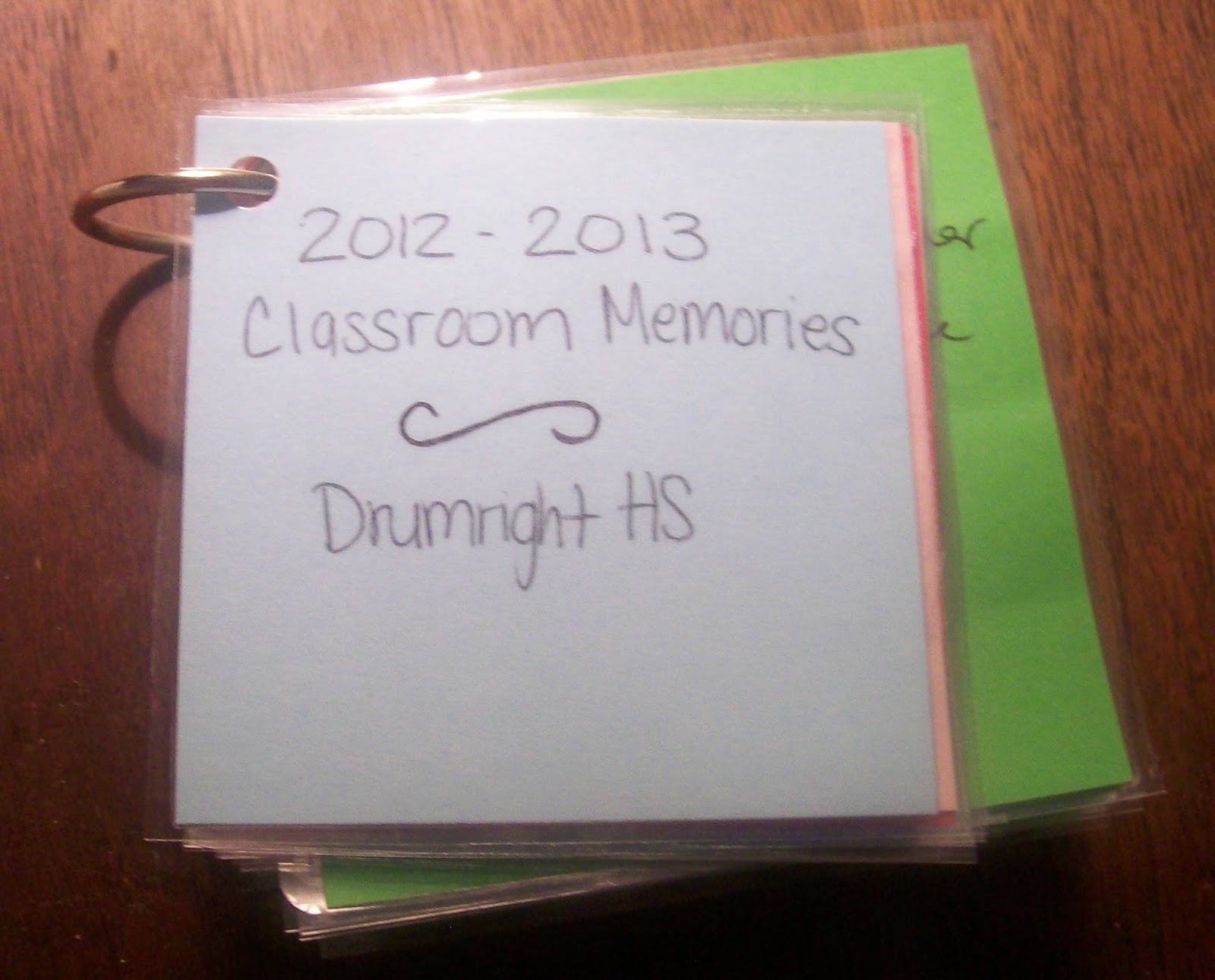
After opening and reading all the notes, I knew I wanted to keep them, but I was unsure how to go about that. While reading my favorite memories to my younger sister, she suggested that I could laminate the post-it notes to. So, I pulled out my trusty laminator, a single hole-punch, and a binder ring. And, I used these to create a book of memories.
This is the perfect size to tuck in my desk drawer for those days when things just don’t seem to be going right. I can pull out these memories and remember all the good days. I want this to become a yearly tradition.
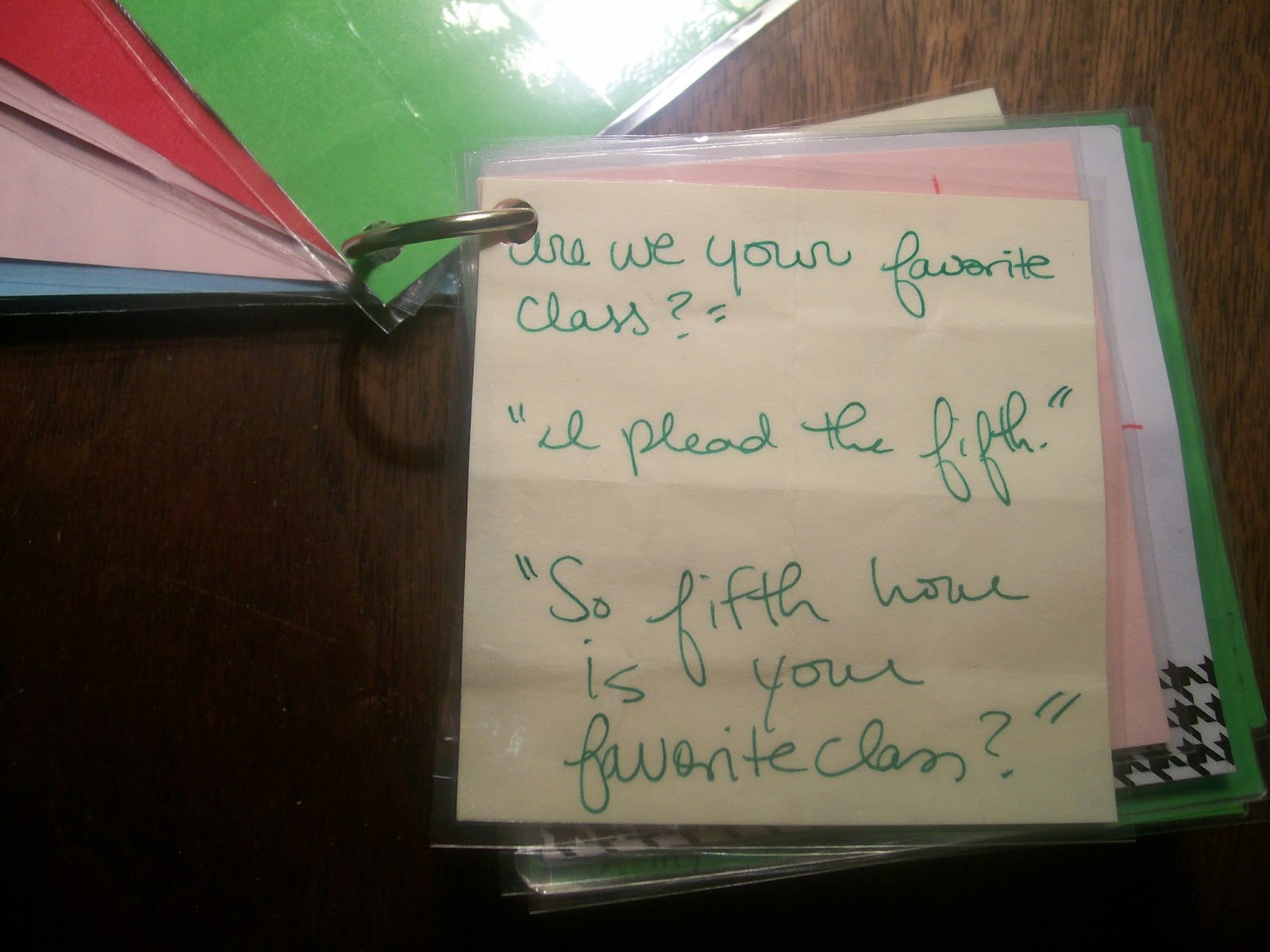
Knowing that I’ll be keeping these forever, next year I pledge to use better handwriting. Most of these memories were jotted down quite hastily, and it shows. Also, I want to do a better job of keeping up with my memory jar next year. Last year, I wrote a bunch at the beginning of the year, and it kind of tapered off as the year progressed.
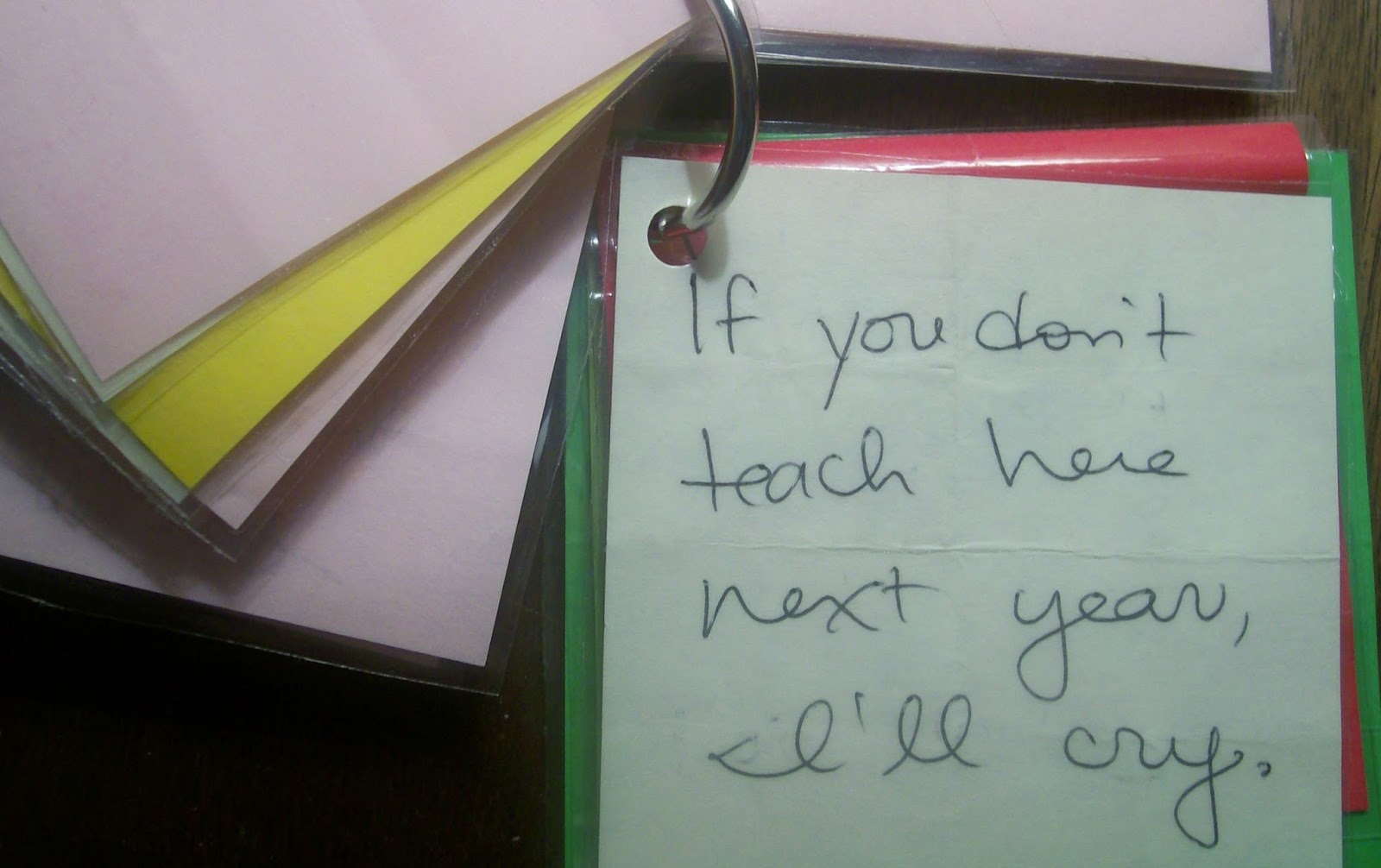
My neighbor coming to school and trying to give me a couch.
Hearing a parent at an IEP meeting say “You’re the first teacher EVER that I have heard [my daughter] say that she likes.”
Getting called Mom for the first time.
Seeing the joy on a student’s face after she discovers a way to determine which symbol represents less than and which symbol represents greater than. Hearing her exclaim, “This just made my day,” wasn’t too bad either…
Snowball fights to practice solving equations.
“Wow. It looks like you could really learn in here.” – A student up on seeing my classroom for the first time.
“You’re not my favorite teacher, but you are my best teacher.”
“It feels beautiful in here.” (Said in regards to the fact that I had the heater on.)
“What is a quadratic?” “It’s what happens at an aquarium when the fishies die.”
Celebrating Universal Letter Writing Week with my students. The best part was seeing the reactions of the teachers and staff members who received the letters.
“Is Texas in Oklahoma?”
“I asked for a dreidel for Christmas.”
“You can’t call it a hamburger fold because you don’t eat hamburgers.”
“Am I the only person who makes the bellies of my fives really fat?”
“Are fish sticks really fish?”
“It’s weird seeing teachers in public. They shouldn’t have a life outside of school.”
“I don’t think Slope Dude has any friends.”
“I’m gonna name my kid ‘Parabola.'”
“You make math fun.”
“If you don’t teach here next year, I’ll cry.”
“I’m gonna name my kid ‘Perpendicular.'”
July 31, 2013 – Interactive Notebooks Q & A
Today I’m sharing an Interactive Notebooks Q & A where I answer questions I have received recently about using interactive notebooks in the secondary math classroom.
I hope you guys are all enjoying your summers! My summer is coming quickly to an end. I have to report to work on August 7th, and I will have students in my classroom on August 8th. Seeing as tomorrow marks the end of July, I do not have long. I’m excited to go back. I’ve been missing my students. One of the perks of working in a small school is that I will still get to interact regularly with my students even if I they aren’t in my math class this year. The other math teacher’s classroom is right across the hall from mine, so I will still see them every day. I can’t wait to see their faces when they realize how much algebra they are going to get to use in geometry!
Now, what I haven’t done a lot of (or any of) this summer is lesson plans. So, the next week is going to be spent mapping out, in detail, at least the first full unit for each of my three preps – Algebra 1, Algebra 2, and (AP?) Statistics.
This summer, I’ve focused a lot on learning. 16 days of my summer have been spent at conferences. I’ve learned a ton about the Common Core State Standards, teaching Pre-AP Math, teaching AP Statistics, and just teaching in general. In a way, it’s kind of been information overload. I’ve learned about using Socrative, Edmodo, Fathom, and TI-Nspire calculators in my classroom. I’ve learned about how to teach math using M&M’s, Barbie Dolls, Tennis Balls, Racquet Balls, Fruit Loops, Nerf Guns, pieces of rope, and other everyday items. I haven’t found the time to process most of this new information this summer via my blog, and I regret that. A lot of my blogging is for me. If I don’t blog about something, odds are I will forget about it.
I am still amazed today that others find my ramblings useful. With one year of teaching under my belt, I don’t feel like I’m anywhere near having this teaching thing figured out. And, I’m not sure I will ever get it figured out. There will always be more to learn, and I don’t think I would have it any other way. Over the past few months, I’ve found lots of questions in my inbox regarding interactive notebooks. Actually, I think searching for information on interactive notebooks is the way most people find my blog. And, you can thank @druinok for that. She kinda made me promise to post lots of pictures of my interactive notebook pages.
So, I thought I should share some of the questions and my answers here in case they were of interest to anybody else. If you have other questions, please leave a comment or click the tab at the top of the page that says “Contact Me.” And, when I finally get around to answering the rest of the e-mails that are languishing in my inbox, I’ll have another post full of tips for you! (Hopefully this post will motivate me to tackle the rest of my inbox!)
Interactive Notebooks Q & A
I am going to use interactive notebooks this year and really love what you’ve done, but I teach geometry, so I was wondering if you knew anyone, or worked with anyone who has a blog, with as much material and ideas, but in regards to geometry.
Answer
Off the top of my head, I would recommend checking out a blog called Journal Wizard for geometry interactive notebook resources. I’ve seen SO MANY amazing geometry ideas there lately. You also might want to check out Everybody is a Genius for other interactive notebook resources!
I have been reading it for the past couple of weeks getting ideas for INB’s. I’m super excited about using them in my Algebra 2 classes next year and I’m trying to get a head start on planning.
I see that you use a composition book for your notebooks. How many did you have to use in your Algebra 2 class, or was one composition book enough? I’m new to the INB’s and I’m trying to get all my ducks in a row 🙂
Answer
One composition notebook was enough for both my Algebra 1 and Algebra 2 classes. I think the number of notebooks needed depends on exactly what you put in the notebook. I only have my students put notes in their notebook. Other teachers have them do their bellwork and homework in the notebook as well. That takes up a lot more pages. I can see benefits to that approach, but I prefer to reserve our notebook pages for notes. My students know that if something is going in our notebook, it must be important. They have a tendency to remember exactly where they have written everything in their notebook, and they can flip to the needed information in just a few seconds.
I have recently been encouraged to do interactive notebooks with my students but I’m not sure how they work and where to start. Do you have any helpful advice for me? I am very interested from your slope posts as to how helpful this would be for my students!
Answer
I would start off by determining what the most important things you want your students to learn from your math course are. Can you turn this information into a graphic organizer or foldable?Or, can you give the information to your students in note form and have them transform it into a drawing, flow chart, or other sort of representation?
With my Algebra students, I try to have them create one interactive notebook page per lesson. Some lessons are finished in a day and some span a week. I have seen other teachers who have their students create notebook pages every day. Others might only do a page or two per chapter. Megan Hayes-Golding has created a sort of interactive notebook home page that contains links to lots of informative posts on interactive notebooks. I think this would be a great starting place.
When I decided to implement notebooks last summer, the best thing I did was to set down with my textbook and a old, partially used composition notebook. Without really knowing what I was doing, I just started creating pages. There is a definite learning curve, and a lot of the pages I did with my students looked nothing like those first drafts of pages I created during the summer. There are tons of ideas on the internet, and I can’t tell you how many pages have been either stolen from or inspired by things I found on the internet.
Do you have any suggestions for school supplies that the students will need to bring with them?
Answer
The only supplies that I required my students to bring last year were a composition notebook and something to write with. I provided my students with colored pencils, scissors, glue sticks, markers, tape, notebook paper, graph paper, calculators, rulers, and anything else they needed. One of the reasons I provide so many of my students’ supplies is that I teach in a high poverty area. In many schools, these items would probably be provided by the students.
Love your math notebooks. Which do you prefer, composition books or binders? I have done the Notebooks for science and social studies both ways but this year I’m doing one for math also.
Answer
I prefer for my students to use composition notebooks. I find that my students are more likely to keep up with a composition notebook than a binder and less likely to steal paper from it for other classes since it is bound. I had several students last year who did use a binder, and that was perfectly fine. I let them choose whatever worked best for them. I also had one class of students that used spiral notebooks instead of the composition notebook.If your students are already used to carrying a binder, that may be the way to go. That isn’t the case in my school. And, I have many students who end up leaving their notebooks in my classroom. The notebooks take up much less space than binders would. I guess there are tons of variables to consider!
Did you give your students written instructions on how to set up the interactive notebook? If so, could you post it?
Answer
I didn’t give my students written instructions to set up their notebooks. At the beginning of the school year, I would model how I wanted something done and then give them time to complete it in class. We spent one entire class period creating our cover page, gluing in the syllabus, and making the table of contents. I did include some limited information about their interactive notebooks in the syllabus.
I am always looking for ways to make students fall in love with my “love”. I am very interested in your interactive notebook. Would you please let me in on your tips? I noticed that you use composition notebooks. Do you pre print the notes and have them cut and paste into their notebook? Are they glued in with something like glue sticks? How time consuming is it? For you and the students? (for me ….because I currently have 6 different preps) Were the students already used to this type of notebook? (I just think it’s the coolest thing.)
Answer
Composition notebooks are great. The pages are bound and cannot be easily torn out. Spiral notebooks provide more space to write, but their pages can be torn out much more easily. I had several students move in from another teacher’s class that ended up using spiral notebooks. I think either can work great. I pre-print the notes and have my students glue them in their notebooks. We use glue sticks, but many other teachers prefer to use scotch tape. I invested in several dozen of those gigantic glue sticks, and they seemed to work quite well. I’ll be honest. It’s time consuming. I’m pretty sure that my students are the slowest cutters and gluers in the world. But, my students use their notebooks all the time, so it’s a price I’m willing to pay. I spent a lot of time preparing stuff for the interactive notebooks last year. I worked late many nights, but it was also my first year of teaching. So, I would have probably been working late whether I was doing interactive notebooks or not. As the year went on, my students became faster at putting things in their notebook, and I became faster at creating notebook pages. I can’t imagine having six preps, and I applaud you for that. I have three preps, but I only used the notebooks with two of those preps. My other class got really jealous, though, when they found out that the other classes got to do “arts and crafts.” My students were not used to interactive notebooks. This was a new experience for all of us. I did have a student move in part of the way through the year, and he brought his interactive notebook from his old school with him. It was pretty cool!

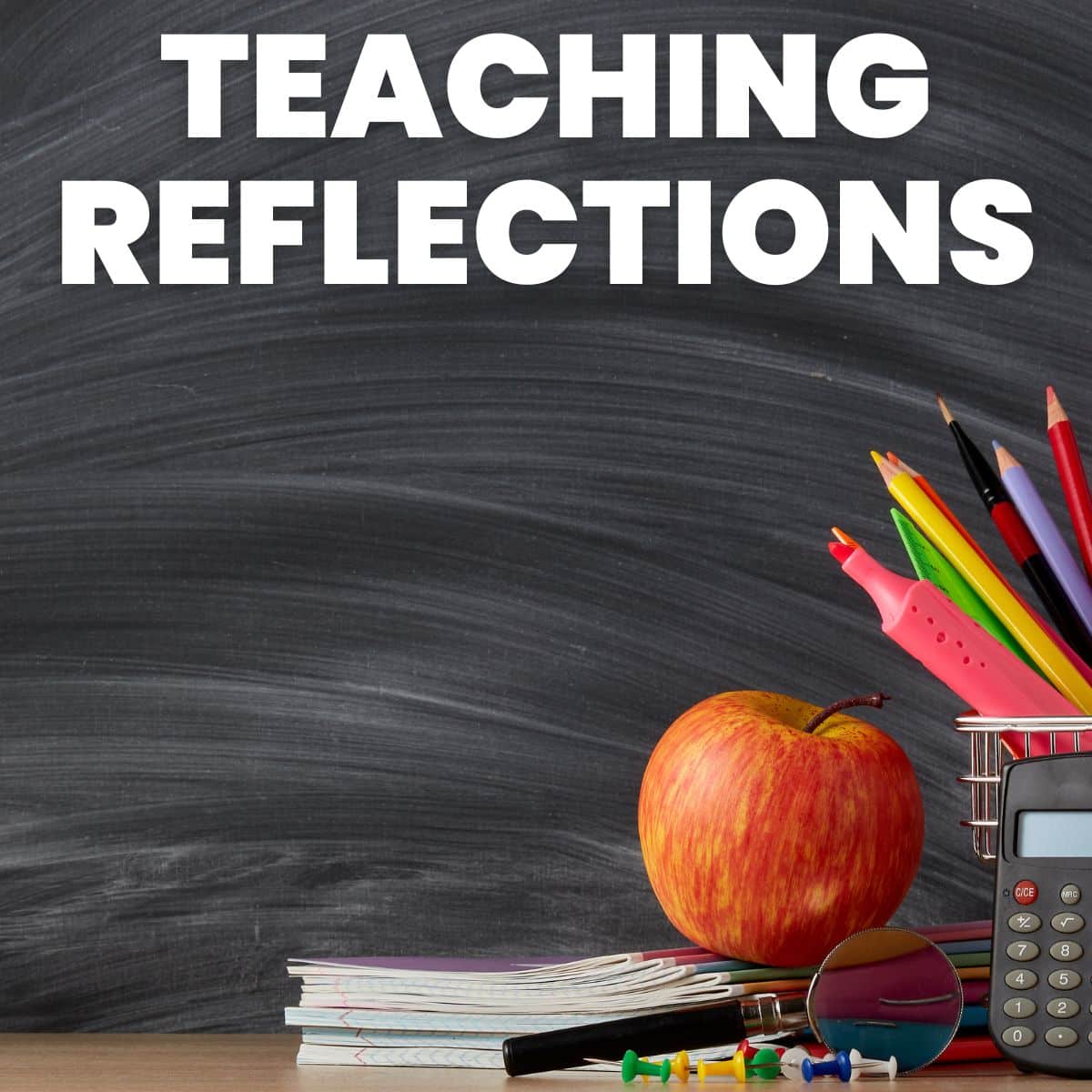
Love how you brought it all back to how reflecting on what you have done is important. Lesson plans are a living document and are constantly changing.
The key to that is writing down those things so that next year when you teach it again, you can remember the "meat" and add in those important points as well.
Loved your blog post. It brought back what is was like to be a first year again. I go back after maternity leave next month and I'm sure I'll feel like a beginner again. Don't forget to incorporate some rest time for yourself else you'll burn out. Good luck.